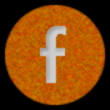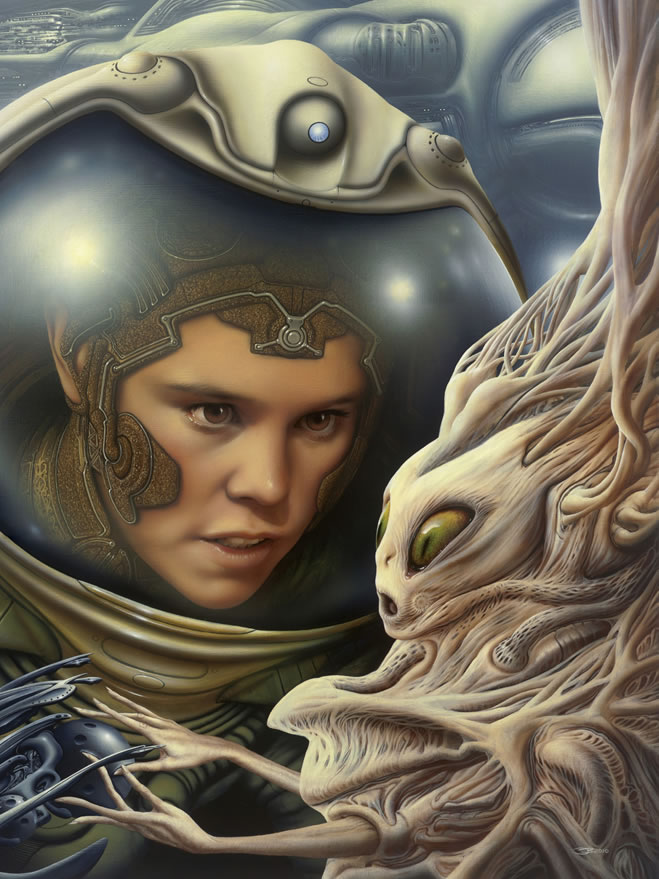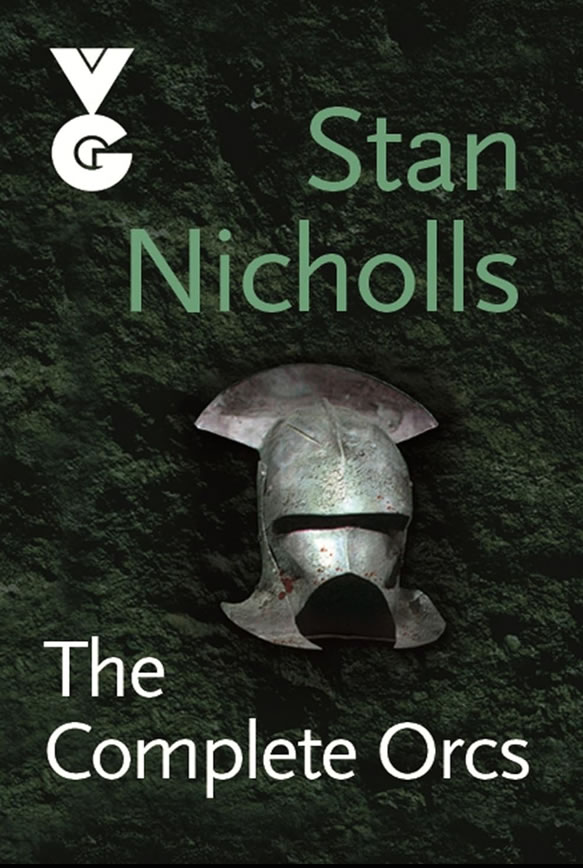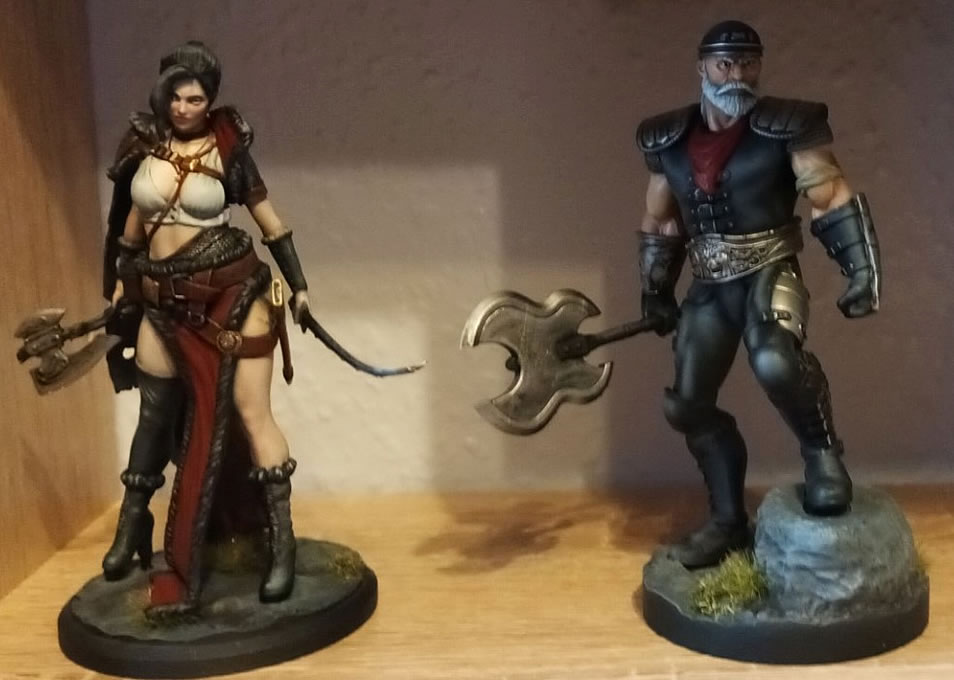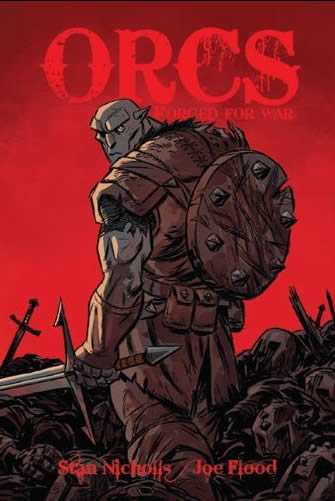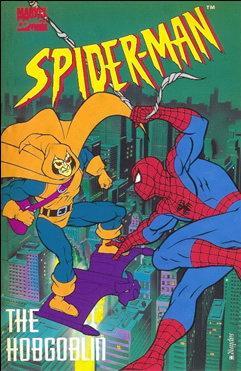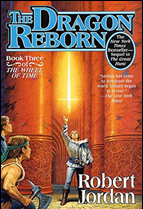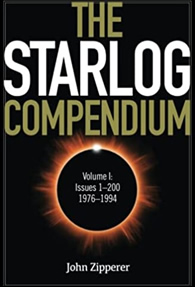

ORCS IN A NEW MEDIUM
I was surprised and delighted to be presented with these coasters and collector cards, drawn from my Orcs series, by gifted artist Ky Crout. Ky's based these on various of the book jackets, and character studies by Chris (Fangorn) Baker. I never cease to be impressed by the amazing talent out there, and to be grateful for the generosity of readers.

Here's the source for the above (US cover of the first Orcs trilogy):




PHOTOGRAPH OF THE MONTH (67)
A garden reading nook, for what passes for Summer here in the UK

You can view all the previous Photographs of the Month in the Photo Gallery.

STILL CREEPY AFTER ALL THESE YEARS

A couple of weeks ago someone kindly got in touch to tell me they'd just bought a copy of Warren Magazine's Creepy issue 19 (March 1968), pictured above, in which they spotted a letter by me. I'd completely forgotten about this. I was just a kid at the time, you understand, and looking at it now I'm struck by what a self-opinionated little know-all I was.


The glaring scrambled sentence in the above was down to the magazine, BTW, not me.
THUNDERBIRDS WERE GO
I just unearthed some flyers from the 1996 tour I undertook with Gerry Anderson for the biography.




As stated in the bibliography section of this website:
This project was born of tragedy. Simon Archer was a local radio presenter and a huge fan of Gerry Anderson’s TV series. Gerry agreed to Simon writing his authorised biography, but shortly after he began, Simon lost his life in a car accident. I worked from Simon’s notes, coupled with my own interviews with Gerry, and turned in the book against what had become a pretty tight deadline. There was another Gerry Anderson authorised biography a couple of years later by another writer who incorporated elements of my work and Simon’s. I wasn’t involved in that.
AND IN THE SAME BOX …
… this copy of Comic World magazine that covered the launch of the graphic novel version of David Gemmell's Legend, which I adapted. A pity they misspelt Gemmell's name on the cover. But just so I wouldn't feel left out they did the same with my name inside. Nice coverage though, to be fair.

ON THE SUBJECT OF GRAPHIC NOVELS

A correspondent alerted me to this YouTube channel containing a page by page examination of the graphic novels of David Gemmell's Legend and Wolf in Shadow - which I adapted and Chris (Fangorn) Baker illustrated - with commentary (in French). You can find it here.
A BLATANT REMINDER
That my story Dreaming in Babylon can be found in the current issue of e-zine ParSec. Details here.
PHOTOGRAPH OF THE MONTH (66)
I took this on a visit to Dubai in 2011. It struck me how the city resembled a science fiction pulp magazine cover.

You can find all the previous Photographs of the Month in the Photo Gallery.

PARSEC 10 COVER REVEAL
I mentioned in last month's update that I had a story, Dreaming in Babylon, in issue 10 of ParSec magazine, which was published on 26th April. Here's the completed cover, with a fine piece of artwork by Jim Burns. You can find out more about ParSec, includingordering information, here.

And for a limited period there's a promotional discount offer, explained here by publishers PS Publishing
25% DISCOUNT!
“Just to refresh everyone, ParSec is our digital magazine featuring the latest fiction from established writers alongside the best new stories from emerging talents and debut authors. It includes on-point articles and regular columns, exploring genre fiction in all its forms, and interviews with leading authors and artists. Plus insightful and informative book reviews on current titles and imminent releases from publishers big and small. This magazine sports a lot of heft, considering its 3 short years of existence.
“We've reached out to a couple of reviewers to promote the magazine and the calibre of content on offer within each issue, and with the help of Matt Cavanagh at Runalong The Shelves here we have a blog tour of ParSe.
“If you start with this link, you'll follow the tour below:
• Mark’s review of issue #1 at Fantasy Book Nerd, which links to
• Jonathan’s review of issue #2 at Fantasy Hive, which links to
• Alex’s review of issue #3 at Spells & Spaceships, which links to
• Kayleigh’s review of issue #4 at Happy Goat Horror, which links to
• Isabelle’s review of issue #5 at The Shaggy Shepherd, which links to
• Kiki’s review of issue #6 at KB Book Reviews, which links to
• Matt’s review of issue #9 at Runalong The Shelves
“Each review includes a discount code for 25% off ParSec issues #1 - #9. Just copy and paste the discount code at the checkout and download for £4.49 each. Compatible with all e-readers.
“Now buckle up and begin!”

PHOTOGRAPH OF THE MONTH (65)
Spring, and the return of green.

All previous Photographs of the Month can be found in the Photo Gallery. I also regularly post photographs on my Facebook page.
Every monthly news update from 2008 to the present can be found in this site's archive here.

This illustration, by renowned sf artist Jim Burns, will appear on the cover of Parsec magazineissue 10, which I'm very pleased to say includes a story by me entitled Dreaming in Babylon. Parsec's rapidly grown into arguably the UK's best science fiction/fantasy magazine (I don't say that because I'm in it!) and you can find details here. Issue 10 appears later this month and the complete cover isn't available yet. I'll post it here next time.
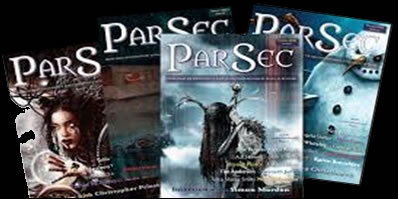
COMPLETE ORCS OFFER
For UK readers with Kindles: “The complete ORCS saga - containing all six novels and one short story - is perfect for fans of fast-paced fantasy action.”
The Kindle edition is now £14.99. Not bad for over 1600 pages. See here
FAVOURITE ARTISTS 11
Just one entry this month in my series of personal favourites that began in the June 2023 update, and which also runs regularly on my Facebook page.
Favourite Artists # 36
JON SULLIVAN (d.o.b. unknown)
I know practically nothing about painter and sculptor Jon Sullivan beyond the fact that he's South London based, that he did a lot of illustrations for the Warhammer 40K series, and that he produced a number of outstanding covers for fantasy and science fiction books. He's also very affable. In this digital age, when we know just about everything about almost everybody, it's kind of refreshing to come across someone who prefers to keep themself to themself. It allows their work to speak for itself.
The first illustration here is City Wars, and Devil in Green is below that. Both are oil on board.
Disclaimer: Jon produced the covers for the American editions of three of my books, which are among the best I've been fortunate enough to have. But he'd still be in this series if he hadn't.
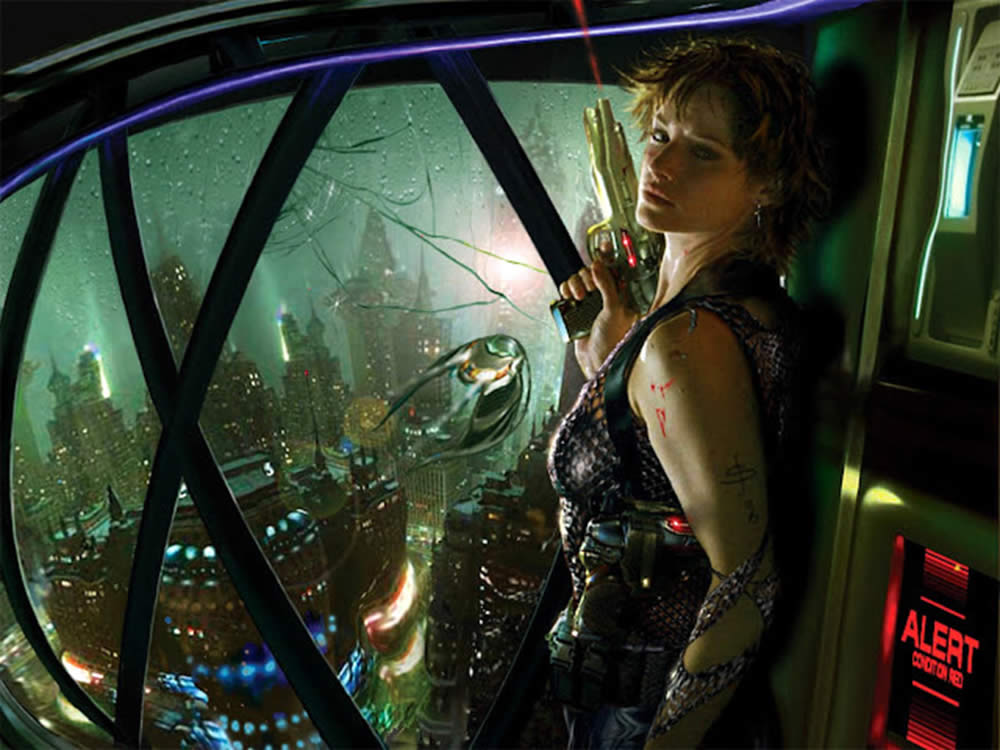

Jon Sullivan provided the covers for the American covers of my Quicksilver trilogy
(re-named the Dreamtime trilogy in the US):
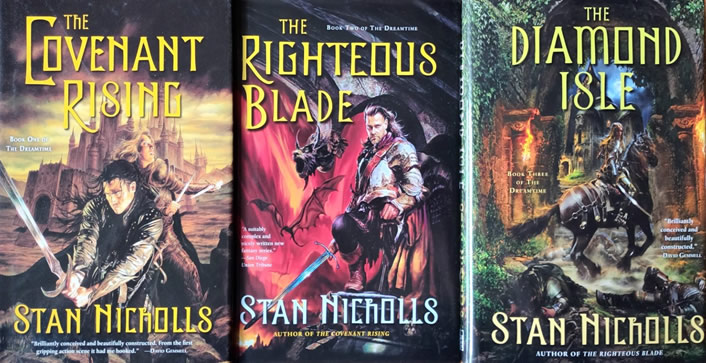
PHOTOGRAPH OF THE MONTH (64)
The Cotswolds this month. Bourton-on-the-Water, in the county of Gloucestershire.
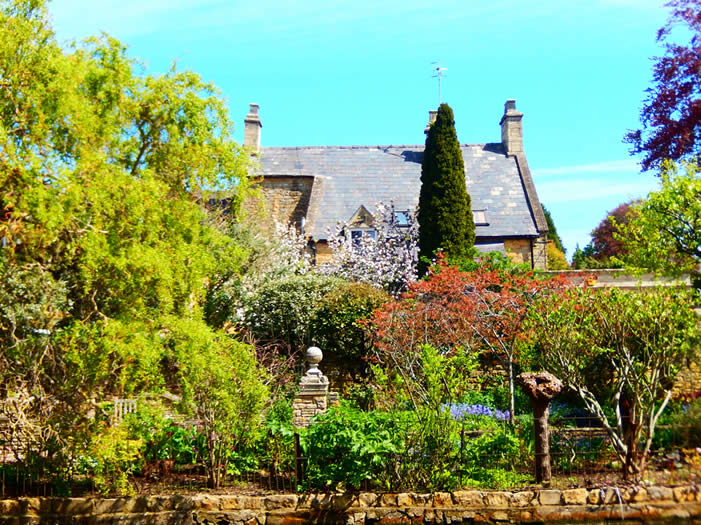
You can see all my Photographs of the Month, going back to January 2019, here. I also regularly post photos on my Facebook page.

WELCOME ADDITIONS TO ANY GEEK HOUSEHOLD
We recently received these beautifully made figurines of David Gemmell characters Jianna and Druss, courtesy of gifted modeller Simon Cook. Simon is one of the stalwart moderators at David Gemmell Fans, the leading Facebook group dedicated to the legendary fantasy author. If Gemmell's fiction appeals to you I highly recommend this knowledgeable, convivial group.
FAVOURITE ARTISTS 10
Here's the continuation of the series of personal favourites I began with the June 2023 update (scroll down to find it) and which also runs regularly on
my Facebook page.
Favourite Artists # 32
RYAN SOOK (d.o.b. Unknown).
The first illustration below is the cover artwork for Action Comics no 1004 (December 2018), which I think has genuine charm. The second is entitled Lois & Clark: Fireworks!, a print taken from a VS System Trading card game. I'm also including the complete Action Comics cover the first illustration is taken from.
San Jose, California born Ryan Sook’s first professional commission was for DC’s Challengers of the Unknown number 15 (1998). He has worked for most of the major comicbook publishers and his many credits, for both interior and cover artwork, includes depictions of Batman, Buffy the Vampire Slayer, the Flash, Green Lantern, Hawkman, Hellboy, Jonah Hex, The Legion of Super-Heroes, the Spectre, Spider-Man, Superman and Thor.
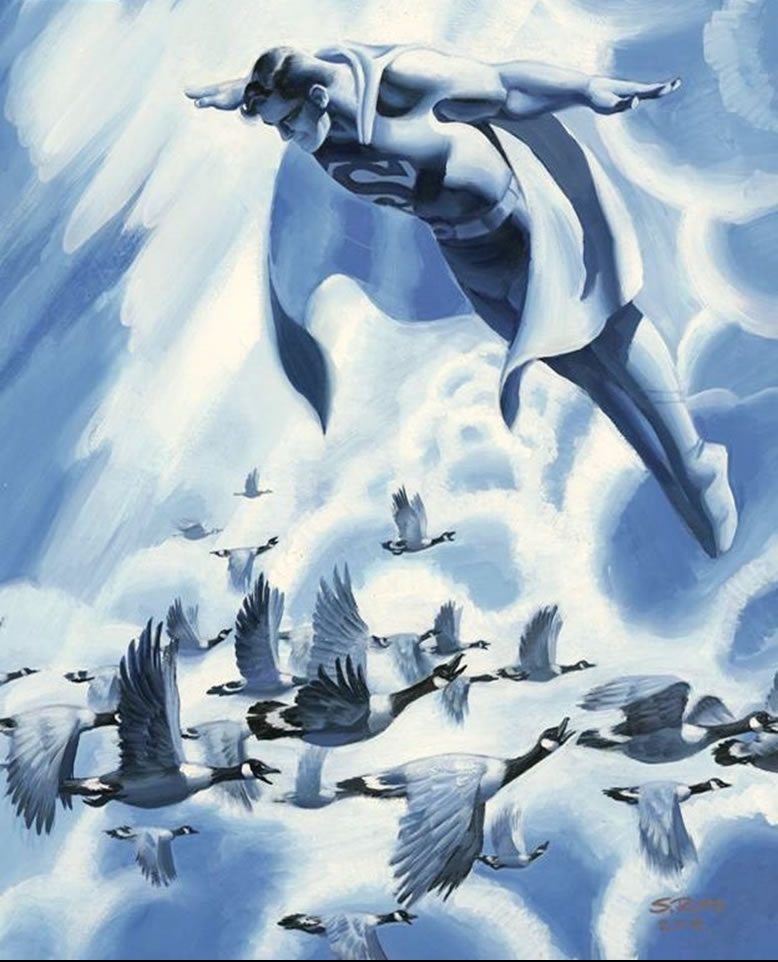
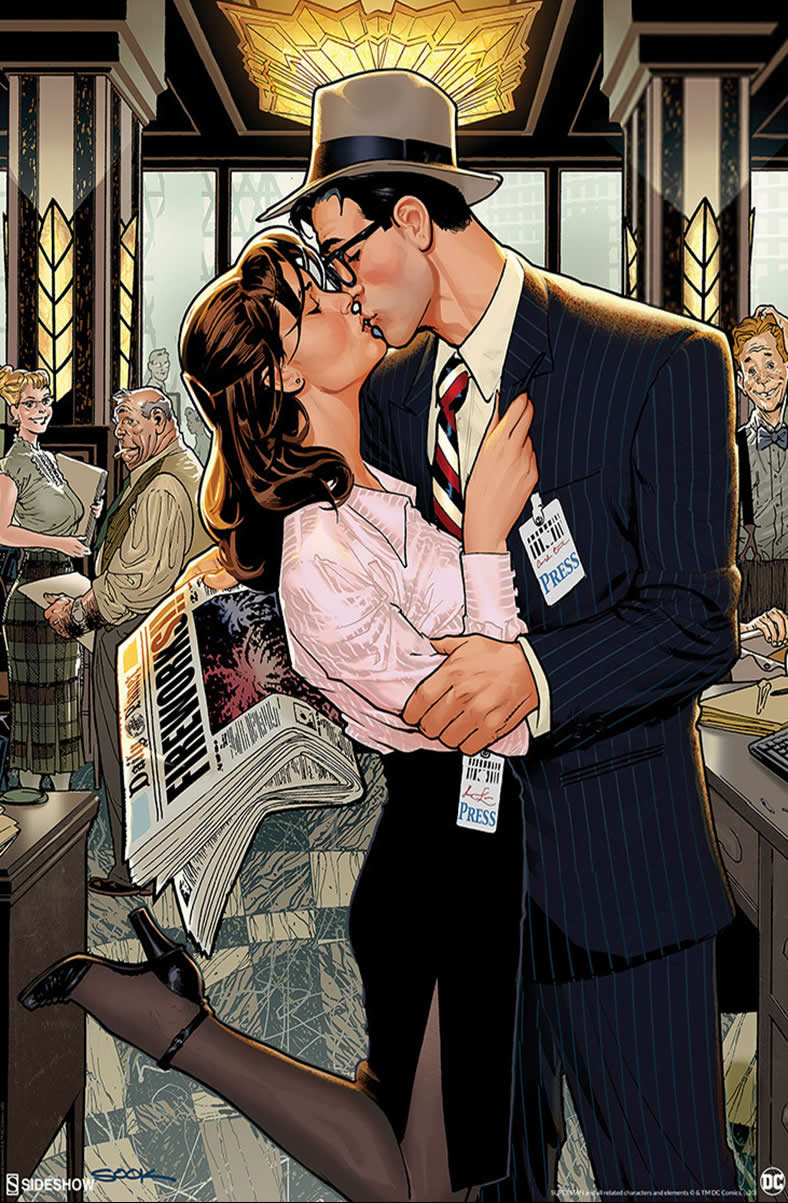
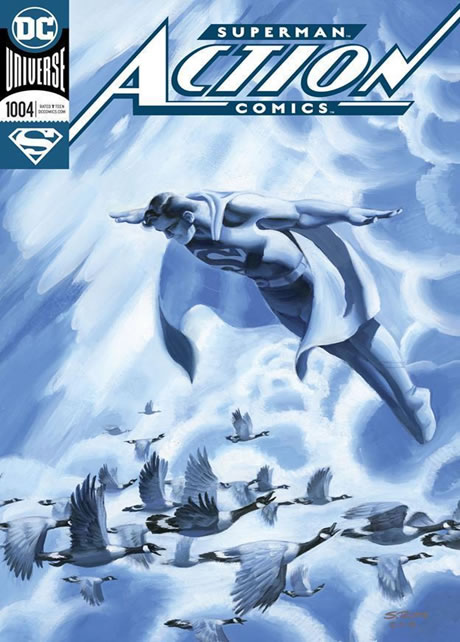
Favourite Artists # 33
DON (SOUTHAM) LAWRENCE (1928-2003).
The first illustration below is The Fall of Samaria. The second is Pirates.
After national service in the army, Don Lawrence studied art at Borough Polytechnic (since renamed London South Bank University) but didn't pass his final exams. He found work with Mick Anglo, who ran a studio packaging comic strips for publishes. During his four years with Anglo Lawrence drew various western strips and Marvelman. Moving on to Odhams and Amalgamated Press (later Fleetway) he drew a variety of historical adventure strips, including Maroc the Mighty, written by Michael Moorcock.
In 1965 Lawrence began his most celebrated strip, The Rise and Fall of the Trigon Empire, for the titles Ranger and Look and Learn, which ran until 1976. That year, at a London comicbook convention, he learned that The Trigon Empire was being widely syndicated abroad, but in a scenario all too familiar to freelance illustrators, his publisher refused to pay him any royalties. He quit and took employment with several Dutch publishers. During this period he produced another notable strip, Storm, in partnership with writer Philip Dunn. He also drew strips for TV Century 21 and Mayfair magazine, among others.
In 1995 an unsuccessful cataract operation caused him to lose sight in his right eye. He was later diagnosed with emphysema and died from the condition at age 75. Lawrence garnered a number of awards, including 1980's Society of Illustration Lifetime Achievement Award.
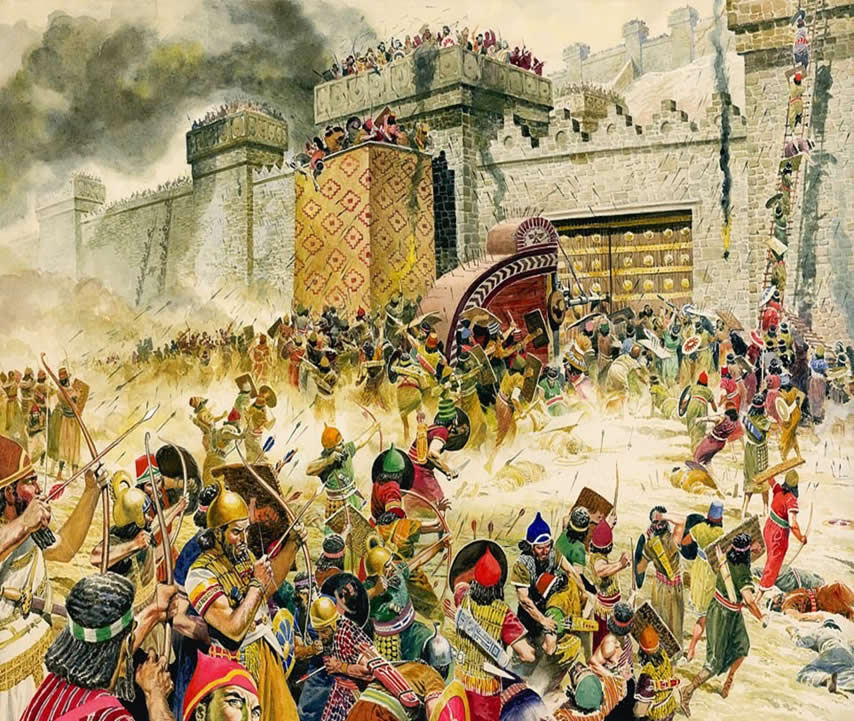

Favourite Artists # 34
MICHAEL ENGLISH (1941-2009).
The first illustration is Heinz (1970). CIA vs UFO (1967), a poster advertising a Pink Floyd gig at London's UFO club, is the second.
The son of an RAF officer, Oxfordshire born Michael English's childhood was spent in a number of different UK locations depending on his father's postings. Fascinated by drawing from an early age, he entered Ealing College of Art in 1962. At the dawn of “swinging London” in 1966 he created murals for several iconic shops of the period, including King's Road's Granny Takes a Trip. In 1967 he was co-founder of graphic design company Hapshash and the Coloured Coat, where he produced poster art for bands and music festivals. He also provided illustrations for underground magazines International Times and Oz. In the 1970s he moved from so called Pop Art to Hyper Realist paintings that in the vernacular of the time sought to “make the everyday sensational”. He was a pioneer in the use of the air brush in these “food paintings”. Later in life he designed sets of postage stamps featuring London buses (2001) and vintage motorcycles (2004).
As I was a member of Tottenham Court Road's UFO club, and having attended the Pink Floyd concert in question, I couldn't resist using the poster.
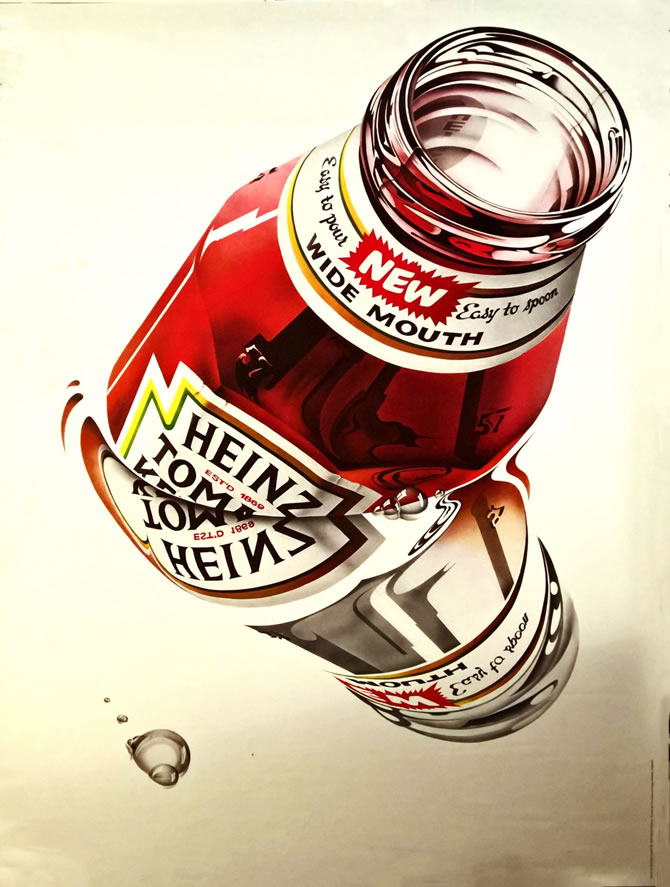
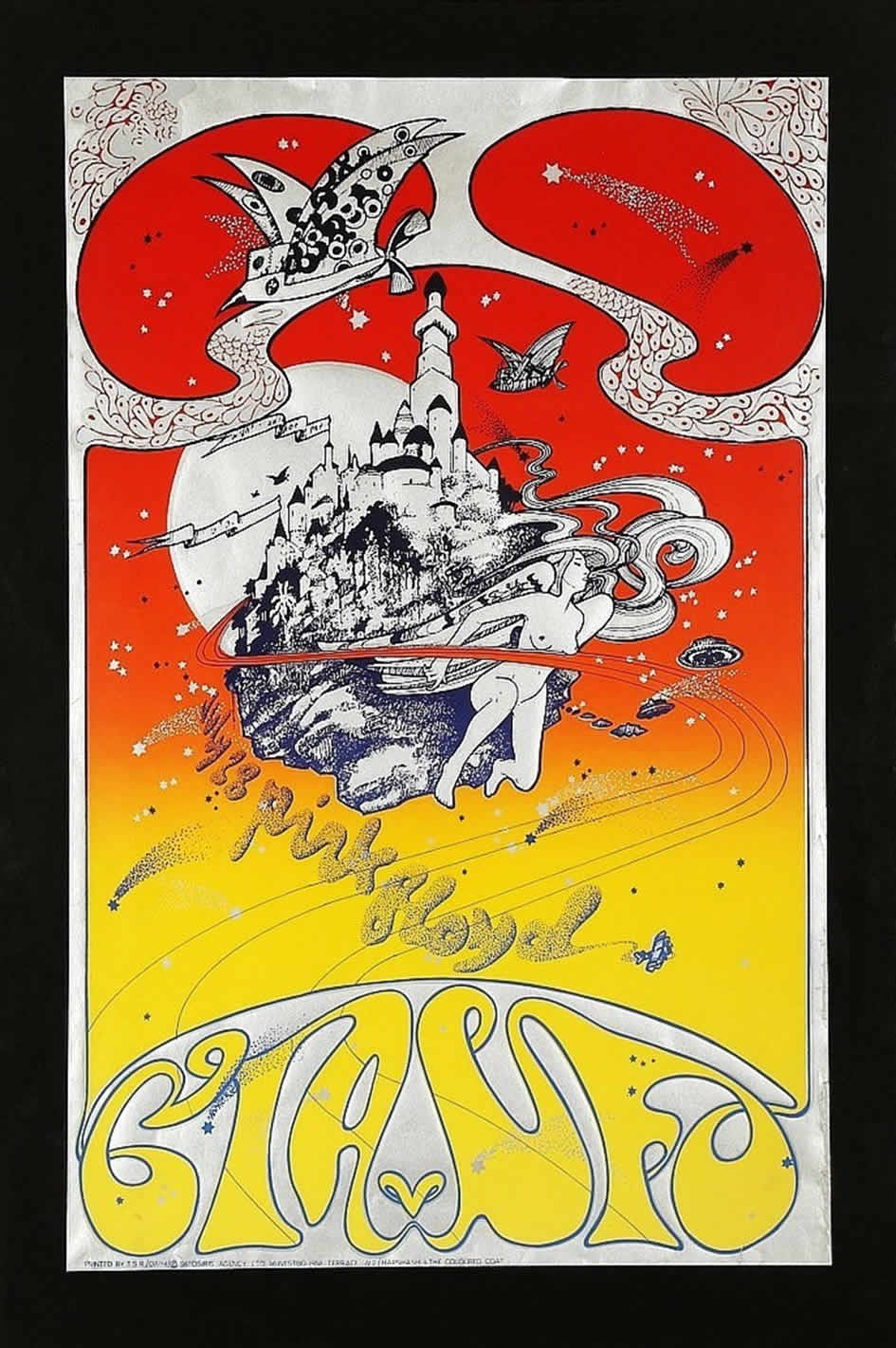
Favourite Artists # 35
JOSE “PEPE” GONZALEZ (1939-2009).
The first illustration is She, the Vedette. James Dean is the second.
Spanish comic book artist Jose Gonzalez began his career at age 17, working for the publisher Editorial Toray on the titles Brigitte and Rosas Blancas. When he was 21 he joined art agency Seleccones Illustrades, which led to commissions from UK's Fleetway, mostly on romance comics. He is best known for his work on Warren Publishing's Vampirella, starting with issue 12 in 1971 and continuing until issue 34, producing 53 strips featuring the character. He won the Warren Award (for best story art) in 1971 and 1974. Warren also reprinted Gonzalez's three part series Herma, which first appeared in issues 8 to 10 of the magazine 1984.
No longer being a libidinous teenager I find Vampirella a little too cheesecake for my tastes, despite its artistry, and prefer Gonzalez's other work, as here.


PHOTOGRAPH OF THE MONTH (63)
The first flush of Spring and life returning.

A REMINDER …
… that this website has more departments than you might be aware of. They can all be accessed via the menu at the top left of the screen. Or directly via these links:
My biography
A bibliography of my books, in these sections:
The Orcs series
The Quicksilver trilogy
The Nightshade Chronicles trilogy
Other titles
Gothique and Stardock magazines
A photo gallery in these sections:
Photograph of the Month
Conventions and other events
The David Gemmell Awards For Fantasy 2009-2018
New Archive going back to 2015
You'll also find a way to contact me in the menu.
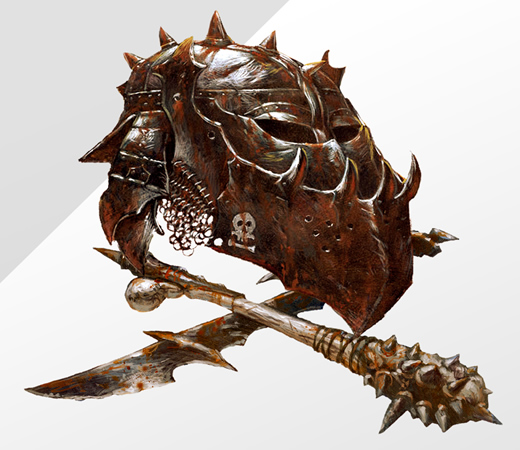
Artwork by Didier Graffet

EPHEMERA
From the archives. I think this flyer, distributed at conventions, is from around 1969. If you want to know more about Gothique and Stardock – the fanzines I and others published when we were mere striplings – there's a section of this website devoted to them, here.
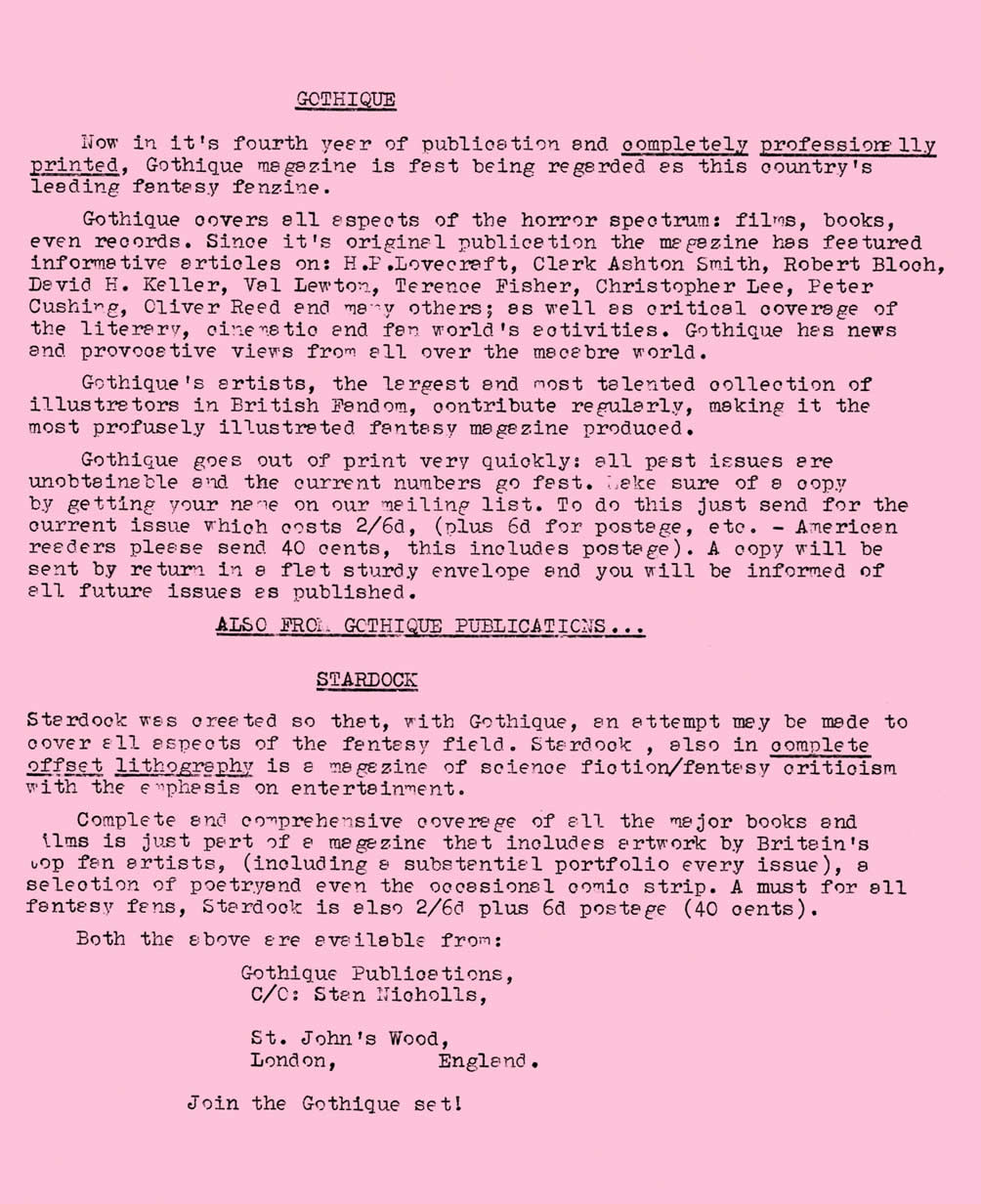
They might have been a bit crudely produced and verging on embarrassing in their youthful innocence, but I was proud of them.

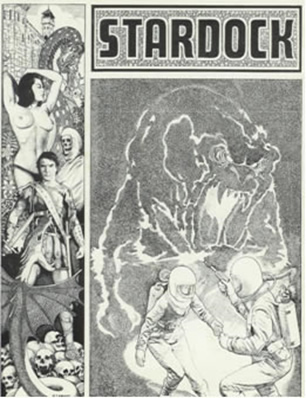
Here's another announcement, aimed at the nascent UK comics fandom and published somewhere I don't recall. I reckon it must be from 1972 or 73. Frankly, I don't remember very much about all this except that Fantascope, the proposed magazine, never happened. The British Amateur Fantasy Magazines Association (BAFMA), intended to represent the plethora of fanzines being published at that time and maybe gaining them wider distribution, never happened either, despite some impressive names on that committee, myself aside. Another might-have-been, I suppose.
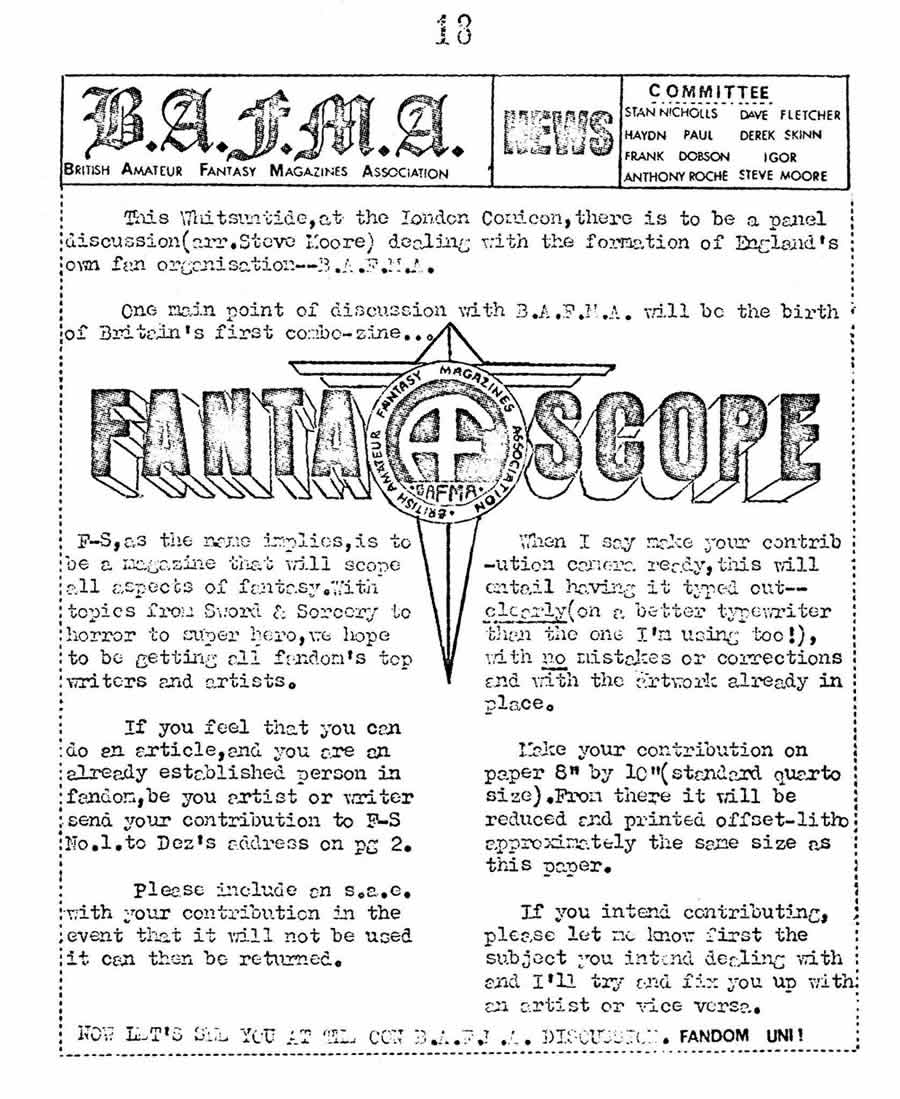
FAVOURITE ARTISTS 9
Continuing the series I began here with the June 2023 update - scroll down for that - and which also runs on my Facebook page, here's the latest batch. Just two this month.
Favourite Artists # 30
JOHN BRIAN FRANCIS GAUGHAN (1930-1985).
The artwork here is from the cover of Galaxy magazine no 93 (vol 21, no 3), February 1963. The cover for Michael Moorcock's Stormbringer (Lancer Books, 1967) is below.
Jack Gaughan, his preferred working name, was a prolific contributor to both professional and fan publications. He made his first professional sale while still a student at the Dayton Art Institute, and in the1950s took up illustrating full-time. His covers and interior art appeared in Galaxy (where he was Art Editor for three years), If, The Magazine of Fantasy and Science Fiction, Asimov's Science Fiction Magazine and a number of other titles. He also worked for book publishers, including Ace Books, Daw Books and Pyramid Books. Gaughan provided the covers for Ace Books' unauthorised editions of Tolkien's Lord of the Rings trilogy (1965).
A contributor of artwork to many fanzines throughout his career, he is the only illustrator to have won both Best Fan Artist and Best Professional Artist Hugo Awards in the same year (1967). He won the Best Professional Artist accolade again in 1968 and 1969. In his memory the New England Science Fiction Association established the Jack Gaughan Award, for best emerging sf illustrator.
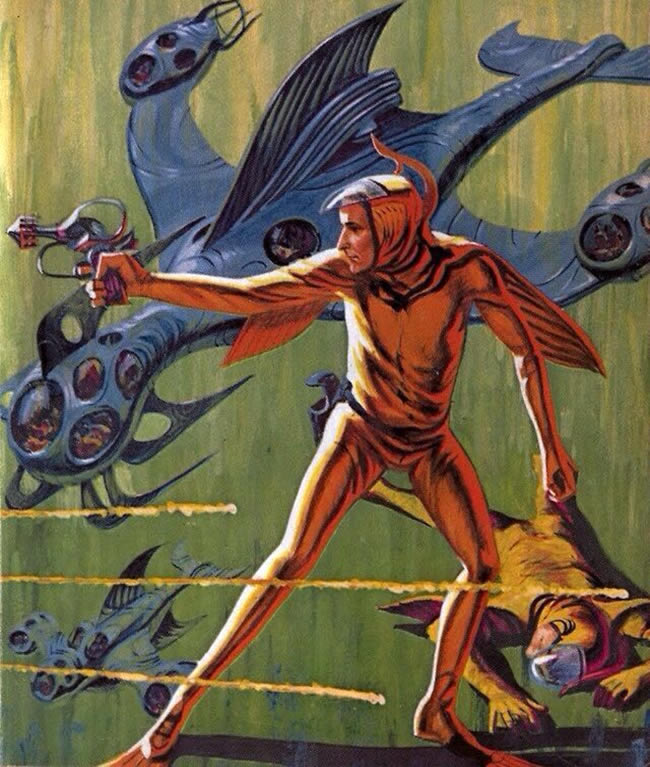
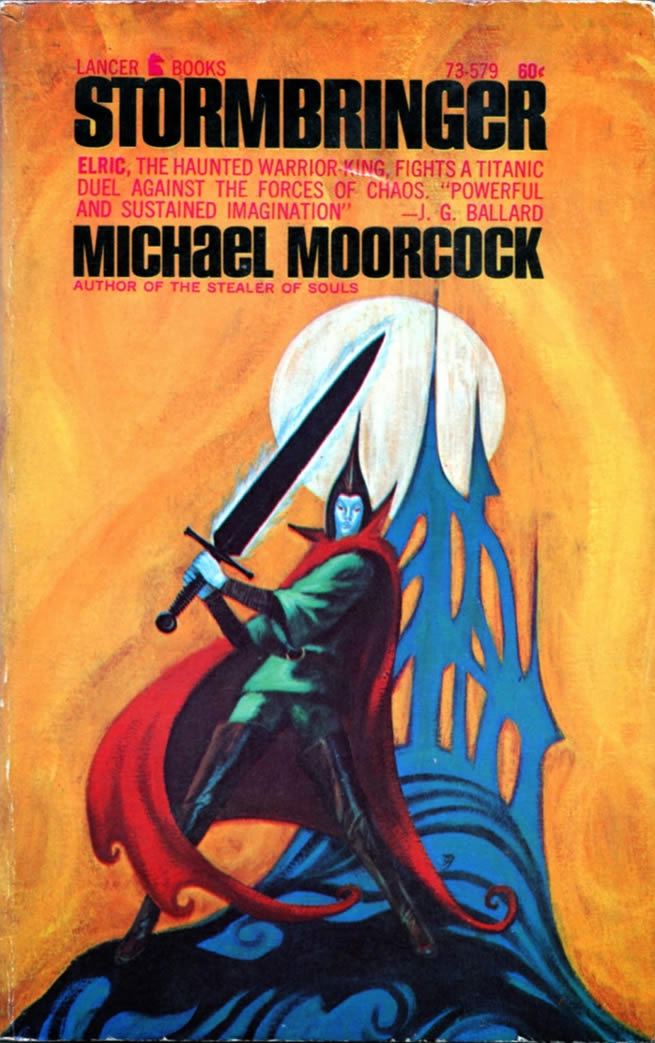
Favourite Artists # 31
BRUCE PENNINGTON (b 1944).
The artwork here is from the cover of Gene Wolfe's The Shadow of the Torturer (Arrow 1981), and that for Clark Ashton Smith’s Lost Worlds Volume 2 (Panther 1975) is below.
Having trained at Beckenham School of Art and Bromley’s Ravensbourne College of Art, Bruce Pennington began gaining commercial art commissions in the mid-60’s. His association with the sf/fantasy fields took off in 1967 with his cover for Robert Heinlein’s Stranger in a Strange Land. Working for publishers including Ballantine Books, Corgi, New English Library and Sphere, he provided covers for books by Brian Aldiss, Poul Anderson, Harry Harrison, M. John Harrison and A.E. Van Vogt, among others. Perhaps his best known early cover was for the UK paperback edition of Frank Herbert’s Dune (NEL, 1968).
He’s had several compilations of his artwork published, principally Eschatus (1976), inspired by Nostradamus’ prophecies, and Ultraterranium (1991) both from Paper Tiger Books. A number of his illustrations have been used as album covers by various bands.
Since 1990 Pennington has concentrated on personal art and private commissions. His first exhibition was mounted at London’s Atlantis Bookshop in August 2011.
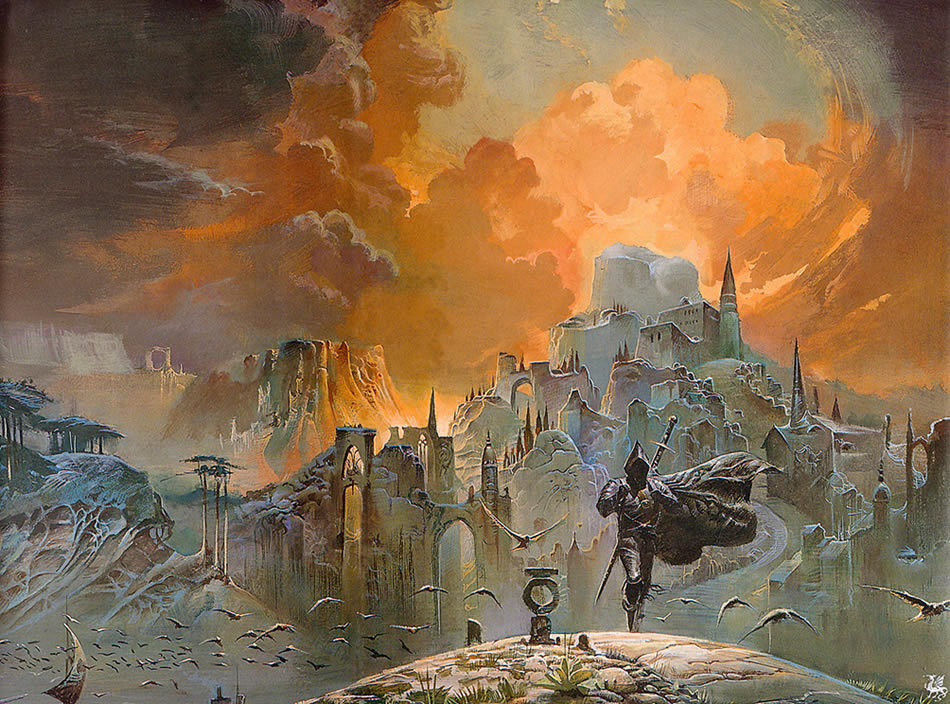
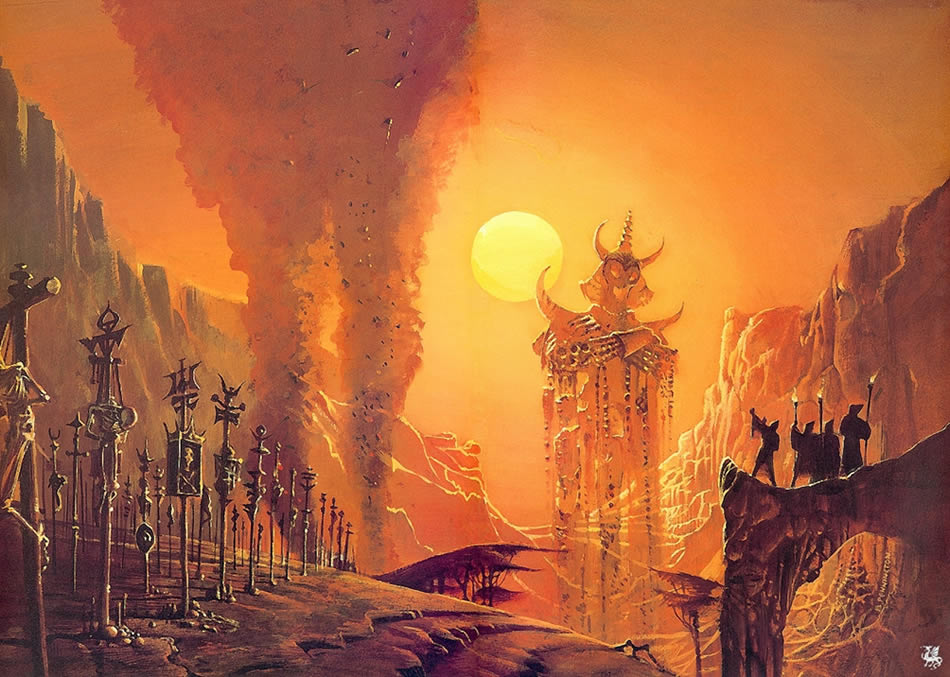
PHOTOGRAPH OF THE MONTH (62)
Herons are notorious for being easily spooked, and I was lucky to get reasonably close to this one on a cold February morning.

You can see all my Photographs of the Month, going back to January 2019, here.

25 YEARS OF ORCING
In another of those startling realisations that time passes faster than a speeding bullet we've arrived at the 25th anniversary of the publication of the first book in my Orcs series. It was in February 1999, to be exact, when Bodyguard of Lightning, volume one of the Orcs: First Blood trilogy, saw the light of day. Here's the announcement from a trade catalogue my publisher put out at the time:
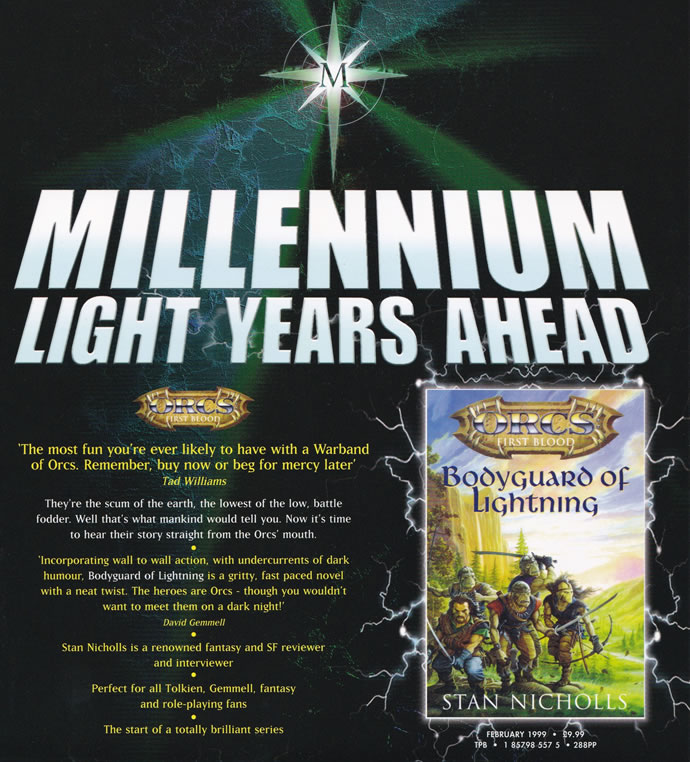
The publisher, The Orion Group, decided to launch a new sf/fantasy imprint, Millennium, with a raft of titles which, apart from mine, included books by John Marco, Venor Vinge, John Barnes, Darren O'Shaughnessy, James Lovegrove and Eric Brown. In the event, Orion bought the venerable publisher Gollancz shortly after and dropped the Millennium imprint. Bodyguard of Lightning was the only Orcs book to bear the Millennium logo; all the rest were published as from Gollancz. For the record, here's the back and front of that launch catalogue:

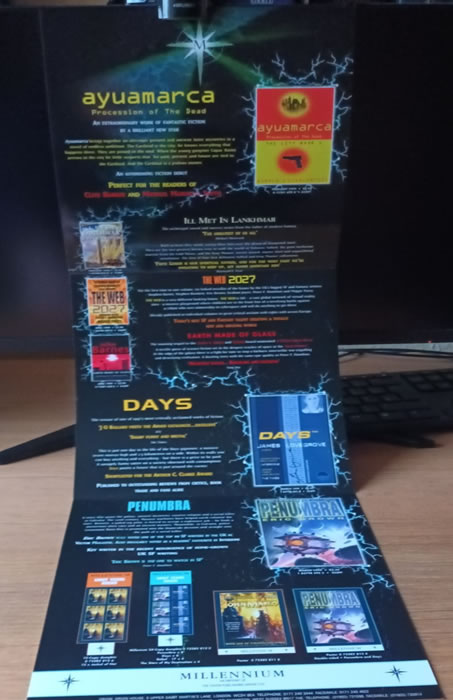
I'm proud of the fact that the initial trilogy achieved worldwide sales in excess of a million copies; and that it and the sequel trilogy, Orcs: Bad Blood, are still in print and continue to steadily sell. The series also spawned a collection, Orcs: Tales of Maras-Dantia (NewCon Press)and a graphic novel, Orcs: Forged For War (First Second Books), both of which are prequels. I've written quite a few non-Orcs books but I guess this series is what I'm perceived to be most closely associated with. I'm content with that and grateful for it.
There's an extensive section devoted to the Orcs series on this website. You can reach it via the above menu or directly here.
A BOOK PROMOTION MIGHT-HAVE-BEEN
Trying to bring some kind of order to my clippings files, I came across this piece. As it centres on author Christopher Fowler, sadly lost to us in 2023, it seems appropriate to share it in his memory. When I wrote this the best we had was dial-up and the Internet was in its infancy – the information tsunami had yet to hit. It's interesting to imagine a timeline where it didn't and Chris' idea took hold.
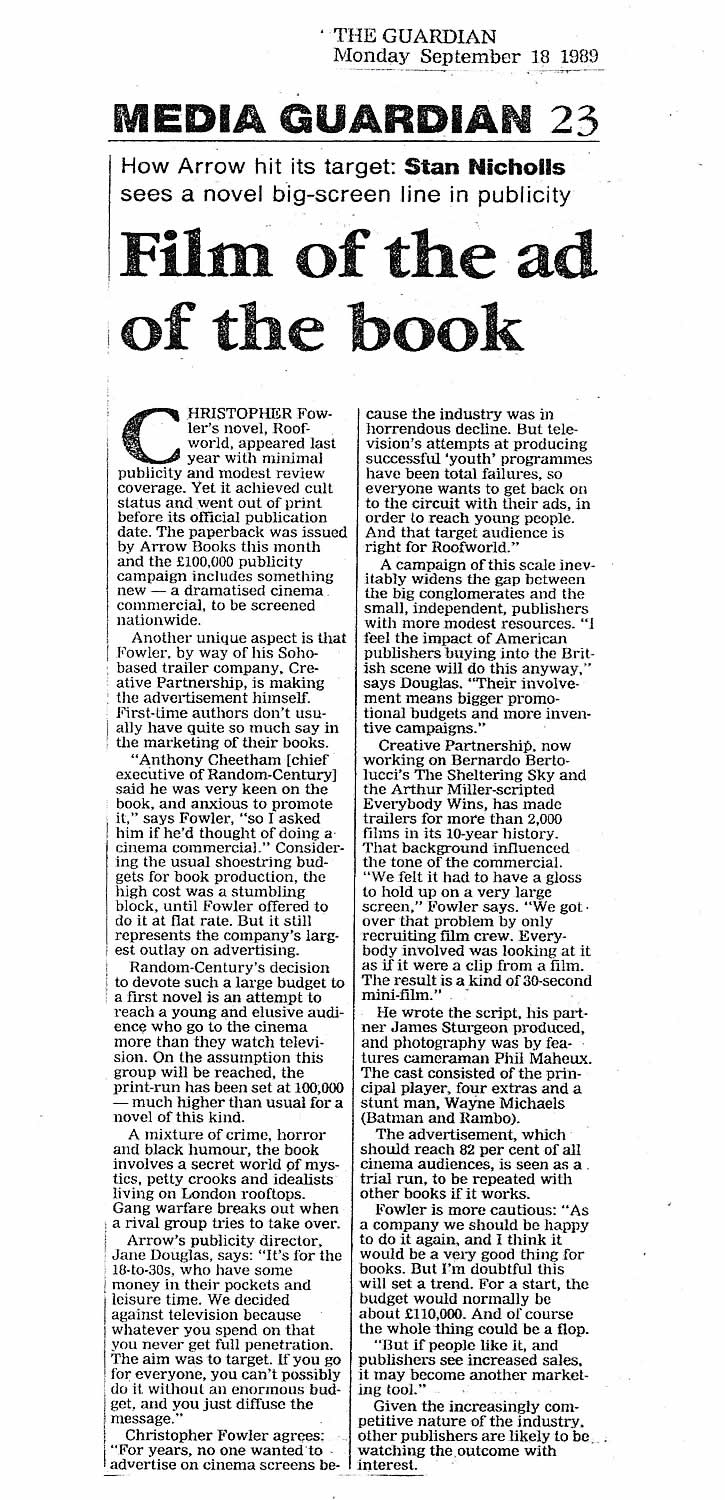
FAVOURITE ARTISTS 8
Here are the next four of my Favourite Artists, a monthly series I began back in the June update (that you can see by scrolling down) and which also runs on my Facebook page.
Favourite Artists # 26
RENE (FRANCOIS GHISLAIN) MAGRITTE (1898-1967).
Principally associated with the surrealist movement, René Magritte was born in Lessines, part of Belgium's Hainaut province. Showing early talent, he began to take drawing lessons in 1910. In 1912 his mother, Régina, committed suicide by drowning, following several previous attempts. It's said that when her body was recovered her dress was covering her face, and there's a theory that this is why several of René's later paintings depict people with their faces obscured by cloth.
Magritte's earliest paintings, from around 1915, were in the Impressionism mode. Those he produced between roughly1918 and 1924 were inspired by Futurism and Cubism. Following just under a year's service in the Belgian infantry (1920-21) he worked as a draughtsman in a wallpaper factory, and also designed advertisements and posters.
1926 saw his first surrealist painting, Le jockey perdu ('The Lost Jockey'). His first solo exhibition took place in Brussels the next year and was badly received by critics. Deflated by that experience he moved to Paris, where he became friends with Andre Breton and was soon a leading member of the surrealist grouping.
Magritte stayed in Brussels during World War II's German occupation. In the austere years after the war he supported himself by producing fake works attributed to other artists, notably Picasso, and conspired with others, including fellow surrealist artist Marcel Marien, to print forged banknotes.
The painting here is The Lovers II. Another example of Magritte's work, Time Transfixed, is below.
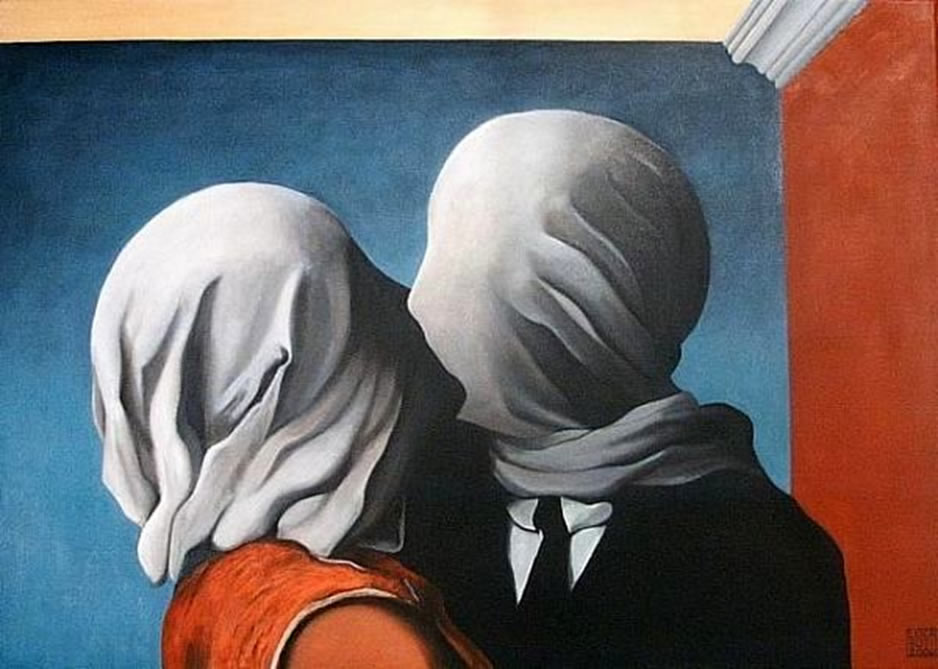
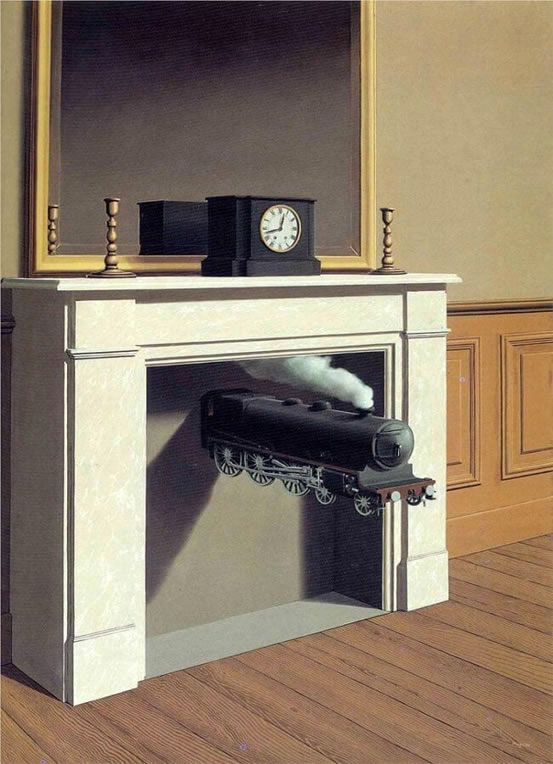
Favourite Artists # 27
EDWARD DANIEL CARTIER (1914-2008).
Edd Cartier, as he was known professionally, was born in New Jersey and studied at Brooklyn's Pratt Institute. Following his graduation in 1936 he began contributing artwork to pulp magazines including Astounding Science Fiction, Unknown, Doc Savage Magazine, The Shadow, Planet Stories and Fantastic Adventures. Serving in World War II he was badly wounded during the Battle of the Bulge. Once recovered, and back in the United States, he returned to the Pratt Institute, earning a Bachelor of Fine Arts degree in 1953. He continued working for the pulps, principally Astounding, as well as Gnome Press and Fantasy Press.
As providing illustrations for pulps and small presses was lowly paid, Cartier found employment as a draughtsman with an engineering company, followed by 25 years working as Art Director for a New Jersey printing machinery manufacturer. He carried on producing artwork for magazines and book jackets on the side. Edd Cartier died at age 94 on Christmas Day 2008.
He was presented with a World Fantasy Lifetime Achievement Award in 1992.
The illustration here, from 1940, is pen and ink on board. An interior illustration from Unknown magazine is below.
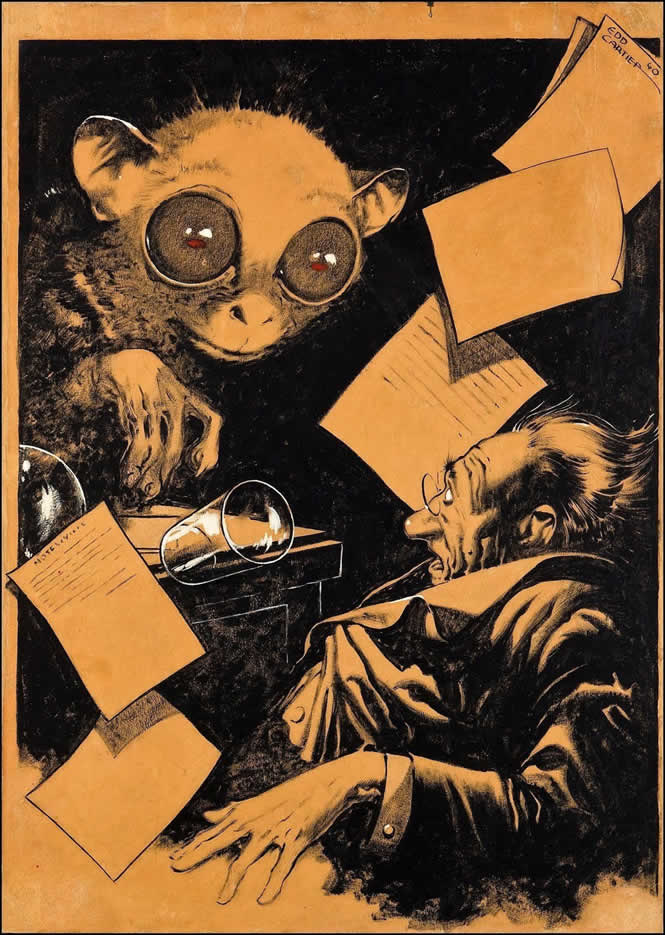
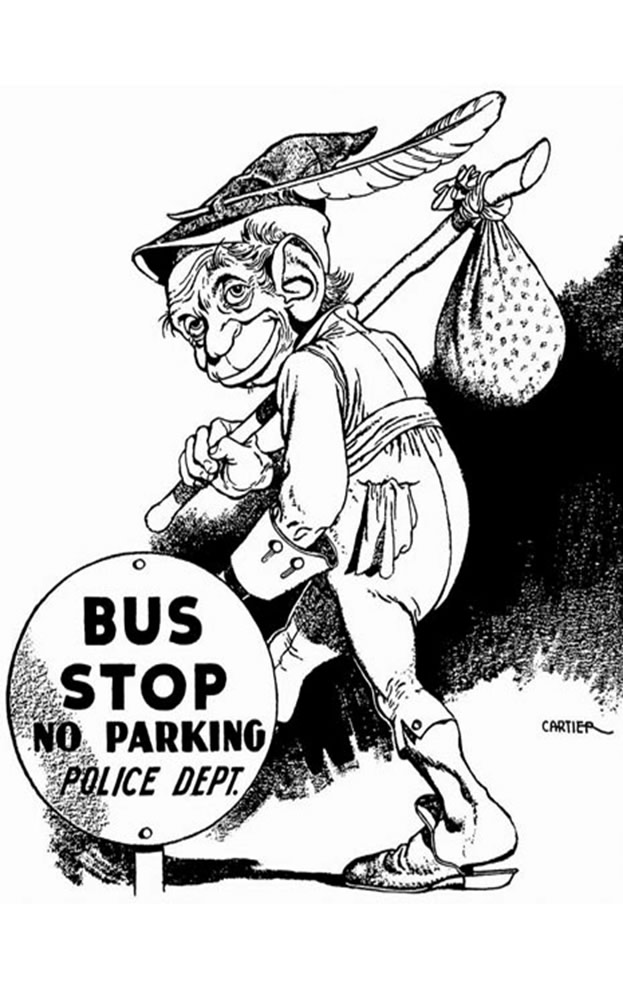
Favourite Artists # 28
GERARD QUINN (1927-2015).
Belfast born Quinn was a prolific contributor of artwork to British science fiction magazines from the early 1950s to the 1970s. Self-taught, he broke into the field when he submitted samples of his artwork on spec to editor John Carnell, who commissioned interior illustrations and covers from Quinn for his magazines New Worlds and Science Fantasy. Between 1952 and 1963 Quinn supplied the cover art for more than 75 issues of the magazines, and books including titles by Arthur C Clarke and Robert Heinlein. Much later he provided several covers for the magazines Vision of Tomorrow and Extro. In common with other artists, Quinn found it difficult making a living in the sf field and in the 1970s moved into the advertising industry, working for several agencies until his retirement.
The illustration here is Gerard Quinn's cover for New Worlds number 26, August 1954. His cover for Science Fantasy number 6 (Spring 1953) is below.
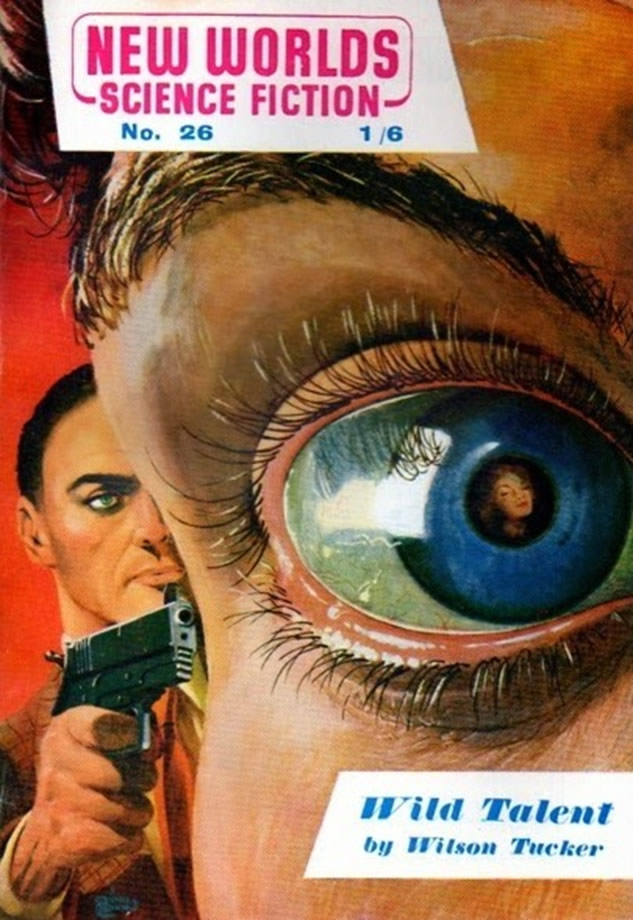

Favourite Artists #29
SIDNEY EDWARD PAGET (1860-1908).
Victorian artist Sidney Paget is best known for illustrating Conan Doyle's Sherlock Holmes stories in The Strand magazine. While studying at the Royal Academy of Arts he became friends with fellow student Alfred Morris Butler, who some scholars believe was the physical inspiration for Paget's later depiction of Dr Watson. Paget's interior illustrations appeared in The Illustrated London News, The Pall Mall Magazine, Pictorial World, The Graphic, The Sphere and famously, The Strand. He illustrated 37 Sherlock Holmes short stories and one of the Holmes novels, producing a total of 356 drawings. It was Paget who gave Holmes his deerstalker hat and Inverness cape, although neither are mentioned in any of Doyle's stories. His portrayal of Holmes has influenced how the character is depicted in literature, on stage and on screen to this day.
Paget developed a Mediastinal tumour, a rare condition that had no remedy in his day, and was only 47 when he died.
The illustration here is from the Sherlock Holmes story The Adventure of Silver Blaze (1892). Paget's portrait of Professor Moriarty, from The Final Problem (1893), is below.
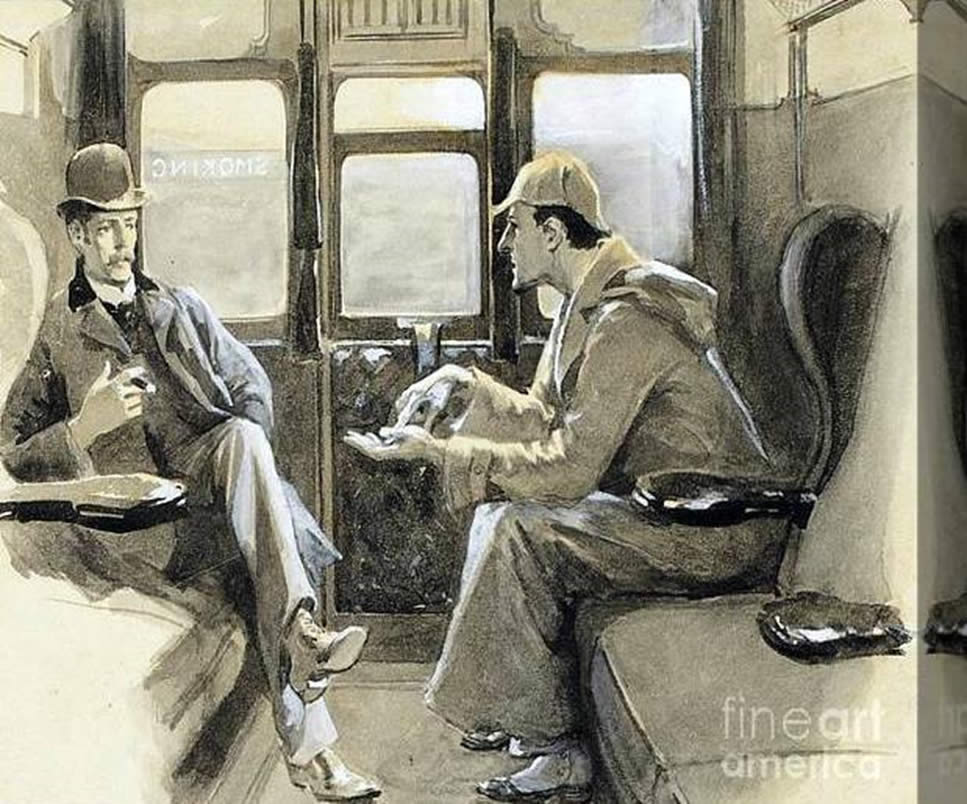
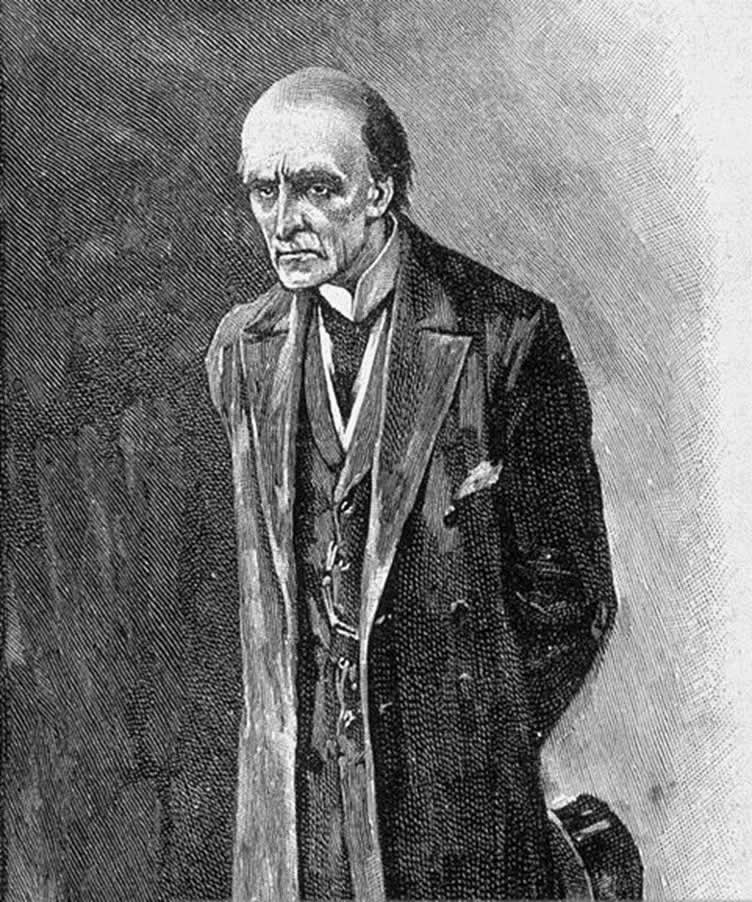
PHOTOGRAPH OF THE MONTH (61)
In the not quite bleak mid-winter.
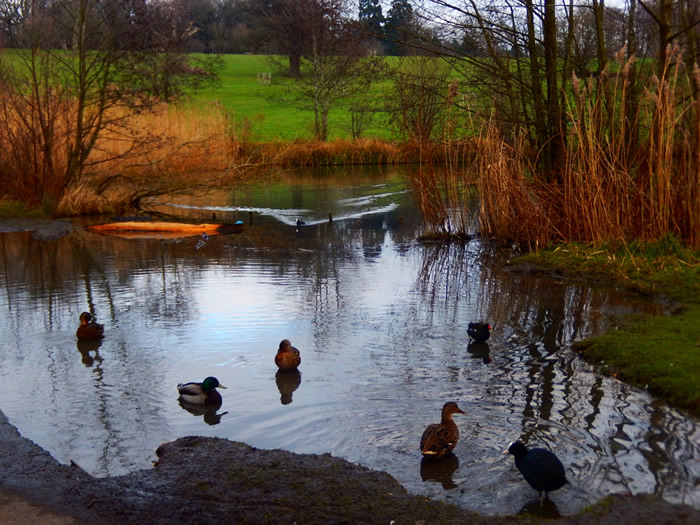

STEPHEN KING INTERVIEW

Time for another archive interview, this time with Stephen King, from SFX magazine number 45 (December 1998). There was a simultaneous online version on Line One (now TallkTalk), back when ISPs carried editorial content on their home pages; a truncated version in an American magazine, and a translation for a French publication. This is the definitive version.
The interview took place at Brown's hotel in London, which since its establishment in 1837 has been a favoured venue for artists and writers. Mark Twain and Agatha Christie often stayed, and frequent visitor Rudyard Kipling finished writing The Jungle Book there.King told me that he was thrilled the first time he sat at the actual desk Kipling used. A couple of days after conducting the interview, on 24th August, there was a launch party at the Royal College of Arms in Kensington Gore for Bag of Bones, the book he was in the UK to promote. The event included a rock 'n' roll set, with King on guitar. My wife Anne and myself were fortunate enough to be among the attendees.
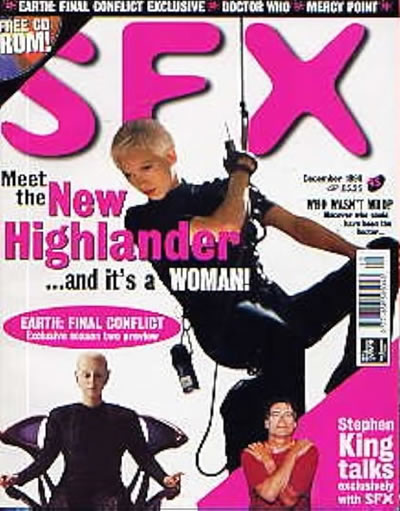
I can't remember what title I gave the interview when I submitted it. In any event the magazine decided to change it, and I'll stick with theirs …
The Gospel According To Stephen
Even in these troubled times it's unusual for a celebrity to have a bodyguard present during an interview. However, Stephen King introduces his burly young minder as Joe. Joe seems friendly, but not the sort of man you would want to get on the wrong side of.
“He's here to look after me,” King explains in an easy manner.
In what way?
“He'll throw himself between us if you ask an inappropriate question.”
It was the kind of loquacious line you'd expect from one of the author's characters.
King's success transcends mere genre. Each of his 28 books have achieved multi-million sales, and the latest, Bag of Bones, hit the bestseller lists the day it was published. His work continues to be adapted for the screen at a furious pace. Currently, The Green Mile is being filmed with Tom Hanks, and a television mini-series penned by King, Storm of the Century, is also underway. Here's a writer whose income must resemble the gross national product of a medium-sized country.
It's hard to believe that this amiable, lanky 51 year-old, with his open, almost boyish face, needs a bodyguard. Then again, King wrote Misery, a tale of fan worship taken to the absolute extremes.
“Misery wasn't based on any kind of fan atrocity,” he says. “I didn't have too many of the real fanatics at that time. But I've picked up one or two since. There was a guy who broke into my house who claimed he had a bomb and would explode it if I didn't listen to his ideas. I wasn't there. I was in Philadelphia with my youngest son. My wife came down at six o'clock in the morning and this guy holds out a backpack and says, 'There's a bomb in here. I have to talk to Stephen King.' She ran out of the house in her nightgown to call the police. The bomb turned out to be pencils and erasers, and paper-clips that had been pulled apart into wires. In his mind, this was a bomb.”
Maniacs with phoney explosives aren't the only irritants he has to put up with. His wife once found a woman in their kitchen, going through the cupboards. 'I just wanted to see what he eats,' the stranger told her. 'Don't worry, I'm not crazy.' After these incidents security was beefed-up at the King's home in Maine, New England.
“Another extreme case is a guy called Stuart Lightfoot, who claims I was part of a conspiracy to kill John Lennon and it's provable through my works. He even believes I've confessed to it! He sends me passages of my own writing, and photographs of Mark Chapman, to whom I bear a faint resemblance.” At one point, Lightfoot set himself up in a caravan outside King's house. He claims King “stole his fame.” “He's nuts, that's all. He's like one of those guys you have standing on boxes here, at Speaker's Corner. One of the nutters in Hyde Park.”
Joe's muscular presence suddenly seems a little less unnecessary.
“But at the time I wrote Misery,” King reiterates, “I was only aware that there were a lot of people out there who read my books and who formed a connection to me through them in their own minds. It's totally untrue! I don't know these people, I don't have any relationship with them, and if we have anything in common it's our humanity.”
If the inspiration for Misery didn't come from a real life incident, where did the horrifying tale come from?
“Like the ideas for some of my other novels, that came to me in a dream. In fact, it happened when I was on Concorde, flying over here, to Brown's” Brown's of Mayfair, where this interview takes place, is one of London's most exclusive hotels. It's a perk of his tremendous good fortune, and a definite improvement on the second-rate motels he used at the beginning of his career.
“I fell asleep on the plane,” he recalls, “and dreamt about a woman who held a writer prisoner and killed him, skinned him, fed the remains to her pig and bound his novel in human skin. His skin, the writer's skin. I said to myself, 'I have to write this story.' Of course, the plot changed quite a bit in the telling. But I wrote the first 40 or 50 pages right on the landing here, between the ground floor and the first floor of the hotel.”
Indeed, the desk he sat at was the same often used by Rudyard Kipling when he stayed at Brown's.
“Another time,” King continues, “when I got road-blocked on my novel IT, I had a dream about leeches inside discarded refrigerators.” He smiles at the memory. “I immediately woke up and thought, 'This is where this is supposed to go.' Dreams are just another part of life. To me, it's like seeing something on the street you can use in your fiction. You take it and plug it right in. Writers are scavengers by nature.”

This could explain the line in Bag of Bones that goes, 'Perhaps in dreams everyone is a novelist.' The book features a writer, Mike Noonan, whose wife dies unexpectedly, which turns out to be a prelude to supernatural happenings. It's far from being the first time King has used an author as hero.
“I gave the manuscript of this book to my wife, Tabitha, and she rolled her eyes and said, 'Steve, it's another book about a writer.' And I said to her, 'When you get a new Dick Francis you don't roll your eyes and say, “Oh, another book about a jockey.”' She admitted it was true. Since writing's what I know about, it's a good place to go out from. But I also know about teaching, because I used to be a teacher, and I know about acting and the movie world and that sort of thing, so I can go to other places if I have to. Anyway, in a lot of respects Bag of Bones isn't so much about the world of writing as it is the world of publishing.” He grins mischievously. “The publishers love that part.”
Does he find it easier to write a narrative in first-person, as here?
“No, it's usually a little bit harder. Purely in a technical way, it's harder to get to all corners of the story when you're telling that story from the first-person perspective. It has its advantages, and it's the natural way people write to start with, but I think that for a novel it's a little more challenging, because you can't get to another place. You have to show how events work on the main character, because the reader can only see what he sees.”
In the book, Noonan admits that he finds it difficult to ask for help, or to express his feelings. Some would say that kind of buttoned-down attitude is very English. Is it very Stephen King?
“Yes, it is. It's me, it's very English, and you have to remember that when I write a book like Bag of Bones I'm writing about New England, where we're very close to our English forebears. Sometimes people ask, 'Why have your books been such a success in England?' and I'll say, 'Because I'm their people and they're my people and we're close.' So yeah, it's an English thing and a Yankee thing to say, 'I'm fine. I don't need any help.'”
Something else his hero says is that being paid to write is like having “a licence to steal.” Does he feel that way himself?
“Yes, I do. I think it's wonderful that they pay me and it's allowed me to send my kids to college. When I got married I had a teaching degree but I couldn't find a teaching job, so I went to work in an industrial laundry, washing motel sheets. It was probably 110, 120 degrees in there in the height of the summer and I got down to about 175 pounds. I was working 60 hours a week and making $1.75 an hour, barely enough to support my family. Now, I work maybe four hours a day, seven days a week, and that's still only 28 hours a week. I sit in an air-conditioned office and they pay me millions. It's a lot easier than, say, loading lorries at a warehouse out in Sheffield or somewhere. But it's the work I was made for and, of course, I'd do it for free if I didn't get paid.”
This is certainly true. He's a born writer. But as he currently earns advances of around $17million per book, it's unlikely to happen. He began writing seriously while holding down a day job, pounding out his work on a second-hand typewriter costing $35. He made his professional break in 1967 when he sold a short to Startling Mystery Stories. The payment amounted to a few cents a word. His career really took off with the publication of his debut novel, Carrie, in 1974, and Salem's Lot the following year. These days, he's said to be outsold only by the Bible and the Koran.
As he did it all with horror, often graphically described, the question has to be if there's anything he wouldn't write about, any taboo he wouldn't touch.
“It's a question I usually elect not to answer, because then somebody says, 'Well, what are those things which you choose not to write about?' But my feeling is that the more taboo the subject seems to be, the more it interests me to see whether or not I can write about it. I like the challenge of it and I like the danger of it. Take my novel The Dead Zone. If there's a taboo in the States, it's a great sensitivityto the idea of political assassinations. At the same time, there's a whole load of people in America who say that everybody should be able to own a gun if they want to, despite the fact that all the major assassinations were carried out with guns. Now, you can't get close enough to a president, or someone like Martin Luther King, to strangle them or stab them because somebody like Joe over there would step in and stop you.”
The ever-present Joe fidgets a bit and looks slightly uncomfortable.
“But if a guy's got a rifle he can take me out or take you out if he wants to. So what we've done is to try and create this taboo about using guns, and to present assassination as a cowardly act, something no sane person would do. I started to wonder 'Would there ever be justification for that sort of assassination, the man in a high place with a gun? Would you kill Hitler if you could go back in a time machine?' That was the starting point for The Dead Zone.”
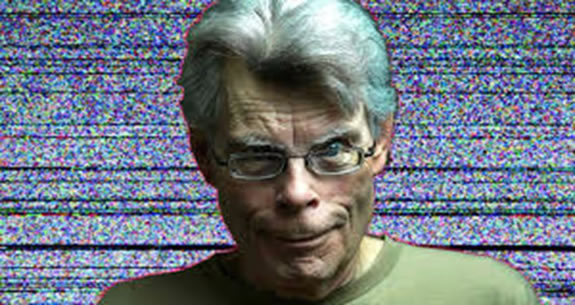
King is aware that we're living through an age in which sticking your head above the parapet isn't always wise. This is touched on in Bag of Bones, where Noonan worries that onlookers might misunderstand his motives in trying to comfort a child in the street.
“Wasn't there a story in this country recently about teachers being warned not to put suntan lotion on kids?” King says. “I have a friend who teaches high school in my home town. He's probably 45, and he's done the job for a long time. I've seen teenage girls, his pupils, run to him and he'll give them a big hug. I said to him one time, 'Lenny, you're going to get into trouble if you do this.' His response was, 'Fuck 'em. The day I get into trouble for hugging a kid I'm out of this business, because that's part of what kids are about.'”
“Our generation is terrified of license because we grew up with everything. If you had a nickel for all those things the people in our generation have not told our kids we've tried: the drugs, the sex, the theft, the destruction of property … You've got a woman who is, let's say, 40 years old, who says to her teenage daughter, 'I don't want you out past 11 o'clock at night. You could get AIDS.' Or she'll say, 'What are you doing walking around in a tank top? Anybody can see your bra-straps.' What she's not telling the kid is that when she was 20 she had lice in her hair, she was hitch-hiking, fucking guys for rides between LA and Washington, because that was a different world. I think people from my generation have forgotten on a conscious level exactly what we were into and what we were up to. But on a deeper level it's still there, and it's come out in this really absurd Victorian response to sexuality. One of the motive forces behind Bag of Bones is that I've been married for 25 years, and I've been faithful to my wife, but I notice young girls much more than I used to, and I think a lot of people in my generation have so sublimated their own desires and their own feelings that they have these tendencies to see monsters everywhere. Monsters of sexuality, monsters from the id. We know what kind of trouble we got into with that behaviour. Maybe we don't always want to admit it to ourselves, but we know and we'd like to spare our kids that. I mean, isn't that part of being a parent? You want to spare your kids some of the bullshit you went through. What was fun at 20 seems tiresome at 40.”
He's written stories with vampires, werewolves and ghosts as the menaces, but for him real horror lies in everyday tragedy, like losing a wife or suffering writer's block, fates inflicted on the protagonist in Bag of Bones.
“They're terrifying thoughts in the way that cancer is a terrifying thought, where you say, 'I hope this doesn't happen to me, but it can't possibly happen to me because it's so terrible.' That's the denial that kicks in.“
He stops and asks, “Have you ever had writer's block?” I tell him yes, something approximating it, and it was very frightening. “Yeah, it's scary,” King agrees. “I had writer's block when I was in college. I was taking a lot of writing courses at that time and I believe writing is one of those things where the more you think about it, the harder it is to do. It's something you ought to do pretty much unregarded. But I don't worry about it a whole lot.”
Is it the old rule of “easy to read, hard to write” with him? Does he do lots of revisions? Does he sweat?
“I do a lot more than I used to and there are a number of reasons for that. The more success you have, the more people are watching what you do. I mean, people are really paying attention and that causes you to be self-conscious. But all that isn't really the way I was writing. I have always had a view that books are pre-existing things. I don't feel that I make stories up. I feel that I excavate them. I think that the job of the writer is like the job of the palaeontologist or the archaeologist. Here's this thing that's buried. Your job is to get it out as whole as you can. It's very fragile so you dig around it and you use your brushes or whatever as you try to get it out. It's there for you and you dig it up.”
How can a book pre-exist in that way? Does he mean in the sense that to a sculptor, a solid, unmarked slab of marble has a figure in it waiting to be unleashed?
“Yeah, that's right. For instance, people say to me, 'Where did you get the idea for Bag of Bones?' and I say, 'I don't know.' I was thinking one day about Rebecca, and about the gothic, and how the gothic is about secrets, about buried things. I guess at that point I had some sort of an idea that I was going to write a story about a man who's haunted by ghosts belonging to buried bodies on his property. Then at some further point I thought about a young woman being harassed by an old rich man who wanted custody of her child. But how those two things came together was like … “ He pauses to consider his words. This isn't easy for him to explain. “As I said, it was like archaeology. If there's a novel buried in the ground, so to speak, it's as though digging in one place brought up the base of a spine, digging in another revealed a skull. The actual excavation is an act of faith. You simply start at the beginning and assume that everything's there, and in this case everything was. But there was no outline, there was no plan, no road map of the plot. It kind of … revealed itself.” King laughs, the spell broken, a little embarrassed perhaps at revealing how the creative process works for him. He pushes a plate of biscuits our way. “Have a cookie.”
Joe doesn't take one. No doubt he likes to keep in shape in case he has to throw himself across his boss to save him.

We agree that there are one or two insightful critics. “Even three or four,” King amends. “My point is that occasionally someone will see something in the work that the authors themselves weren't aware they'd put in.” Has this happened to him, and did he ever take the credit when it did? “Yeah, that happens. I was at a writers' workshop where people were required to read something by me and then write a paper on it. The papers were presented while I sat at the back of the room and listened. Then I had to react to these papers, delver a kind of conversational critique, which puts the writer in a really uncomfortable position at times. Anyway, one guy critiqued my story Children of the Corn, about some people who fetch up in a small town in Nebraska where the children have murdered their parents on the orders of a heathen corn god. This guy did a long, really brilliantly executed paper saying this was all a parable about the American experience in Vietnam, and these children were symbolic Vietcong and the corn was the jungle and the interlopers were Americans and God, it never crossed my mind! I never thought once about Vietnam during the course of writing that story. While they were waiting for my comments, I'm thinking, 'This guy worked for weeks on this paper, he's got to get graded on it. All I have to do is open my mouth and say, “You're full of shit” and he's down in flames.' What I said was, 'Certainly the Vietnam war was a big part of my early life and there are a lot of things we draw from without even realising it, so this is probably a valid interpretation of the story.' But it wasn't.
“As for taking credit for that stuff, usually no. But, it's funny, sometimes the weirdest things happen when you write. For example, I wrote a story called Apt Pupil, which is about an American boy who's doing a research paper on the Holocaust, and he discovers this Nazi war criminal living on his block. It's about their relationship, because the boy's price for not turning this Nazi in is to hear about what went on in the camps and the extermination of the Jews. I gave this boy the name Tod Bowden, and my editor at that time said, 'This name is very clever.' I asked him what was clever about it and he said, 'Tod is German for death.' I said, 'Oh yes, of course it is.' I didn't know.”
Maybe it was something he picked up and stored subconsciously? “I'm not sure there really is a subconscious. I think the subconscious is a fairy tale for adults.” He doesn't subscribe to Freud's world-view? “Oh God, no!” Or Jung's? “No. Well … maybe. Sure, we get things passed on probably through our DNA, our chromosomes, but I believe our subconscious mind is a lot simpler and a lot cruder than Freud ever gave us credit for. It's basically as important, perhaps, as your gall-bladder, which you can have cut out and continue to live without very nicely. The idea of all this subconscious stuff is bullshit.”
What about race memory? “I believe in broad racial characteristics of thought and reaction, but they're very, very general. So general you could almost say they're part of the human metabolism. But race memory? No, I think it's probably romantic crap.”
On the subject of collective memory, I recall a scientist of some kind I heard on the radio a few weeks earlier. He was talking about why so many people are frightened of spiders, and his theory was that if you go back far enough in time spiders were a genuine threat to humans because they were much bigger. Like, the size of Alsatians. This strikes a chord. King pulls a face. “Spiders, I loathe them. I've heard another theory, and you'll love this: we have such a deep fear of spiders because they're actually extraterrestrials. They came here a long time ago on a meteor or something, and developed as a life-form. We understand instinctively that they're not from our planet.”
Uncomfortable a thought as this is for we arachnophobes, it's also somehow funny. I remind King that when Psycho was released Alfred Hitchcock said he couldn't understand why audiences found it so frightening. He regarded it as a comedy. Does King see any of his own work that way?
“Some of it, yes. My book Needful Things was meant to be a comedy. It was written very much with the Reagan administration in mind. I felt that Reagan was a kind of demon who came into town, the town in this case being America, and said 'You can have whatever you want. It's easy, anybody can do it. Junk bonds? Fine! Leverage buy-outs? Great! Cocaine? Fantastic! Whatever you want you can have it. All you have to pay with is your soul.' I guess a lot of people feel that way about the Thatcher regime here in England. I think that avarice and greed, any sort of sin of excess, is funny. I think acquisitiveness is funny. It just is, I'm sorry. What I'm talking about are crimes that we indulge in where we say to ourselves, 'We're really not hurting anybody, we're doing things for the best.' I mean, one of the problems Clinton's facing over the Lewinsky business is that he looks like a buffoon, doesn't he? Chasing after a woman who's 21 years old, who's basically not very interesting except for her physical attributes, reduces him to the level of a Punch cartoon. He looks like an elderly sugar daddy.” He doesn't buy the idea of a right-wing conspiracy then? “Good God, no. He's just a horny guy.”
Even Joe manages to crack a cautious smile at that one.
“There is an element of irony in the Clinton situation. I mean, for the first time since Kennedy we have a president who's young enough to have an interest in sexual matters. Kennedy certainly had a lot of affairs, apparently used his office in very much the same way as Clinton has used his, but in America there's a kind of unspoken rule of thumb: Republicans want your wallet and Democrats want your women. Those are the vices that they have. But anyway, I wrote this novel Needful Things, where a man comes to town and opens up a shop and basically trades for goods, and the trade always involves you doing some sort of a prank on one of your neighbours. Pretty soon the whole town is at war. Some nasty things happen in that book. There's a dog that's killed with a corkscrew, and there's a woman who's beaten to death, and a whole lot of other horrible stuff. But I say it's a comic novel. Certainly any story where a woman sells her soul to get Elvis Presley sunglasses you have to laugh about!
'Thing is, the book reviewed very badly because nobody saw it as a comedy. There's a mindset that comes into play with my work or with Hitchcock's work; we're seen a certain way. But anybody who pays attention to Hitchcock knows that he had a great black sense of humour.”
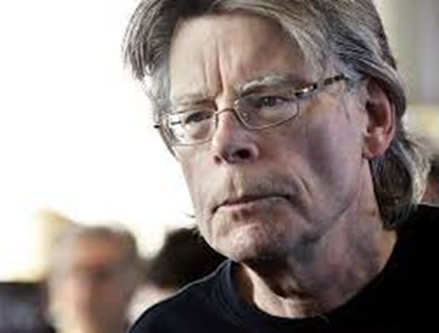
Many writers have little rituals, superstitions almost, they have to go through in order to start working. With Hemingway it was sharpening 24 pencils every morning. “Oh, I have them too,” King admits, “sure I do. And the rituals all serve the same purpose for the writer, which is to put him in the mood to write. It's like hypnotic trances. If you've never been hypnotised I've got to work to hypnotise you, but if I gave you certain triggers you can hypnotise yourself. You just have to go through a set ritual.
“With me, when I get up I want to have a glass of orange juice, and I want to have it where I can look at the newspaper. But mostly what I'm doing is just looking at the pictures. Then I have to put on the kettle, and it can't be on high heat, it can't be on low heat, it's got to be on medium heat because that way before the kettle whistles it's going to be 25 or 30 minutes, and by that point I'll be into what I'm doing. It's like going up on a ski lift – you wait until the hook comes along and then it catches you and you start up the slope. I also have to have one aspirin, and I was doing that long before I found out it was good for the heart. I take it because it's got caffeine. It's just a little accelerator to get you up that slope. It used to be nicotine for me. I was a heavy smoker before I finally gave it up.
“The writing implements I use don't matter too much. I like the word processor because it's fast.” Though he feels they have one important downside. “I used to do a draft with a typewriter or by hand and, you know what I'm talking about, this would be a big untidy stack of paper with coffee rings on it and I'd have stuff scribbled out and I'd have shit written between the lines. Now, with a word processor, the first draft looks like the finished draft. There are no strike-overs, there are no interlinings; it's all nice and neat and it looks great. But I have to remember it still needs to be rewritten. Fact is, I'm just as comfortable with a pen and a piece of paper.” A surprising number of his books, despite the fact that they can run to 500 pages and more, are written by hand.
“Mind you,” he tacks on, “I do have the perennial writer's fear, which is that I'll be found out. That the scales are going to fall from my publisher's eyes one day and they'll say, 'You fraud! We're paying you all this money and the emperor has no clothes on!'” He's joking. Mostly.
“What else frightens me? I've always thought clowns were scary. That's why I put one in IT. And I noticed, taking my kids to the circus, that they didn't want anything to do with them. They were terrified, my daughter in particular, because clowns are freakish, they're strange. Circuses are basically safe havens for the freakish and the weird. Those grotesque faces and that unending laughter is the kind of thing you find in a lunatic asylum. Even children understand that's not natural.”
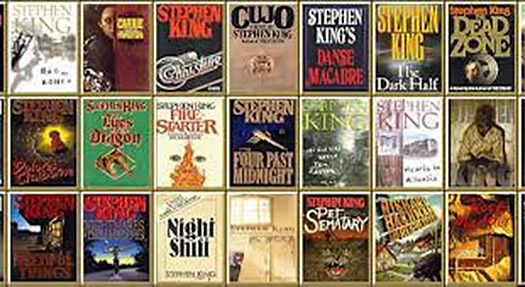
In the publicity material accompanying Bag of Bones King refers to Shirley Jackson's The Haunting of Hill House. Jackson personifies the brand of fiction he finds the most unsettling.
“As far as the ghosts and vampires and so on go, we like that sort of thing because we know they're not true. They're very safe in a way. They're fun. But The haunting of Hill House is very, very upsetting to read. Jackson's book, and something like James' The Turn of the Screw, are upsetting to us for a couple of reasons. One is because we don't know how much of it is an actual supernatural phenomenon, and if it is a supernatural phenomenon it's still terrifying because those ghosts are not friendly. The other possibility is that we're watching the workings of a mind that's not sane any longer, and that's disturbing too.
“I love Shirley Jackson. She's the best. I'd like to think that my fiction could be as affecting. Over the course of the years you get to know when you've written something that seems to work; when you've got that thing out of the ground pretty much intact. I feel like I did that with Bag of Bones. I love the book. Also, I've been doing this job for 25 years now, and a lot of people who are reviewing me grew up reading my stuff and I'm getting the benefit of that. You get good critical comments if you've done the job well. But you also get points for still being alive, like Bob Dylan or Pete Townsend.”
It's time to go. I leave him pondering his longevity, nod to Joe and make my way out. I calculate that at least a couple of thousand more Stephen King books have been sold in the time we were talking.
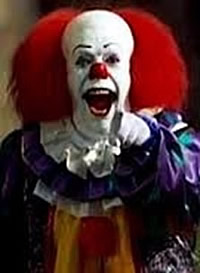
REDISCOVERED ARTWORK
A further delve into the archives has turned up a page of forgotten artwork. Many projects evolve and develop in the making, and in my experience this is particularly true of any book dependent on artwork, like graphic novels. The graphic novel Orcs: Forged For War (First Second Books), which I created with artist Joe Flood, is no exception. The intention was to have an introduction in which an elderly scholar begins to recount the story that followed. Joe inked the pages, but before they went to the colouring stage it was decided to drop that section as we were close to the page limit and, to be honest, an intro wasn't really necessary to advance the plot. Here's the first page Joe produced:

FAVOURITE ARTISTS 7
The series featuring some of my favourite artists which I began posting here with the June update usually includes four choices per month. But as this update is somewhat longer than usual I thought I'd feature just one and return to four next time.
Favourite Artists # 25
DIDIER GRAFFET (b 1970).
A graduate of École Émile Cohl, the educational institution in Lyon, Didier Graffet began his career as a freelance illustrator in 1994. He has produced many fantasy fiction book covers for French publishers. In 2001 he illustrated an edition of Jules Verne's Twenty Thousand Leagues Under the Sea, which earned him the Grand Prix de I'Imaginaire Award and Jules Verne Award. His illustrations for Verne's Mysterious Island (2005) were equally well received. He subsequently worked for the Jules Verne Adventures Studio, creating posters for its festivals in Paris and Los Angeles, and is currently acting as Artistic Director on a documentary film with the organisation. Apart from fantasy and Verne devotees, his work has found particular favour with Steampunk enthusiasts, and has been widely exhibited in galleries and other venues.
The piece here is entitled Astoria. The example below is Le jour du chasseur (The Day of the Hunter).
Disclosure: Didier produced sixteen covers for French editions of my books. But that isn't why I've included him in this series – I like his work regardless.
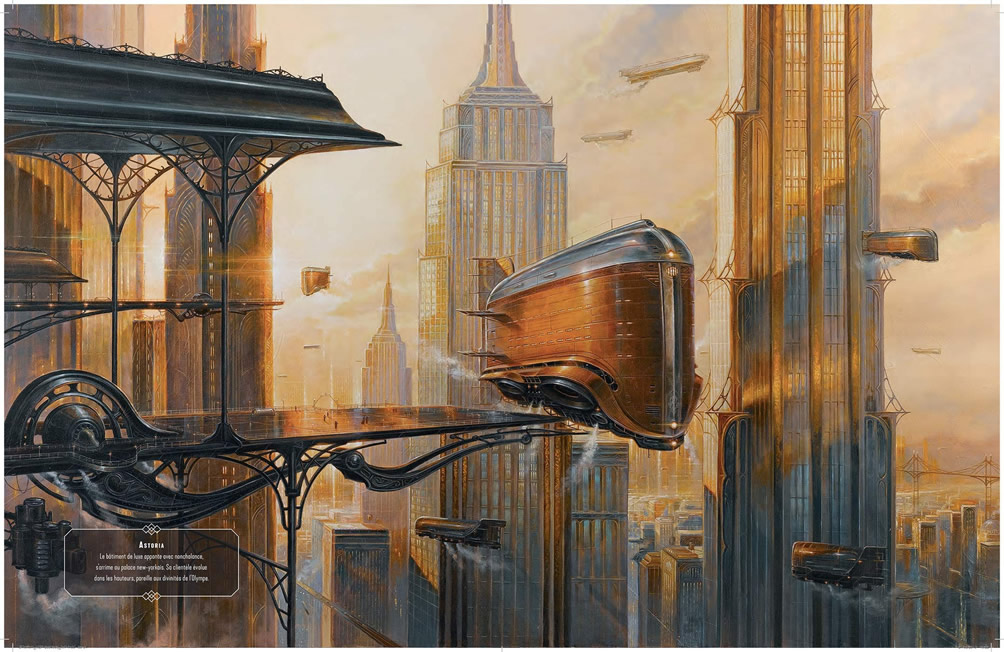
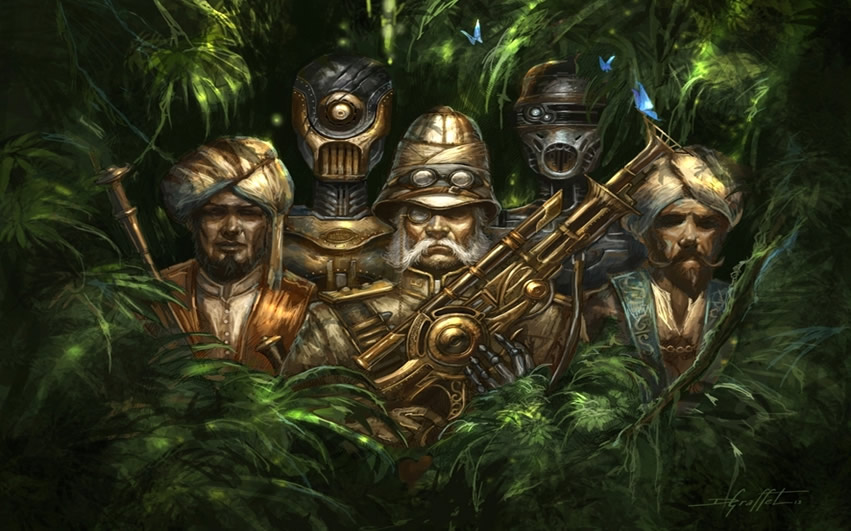
PHOTOGRAPH OF THE MONTH (60)
This is often how we'd like December to be, but in this era of climate change the weather doesn't always cooperate.
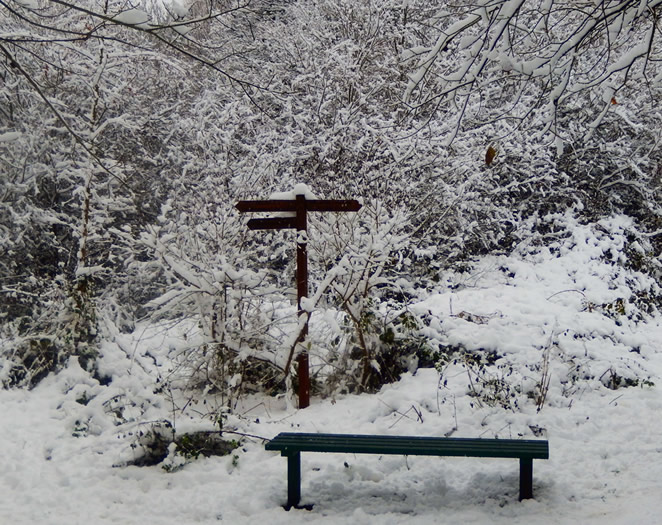
I regularly post photographs on my Facebook page; and all previous Photographs of the Month featured here can be found in the Photo Gallery.

… to all who celebrate Christmas, and a happy and peaceful New Year to everyone.
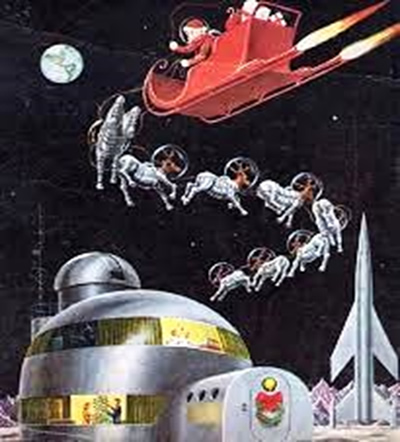
Ed Emshwiller was number 9 in my Favourite Artists series. This is his cover artwork for the December 1954 issue of Galaxy magazine.

FAVOURITE ARTISTS 6
Here are the next four of my Favourite Artists, a monthly series I began back in the June update (which you can see by scrolling down).
Favourite Artists # 21
VINCENT DI FATE (b 1945).
New York born science fiction and fantasy artist Di Fate broke into the magazine market with interior illustrations for the August 1969 issue of Analog, followed by his first cover for the title in November of that year. He has a Master of Arts degree in Illustration from Syracuse University, and has produced astronomical and aerospace themed art for clients including IBM, NASA, the National Geographic Society and Scientific American magazine. The Disney corporation, MCA , MGM and several other media companies have employed him as a consultant.
Vincent Di Fate's many awards include a Hugo for Best Professional Artist (1979), the Edward E Smith Memorial Award (the Skylark Award) in 1987 and the Chesley Award in 1998. He was inducted into the Science Fiction Hall of Fame in 2011.
The first illustration here is 'Ares and the End of All.' The cover art for Ron Goulart's short story collection Broke Down Engine (1969) is the second.
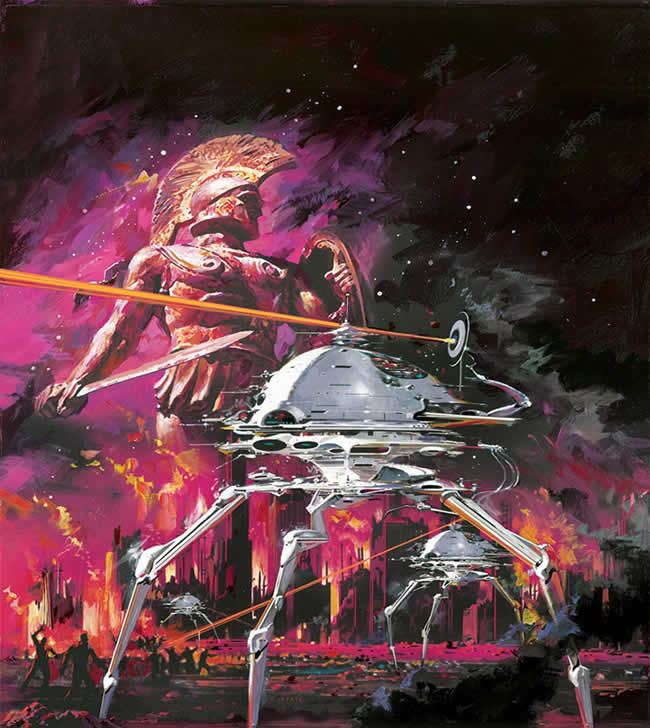
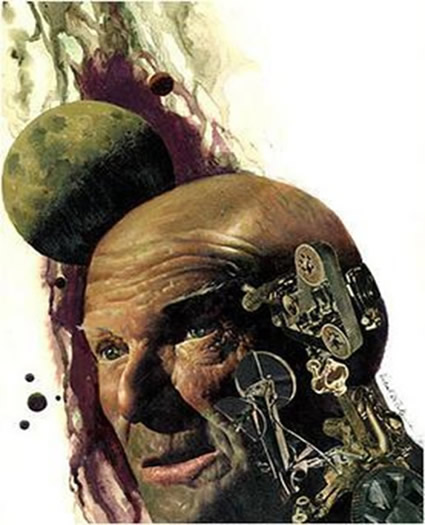
Favourite Artists # 22
BERNARD ALBERT WRIGHTSON (1948-2017).
Bernie Wrightson began his career as an illustrator for The Baltimore Sun newspaper in 1966. A meeting with Frank Frazetta (number 18 in this Favourite Artists series) at a comics convention the following year inspired Wrightson to pitch his portfolio to DC Comics. That led to regular work on DC's stable of supernatural anthology titles, notably House of Mystery and House of Secrets. He later also freelanced for Marvel's similarly themed Chamber of Darkness and Tower of Shadows.
In 1971 Wrightson and writer Len Wein created the popular Swamp Thing character for DC. 1974 saw him working for Warren Publishing's Creepy and Eerie horror titles, and later, collaborations with Stephen King on several comicbook adaptations of King's novels.
In 1975 Wrightson joined with fellow artists Jeff Jones, Michael Kaluta and Barry Windsor-Smith to form an art collective called The Studio. The quartet shared a loft studio in Manhattan working on projects that left behind the sometimes notorious restrictions of the comicbook industry. The project that many consider Wrightson's masterwork, an illustrated edition of Mary Shelley's Frankenstein, which took him several years to complete, was published in 1983. In his later years he acted as a film and TV concept artist.
The second image below is a detail from one of Wrightson's Frankenstein illustrations.
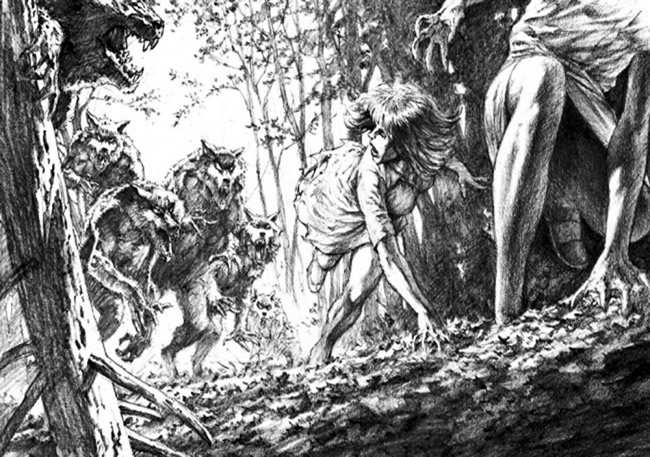

Favourite Artists # 23
GERRIT DOU (aka Gerald Douw or Gerald Dow; 1613-1675).
Dutch Golden Age painter Gerrit Dou was born in Leiden. His father manufactured stained glass, and Gerrit was trained in the same trade at the workshop of one of his father's associates. At the age of 14, in 1628, Gerrit was sent to study painting in the studio of Rembrandt, who was only 21 himself at that time and lived nearby. Dou's three years there saw him develop a style that reflected Rembrandt's, but he soon formulated his own approach, which differed greatly from his one time master's. His working methods were elaborate and painstaking - he's reputed to have once spent five days painting a hand - and his work was so fine, typically on quite small canvasses, that he had to manufacture his own brushes.
The painting here is 'Sleeping Dog' (1650). 'Scholar Sharpening a Quill,' thought to have been painted some time between 1630 and 1635, is below.

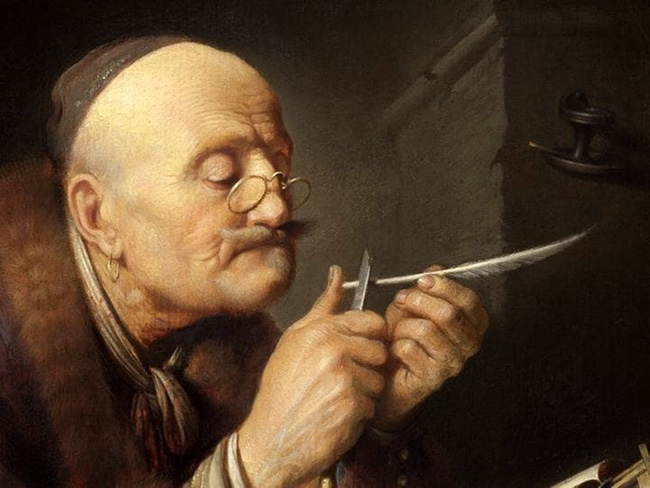
Favourite Artists # 24
BRIAN (MONCRIEFF) LEWIS (1929-1978).
Brian Lewis' career as an illustrator began after serving in the RAF. Some of his earliest work was for the Nova magazines New Worlds, Science Fantasy and Science Fiction Adventures, to which he contributed a total of around eighty covers. In the late '50s he moved into British comics, drawing strips for Tiger, Eagle, Boy's World, Wham!, Smash, Buster and several others.
In the '60s and '70s he was active in adapting TV series to comic strips for Countdown,
TV 21 and TV Action. During this period he also moved into animation, notably on the Beatles' film Yellow Submarine. His other credits included work for 2000 AD, House of Hammer and Warren Publishing's Vampirella.
Suffering from a heart condition, Brian Lewis was only 49 when he died.
The illustration here is from the cover of New Worlds number 70, April 1958, along with the complete cover. Below that is one of Lewis’ illustrations from Cinderland, an adaptation of the Cinderella story.
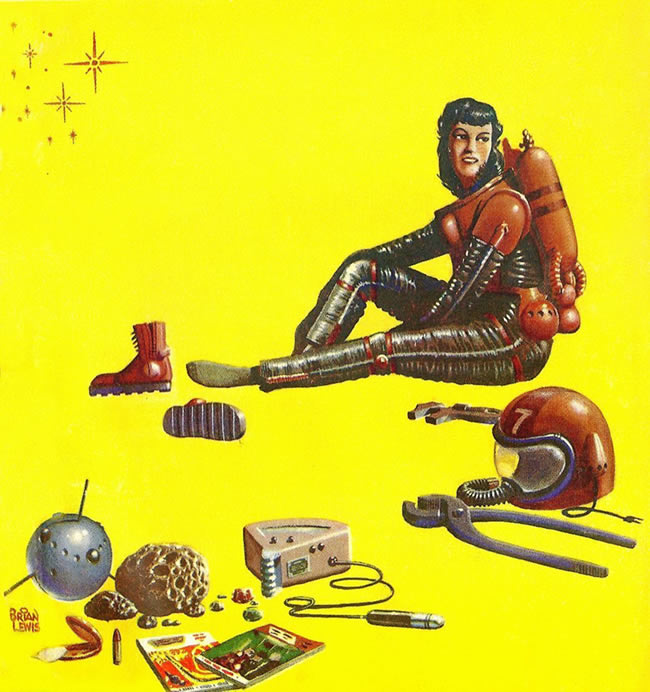

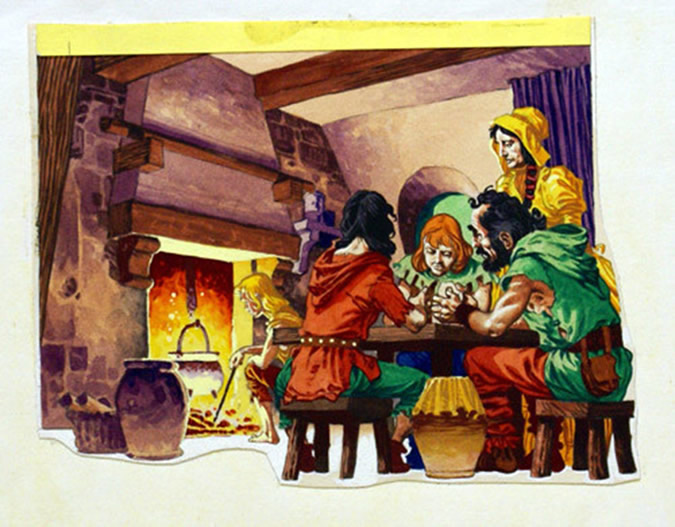
PHOTOGRAPH OF THE MONTH (59)
Autumn colour.
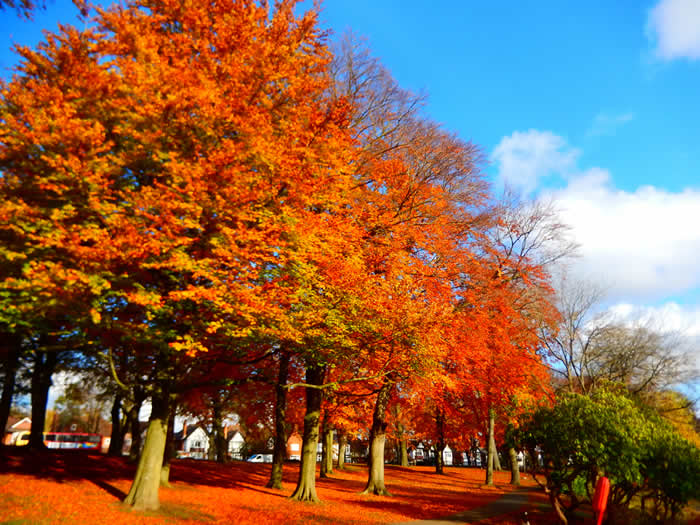

FAVOURITE ARTISTS 5
Here's a continuation of my personal list of Favourite Artists, which I began in the June update (scroll down to see).
Favourite Artists # 17
ALEX SCHOMBURG (born Alejandro Schomburg y Rosa; 1905-1998).
Puerto Rica-born Schomburg enjoyed a prolific seventy year career producing covers, and some interior illustrations, for comics, pulp/digest magazines and books. Having moved to New York in 1917 he began working as a commercial artist in 1923. In the 1930s he moved on to pulp covers for titles including Thrilling Wonder Stories and Flying Aces.
The 1940s saw Schomburg providing many covers for Timely Comics (the forerunner of Marvel) featuring popular characters such as Captain America, the Human Torch and the Sub-Mariner. He also worked for rival companies illustrating the covers of comics centring on superheroes the Black Terror, the Fighting Yank and the Green Hornet, among others. He continued working well into his senior years, and garnered many awards in both the comics and science fiction fields. He was inducted into the Will Eisner Hall of Fame in 1999.
The artwork here is entitled 'Dear Caressa or This Towering Torment'. (Inkwash on board.) His first cover for a science fiction pulp, the September 1939 issue of Startling Stories, is below.
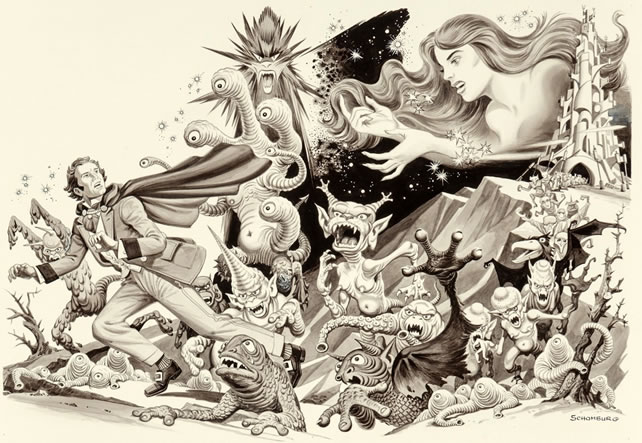
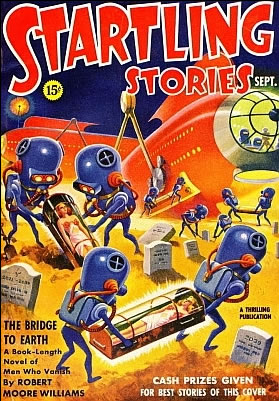
Favourite Artists # 18
FRANK FRAZETTA (born Frank Frazzetta;1928-2010).
Putting aside any issues about his generation's tendency for objectification – curvaceous women absurdly going to war or into space wearing gold lame bikinis and the like (no doubt delighting hormonal teenagers when they first discovered the genre) - I couldn't fail to include arguably the 20th Century's greatest fantasy/science fiction artist. Frazetta really was in a class of his own.
Displaying a talent for art from childhood, he got into the comics industry when he was just 16, in 1944. And around that time he dropped one z from his surname, which he declared was “clumsy” with two. Frazetta worked extensively in comics until around 1952, although given the business' refusal to credit creators at that time it's difficult to identify everything he did. After a spell working on newspaper strips he returned to comics in 1961, and also contributed to Harvey Kurtzman and Will Elder's ribald 'Little Annie Fanny' strip in Playboy magazine.
In the mid-'60s he was commissioned to produce the poster for the Woody Allen film What's New Pussycat/? which led to a supplementary career illustrating movie posters. He also got into book covers, notably oil paintings for the Lancer Books editions of Robert E Howard's 'Conan' series, which proved enormously popular and influential. Although ironically, as he later admitted, "I didn't read any of it... I drew him my way.” Additionally, in this highly productive period he contributed covers and some interior stories to the Warren magazines Creepy, Eerie, Vampirella and Blazing Combat.
The 1980s saw Frazetta establish a gallery, Frazetta's Fantasy Corner, in Pennsylvania, exhibiting both his own work and that of other artists. His many accolades included being inducted into the Will Eisner, Jack Kirby, Society of Illustrators and Science Fiction Halls of Fame. In June 2023 his painting 'Dark Kingdom' was auctioned for $6million, setting a
record for the most valuable work of fantasy art and breaking the record of the previous holder, Frazetta's 'Egyptian Queen' (£5.4million).
The artwork here is 'The Disagreement' (1985) and below is the cover for Famous Funnies no 213, September 1954.
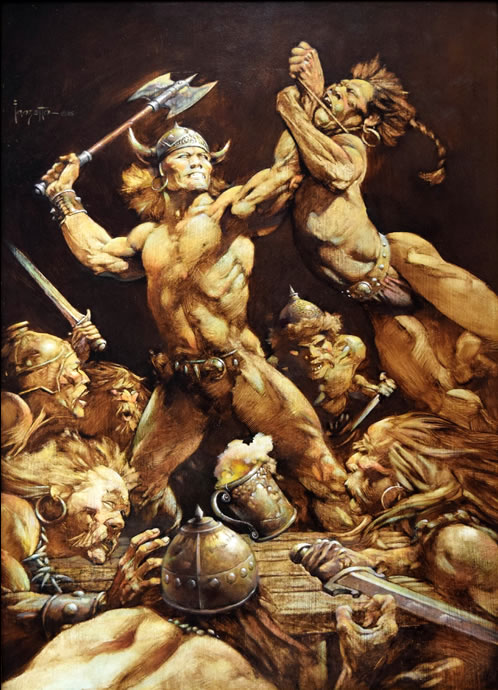
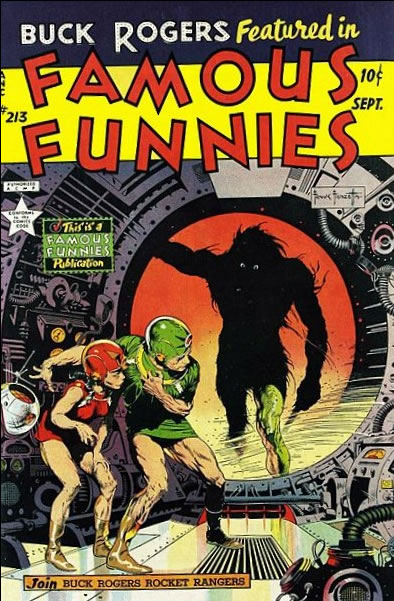
Favourite Artists # 19
JACK DAVIS (John Burton Davis Jr; 1924-2016).
Cartoonist and illustrator Jack Davis was first published at age 12 when he had a cartoon accepted for issue 9 of Tip Top Comics in 1936. Following three years in the US Navy during wartime he found work with EC Comics, contributing covers and strips to Tales From the Crypt, The Vault of Horror, The Haunt of Fear, Two-Fisted Tales, and Frontline Combat among others. He was one of the founding artists of Mad magazine in 1952, and was a long-term mainstay of the title.
Davis produced the poster for comedy western Viva Max! in 1969, and went on to create a number of other movie posters, including Kelly's Heroes (1970) and the 1973 adaptation of Raymond Chandler's The Long Goodbye. He illustrated music and comedy album covers for performers including Johnny Cash, The Guess Who, Bob & Ray, Sheb Wooley and Archie Campbell.
He received a Lifetime Achievement Award from the National Cartoonists Society in 1996 and was inducted into the Will Eisner Hall of Fame in 2003.
The Jack Davis illustration here is from the cover of EC's Incredible Science Fiction no 31 (September 1955). The opening panel from his parody of the film 'High Noon' from Mad magazine no 9 (March 1954) is below.
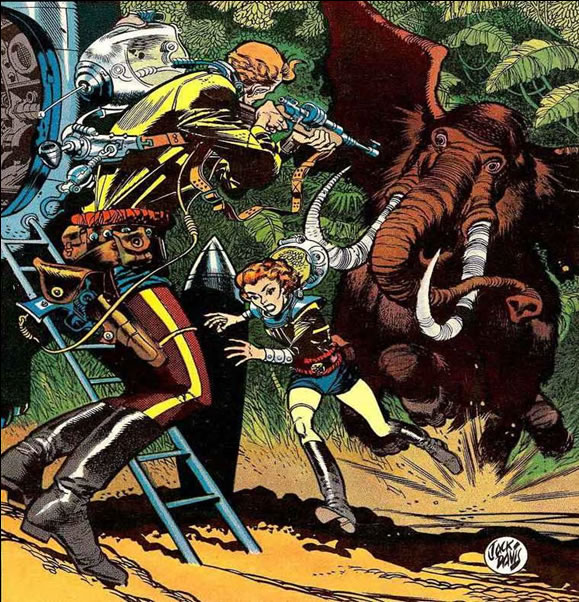
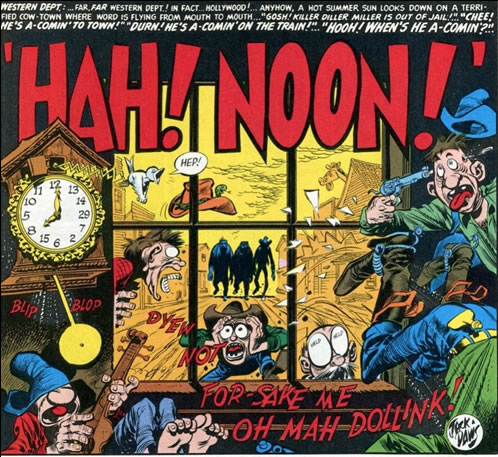
Favourite Artists # 20
PIETER CLAESZ (c1597-1660).
Dutch Golden Age artist Pieter Ciaesz was one of that era's leading painters of still life subjects. Born near Antwerp, Belgium, he moved to Haarlem in 1620, where his son Nicolaes Pieterszoon Berchem, later a noted landscape artist in his own right, was born. Much of Claesz's work was characterised by a subtle, almost subdued choice of colours, although his later canvases employed a more colourful palette.
The work here is 'Still Life with Turkey Pie' (1627). Below is 'Still Life with Skull and Candle' (1625) . Claesz had a thing about skulls. He used them as a metaphor regarding mortality.


PHOTOGRAPH OF THE MONTH (58)
An October dawn.
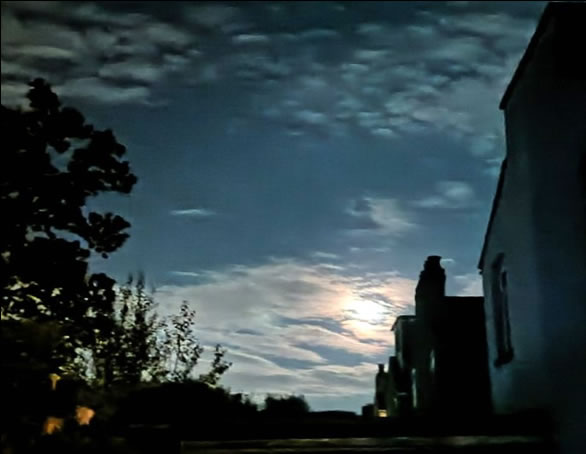

WEARING MY BOOKS
A shout out to my friend Sky Campbell, who's utilised one of my US book covers on t-shirts, vests and other cool fashion items.
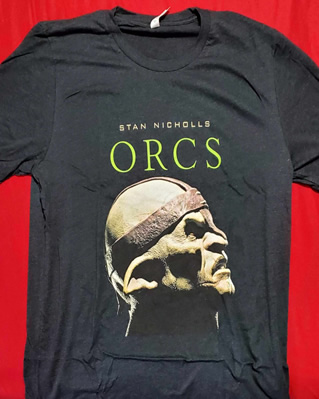

Sky's a software and games developer, and until a couple of years ago was the Language Director for the Otoe-Missouria tribe of indigenous Americans in Oklahoma. He also very ably acted as the IT/Website Manager for the David Gemmell Awards for Fantasy (see the Photo Gallery here). I really do have some great readers, and I'm so grateful for them.
FAVOURITE ARTISTS 4
Continuing the listing I began with the June update (which you can see if you scroll down this page) here's the next batch of my personal Favourite Artists.
Favourite Artists # 13
ALFONS MARIA MUCHA (known as Alphonse Mucha,1860-1939).
Czech-born Mucha was a painter and graphic artist whose theatrical posters, advertisements, book illustrations and jewellery designs were a major component of the
Art Nouveau movement. A gifted artist from childhood, at age nineteen Mucha left his native Moravia and travelled to Vienna, where he was employed as an apprentice scenery painter. During this period he became interested in photography, a tool he would use in his later work. In 1881 a fire destroyed the theatre of the scenery painting company's major client, leaving Mucha unemployed. He earned a modest income for the next four years by painting portraits, decorative art, and lettering for tombstones. Subsequently resident in Munich, he studied briefly at the Munich Academy.
He moved to Paris in 1887, and in 1894 his work drew the attention of famed French actress Sarah Bernhardt, who commissioned a theatre poster by him. His association with Bernhardt, and the quality of the series of posters he produced for her, saw Mucha gain many commissions for advertising posters, and art lecture engagements in the United States. His work also featured prominently in the Paris Exposition of 1900, the first high profile exhibition of Art Nouveau. Mucha died of pneumonia on 14th July 1939, less than two months before the outbreak of the Second World War.
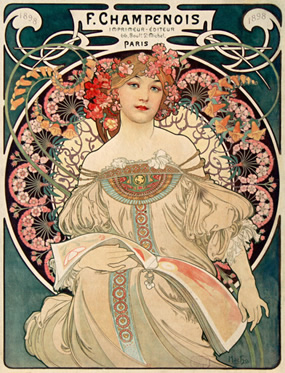
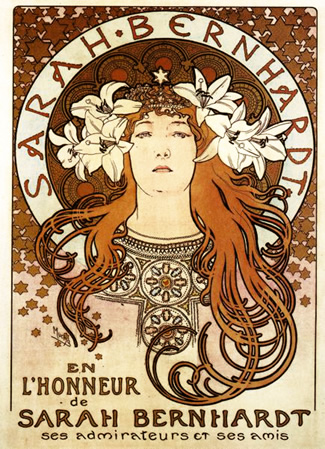
Favourite Artists # 14
ALEX(ANDER GILLESPIE) RAYMOND (1909-1956).
Alex Raymond, “the artist's artist” in the estimation of many fellow cartoonists and fans, displayed an early talent for drawing. He found employment as an assistant illustrator on several newspaper strips in the early 1930s. In 1933 he created the enormously influential Flash Gordon comic strip in competition with the market-leading Buck Rogers strip, and soon overtook 'Buck' in popularity. Raymond also worked on adventure strip Jungle Jim and spy strip Secret Agent X-9, created by crime writer Dashiell Hammett. After a spell in the marines from 1944 to 1946 Raymond returned to his career, creating and illustrating private eye strip Rip Kirby. All these strips are considered milestones in the history of comic art. Many artists named Raymond as a major inspiration, including Batman co-creator Bob Kane, Jack Kirby and Al Williamson (number 5 in this Favourite Artists series). George Lucas cited Raymond as an influence on Star Wars.
On 6th September 1956, in Westport, Connecticut, Raymond was driving fellow cartoonist Stan Drake in Drake's Corvette at twice the speed limit when the car struck a tree and he was killed. Drake was thrown clear and survived. Controversy surrounded the accident. Drake and several others who knew Raymond believed that he was suicidal due to problems with his marriage, and pointed to the fact that he had been involved in four automobile accidents in the month leading to his death. “[he] had been trying to kill himself,” Drake claimed. Many other friends and acquaintances of Raymond dismissed the idea.
Raymond was inducted into both the Will Eisner Comic Book Hall of Fame (1996), and the Society of Illustrators Hall of Fame (2014).
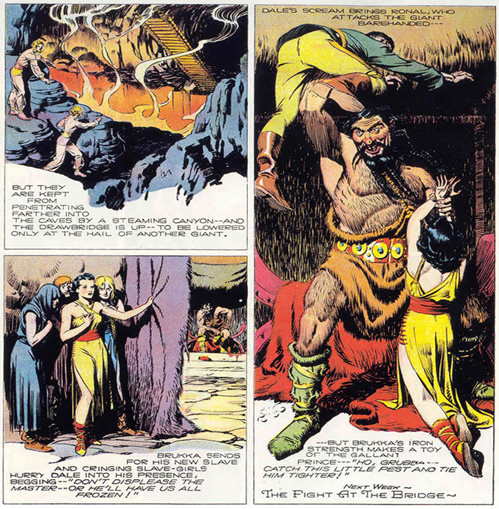
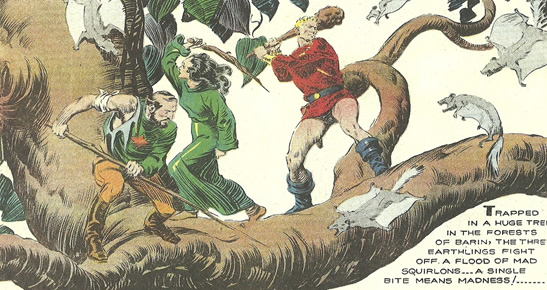
Favourite Artists # 15
JEAN HENRI GASTON GIRAUD (known as Moebius and as Gir; 1938-2012).
French artist, writer and publisher Giraud was both enormously prolific and a major influence on other artists, film-makers and creatives in visual industries such as gaming. His somewhat surreal science fiction and fantasy works, as Moebius, and western stories as by Gir, principally the Blueberry series, won him international plaudits. He also produced storyboards and concept designs for a number of sf films, including Alien, The Fifth Element, Tron, Willow and The Abyss. The use of his work, too extensive to list here, extended from comics/graphic novels to album covers, film posters, trading cards, video games covers, calendars, limited edition prints and many other formats.
Displaying a talent for illustration from an early age, in 1956 he quit art school without graduating and spent time with his mother, who was resident in Mexico. The Mexican terrain, its deserts and plains, the quality of its light, had a profound effect on Giraud and featured widely in his work thereafter.
In 1988 Giraud illustrated a two issue Silver Surfer story, Silver Surfer: Parable, penned by Stan Lee, for Marvel's Epic Comics imprint. The miniseries won an Eisner Award, and more work for both Marvel and DC resulted.
Toward the end of his life Giraud's eyesight began to fail, and he underwent surgery in 2010 to prevent blindness in his left eye. Finding it increasingly difficult to work on comics and graphic novels, in his final years he concentrated on single image works on large canvasses, usually commissioned.

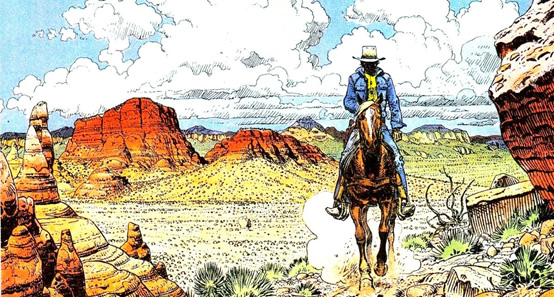
Favourite Artists # 16
JOHN WILLIAM WATERHOUSE (1849-1917).
After initially working in the Academic style, depicting scenes from Greek and Arthurian mythology, and Orientalist subjects, Waterhouse was drawn to the Pre-Raphaelites and became a major figure in the movement. Born in Rome to English parents, both artists, his early years in Italy are said to be the reason why the subject of many of his later paintings was Roman mythology. When Waterhouse moved to London he entered the Royal Academy of Art and was soon exhibiting at the Academy's Summer exhibitions. Throughout his career a number of his paintings were based on the works of writers and poets, including Shakespeare, Ovid, Homer and Tennyson.
Waterhouse's best known painting is probably The Lady of Shalott (1888). I've not chosen that as an illustration of his work because it's so well known that it somehow swamps appreciation of the artist's other creations. A painting which due to its familiarity comes with such a lot of baggage that I think we no longer look at it critically, if that makes sense. (See also The Mona Lisa.) I've picked instead The Favourites of the Emperor Honorius (1883).
Another example of Waterhouse's work (The Siren,1900) is below.
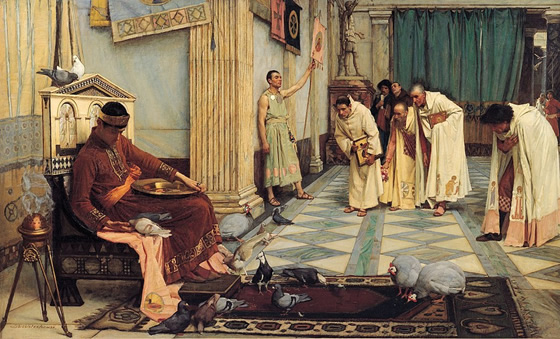
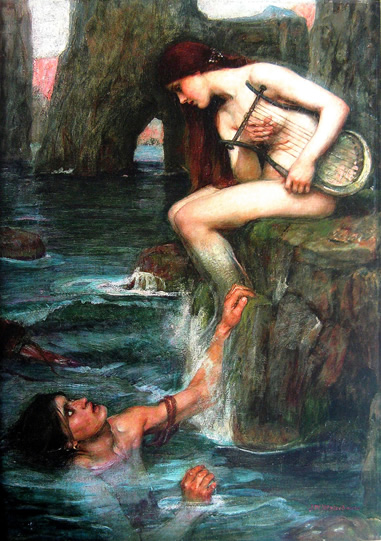
These picks of favourite artists appear weekly on my Facebook page.
PHOTOGRAPH OF THE MONTH (57)
Oxfordshire at harvest time.
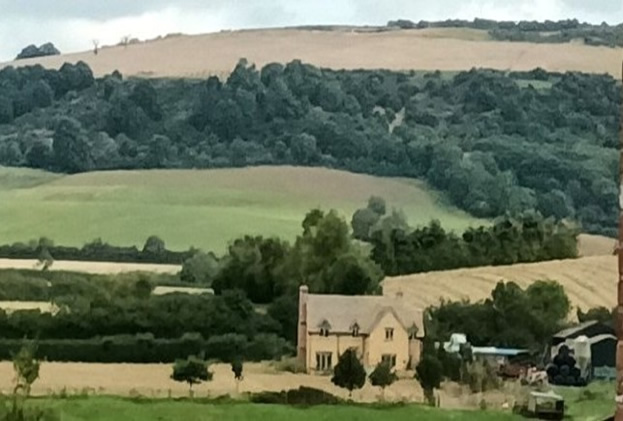
You can view all the previous Photographs of the Month in the Photo Gallery.

FAVOURITE ARTISTS 3
Continuing the rundown of some personal favourite artists, brought over from my Facebook page, where I post one choice each week, along with a couple of examples of their work. If you want to view all the entries from number one, scroll down to the June update below.
Favourite Artists # 9
ED EMSHWILLER (1925-1990).
Signing most of his work as by “Emsh”, Emshwiller was a prolific science fiction artist, working extensively in the field between 1951 and 1979, and later an experimental film pioneer. Due to his attraction to different art techniques there was never a definitive Emsh style.
Emsh became active as an underground film maker in the mid-60s, the controversial short Relativity (1966) probably being his best known work in that period. He was also a cinematographer on a number of documentaries, including a segment in the Bob Dylan documentary Don't Look Back, and several feature films.
A winner of the Best Artist Hugo award in 1953 (shared with Hannes Bok, number 2 in this Favourite Artists series), Emsh was married to science fiction author Carol Emshwiller (1921-2019).


Favourite Artists # 10
WALLACE (ALLAN) WOOD (1927-1981).
Few people would dispute that artist/writer and independent publisher Wally Wood was a giant of the comicbook industry. Apart from working for virtually every major comics publisher, he illustrated numerous magazines and books, record album covers, trading cards, cartoon strips and one-off cartoons, posters and advertising campaigns. Generally called Wally by readers and fans, he is said to have disliked the name and was known in the industry as Woody. Much of his artwork was simply signed “Wood”.
Subject to recurring, undiagnosed headaches for most of his adult life, his health took a downward turn in the 1970s, with alcohol abuse and kidney failure. In 1978 a stroke cost him his sight in one eye. His career and well-being in decline, on 2nd November 1981 Wood shot and killed himself in Los Angeles. According to an interview he granted shortly before his suicide, and referring to the years of hard, meticulous work he poured into his career, and perhaps the paucity of rewards, he said “If I had to do it all over again I'd cut my hands off.”
He was the first inductee into the Jack Kirby Hall of Fame (1989) and inducted into the Will Eisner Hall of Fame in 1992.
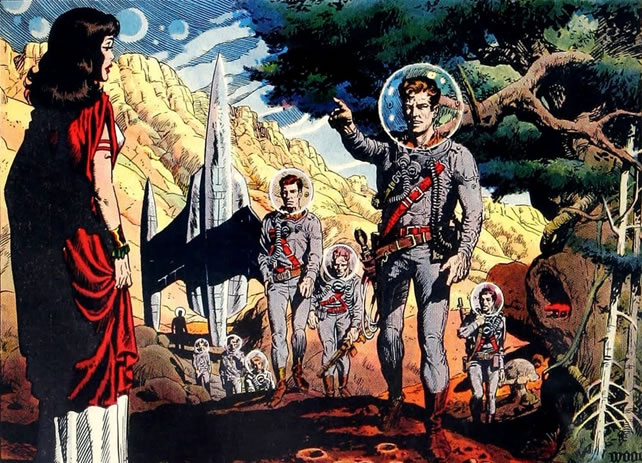
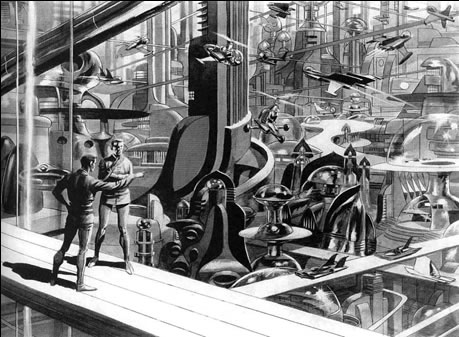
Favourite Artists # 11
NORMAN (PERCEVEL) ROCKWELL (1894-1978).
Arguably the most celebrated illustrator of Americana, Norman Rockwell produced over 4000 artworks, including almost five decades worth of covers for The Saturday Evening Post. He also illustrated more than forty books, along with film posters, postage stamps, playing cards, sheet music, retail catalogues and several murals. His art was commissioned by a number of major companies for advertising campaigns.
Critics tended to dismiss his work as overly sentimental or “too sweet”, and it was only toward the end of his life and posthumously that it began to be regarded seriously. Many of his canvases are now widely exhibited in prestigious art galleries. Steven Spielberg and George Lucas own Rockwell originals.
This piece, Shuffleton's Barbershop, dates from 1950 (and was the inspiration for 2013 TV movie A Way Back Home). The second example, The Problem We All Live With (1964) demonstrates Rockwell's willingness to engage with serious social issues.
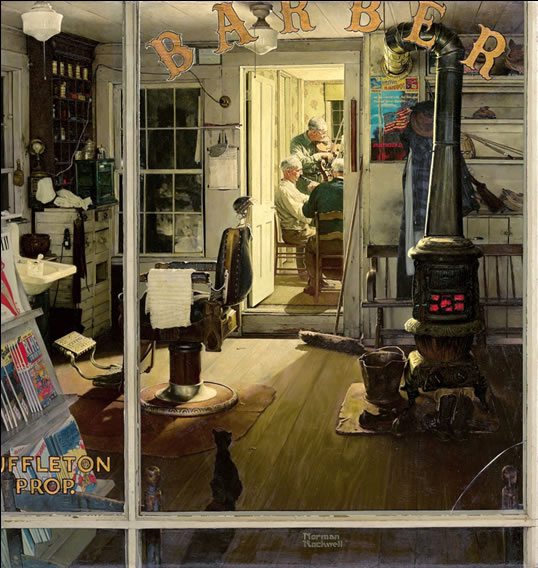
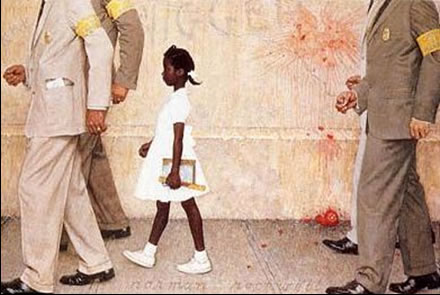
Favourite Artists # 12
JOHANNES VERMEER (aka Jan Vermeer;1632-1675) is considered one of the greatest of the Dutch Golden Age artists, although he's thought to have produced only fifty to sixty paintings, of which thirty-four are known to have survived. His modest output is attributed to his slow, meticulous work practises, and the fact that his main occupation was as an art dealer. Vermeer never left Holland, and during his lifetime his fame was almost entirely restricted to Delft, the city of his birth. The destruction caused by the French-Dutch war and the Third Anglo-Dutch war of the 1670s brought financial ruin to many, and Vermeer was no exception. In the years that followed he struggled to support his wife and eleven children, partly by working as an inn keeper, and he died in debt. Vermeer was more or less forgotten after his death, until his rediscovery in the 19th Century, at which point his reputation began to grow.
Perhaps I'm contrary, but I've never been overly keen on his most celebrated work, Girl With a Pearl Earring (1665), much preferring his depiction of scenes from domestic life such as The Music Lesson, Girl Reading a Letter at an Open Window, The Wine Glass and this painting, The Milk Maid (c1658). A close-up of part of The Milk Maid is reproduced below to highlight Vermeer's incredible attention to detail.
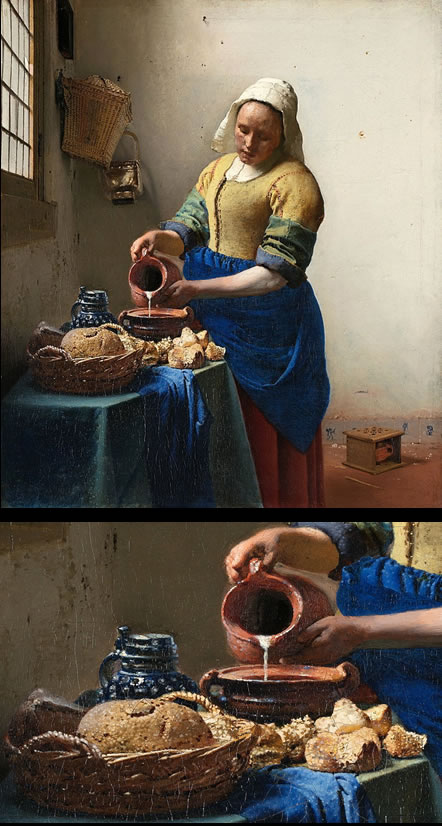
Bonus extra. The Milk Maid “modernised version”, a parody by my sister-in-law the artist Janet Calderwood.
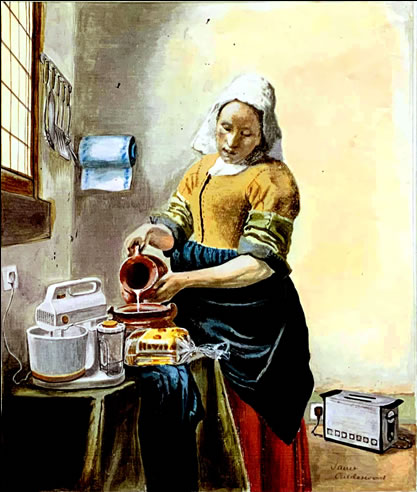
PHOTOGRAPH OF THE MONTH (56)
Summer's here, and this is how England looks … when it isn't raining.
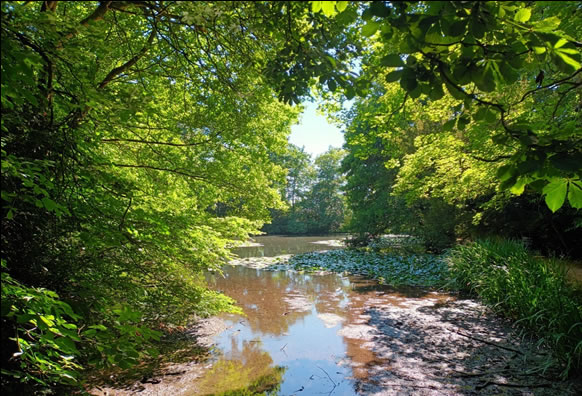
All previous Photographs of the Month can be found in this site's Photo Gallery.

FAVOURITE ARTISTS 2

Late 60s self-portrait by artist Al Williamson
In last month's update I began moving over a series of weekly posts from my Facebook page about some of my favourite artists. The first four posted in the June update were Hal Foster, Hannes Bok, Margaret Brundage and Virgil Finlay, which you can see by scrolling down this page. At some future point I hope to gather all these entries in a gallery here. Meantime, here are the next four:
Favourite Artists # 5
AL(FONSO) WILLIAMSON (1931-2010).
Al Williamson worked primarily as a comicbook artist, specialising in the science fiction, fantasy and western genres. He's noted for his 1950's strips for the EC comics Weird Science and Weird Fantasy, and several other of the company's titles, including Valor. The 1960's saw him continue the comicbook adventures of Flash Gordon, as originally conceived by his artistic idol and inspiration Alex Raymond. He was also an early contributor to Creepy and Eerie, Warren Publishing's black and white horror magazines. From the 1980's to 2003 he worked as an inker, mostly for Marvel Comics, on titles featuring Spider-Man, Daredevil and other popular superheroes. In 2000 Williamson was inducted into the Will Eisner Comicbook Hall of Fame.
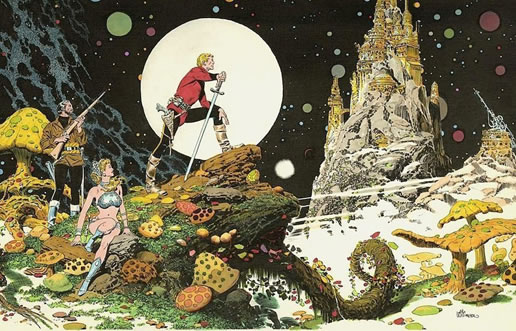

Favourite Artists # 6
(ZENAS) WINSOR McCAY (1866-1934).
Winsor McCay was a cartoonist and pioneer animator. Best known for his Little Nemo in Slumberland newspaper strip (1905-14, revised 1924-26) for the New York Herald, he also wrote and illustrated the strips Little Sammy Sneeze and Dreams of the Rarebit Fiend. He had a parallel career as a prolific editorial cartoonist, lampooning politics of the day.
Between 1911 and 1921 he produced ten animated films, the most celebrated of which was Gertie the Dinosaur.' McCay showed Gertie and several of his other films as part of a vaudeville act in which he appeared to interact with the on-screen characters.
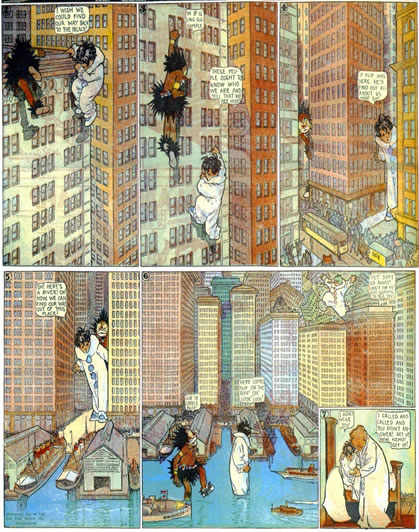

Favourite Artists # 7
WILLIAM (ERWIN) EISNER (1917-2005).
Comicbook and graphic novel pioneer Will Eisner enjoyed a career as a cartoonist and writer that lasted almost eight decades. He's best known for his groundbreaking, offbeat strip The Spirit, which debuted in 1940 and in its initial run, to 1952, was syndicated in newspapers with a combined circulation of around five million copies.
In 1978 Eisner produced one of the first graphic novels published in English, A Contract With God and Other Tenement Stories and continued to turn out books at the rate of approximately one a year into his eighties. The Eisner Award, regarded as one of the comicbook industry's most prestigious prizes, was named in his honour. The Will Eisner Comicbook Hall of Fame was established in recognition of his unique talent.

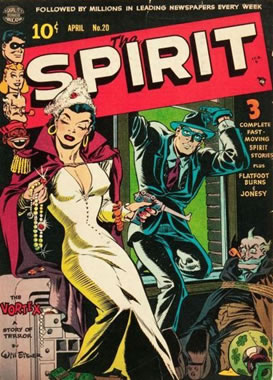
Favourite Artists # 8
FRANK KELLY FREAS (1922-2005).
Kelly Freas began a fifty year career as a science fiction and fantasy artist with his cover illustration for the November 1950 issue of Weird Tales. Hundreds of book and magazine covers, and numerous interior illustrations, followed. He joined Mad magazine early in 1957 and produced practically every cover until October 1962, all featuring the iconic Alfred E Neuman character. Always interested in experimenting with new techniques and materials, Freas was noted for his bold style and arresting use of colour. Among many other prizes, he secured no less than eleven Best Artist Hugo awards.
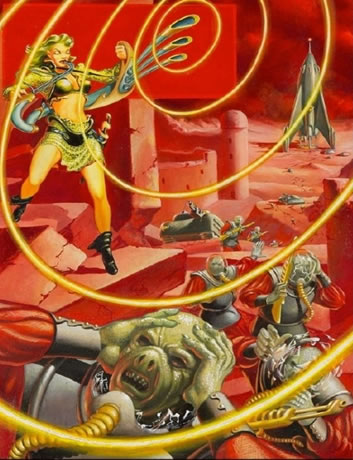
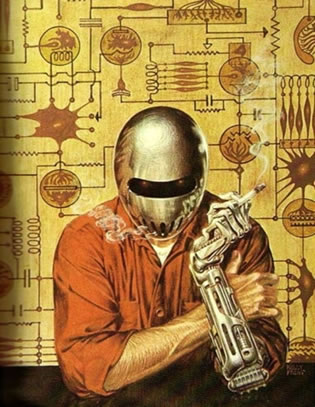
FROM THE ARCHIVES
Just unearthed, this half forgotten piece of ephemera definitely falls into the “Doesn't time fly?” category. And a year after this event Anne Gay became Anne Nicholls …

PHOTOGRAPH OF THE MONTH (55)
Baddesley Clinton, a moated manor house set in the heart of the Forest of Arden, Warwickshire, has been added to, renovated and re-modelled through medieval, Tudor and 20th Century times. It was the home to one family, the Ferrers, for 500 years, and is now a National Trust property.
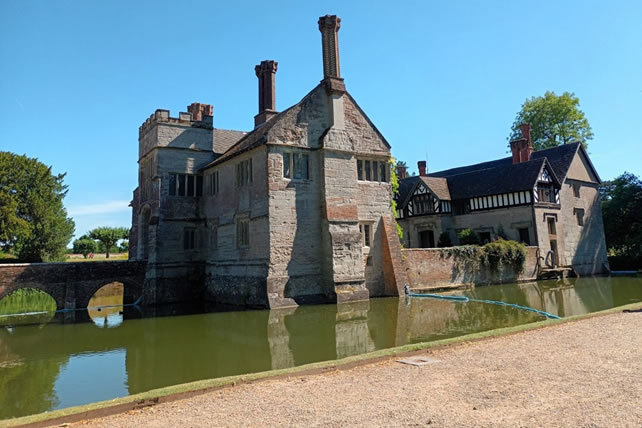
You can see all the previous Photographs of the Month in the Photo Gallery, and I regularly post photos on my Facebook page.

FAVOURITE ARTISTS
I got into a genial online conversation with a bunch of people a couple of months ago about the artists we hold in high regard. The upshot was that I decided to share the work of artists I admire by posting examples from one artist every week on my Facebook page, along with brief biographical details. At the time of writing this I've reached week ten. One interesting result of this was the number of people, and not just young people, who were encountering some of these artists for the first time. I see that as positive, not that I'm trying to teach anybody to suck eggs or anything.
Although many of my choices are inevitably science fiction, fantasy, supernatural and comicbook related, my tastes are by no means restricted to those areas. I considered no end of fancy titles for this series of illustrations but in the end decided on simply …
Favourite Artists.
Given the transient nature of social media – a torrent of posts flow by, disappear and are forgotten – I thought it might be an idea to give the series a more permanent home here, and perhaps eventually archive them in a gallery. So to make a start, below are numbers 1 to 4, the first month's worth. I'm aware that just two examples from each artist doesn't really do justice to their entire body of work, and what follows is only a taster.
Favourite Artists #1
HAL FOSTER (1892-1982)
Foster's hugely influential Prince Valiant in the Days of King Arthur newspaper strip debuted in 1937, and continues by other hands to this day. Over the years noted artists such as Wally Wood and Gray Morrow have depicted Prince Valiant.
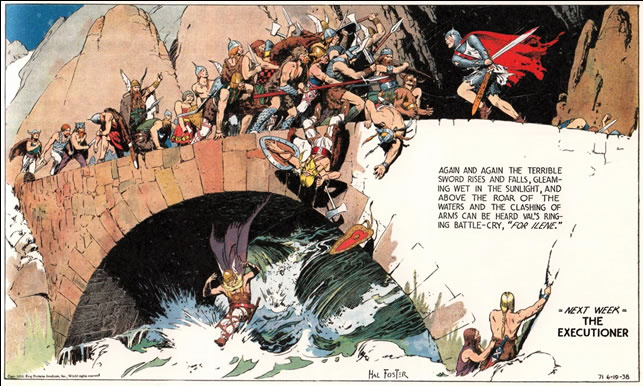
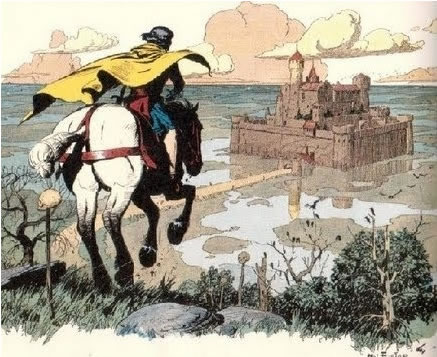
Favourite Artists #2
HANNES BOK (Wayne Francis Woodard; 1914-1964)
As well as an artist with a unique vision and style, Bok was an author and poet. He produced around 150 covers for science fiction, horror and crime fiction books and magazines, and hundreds of b&w interior illustrations. His fantasy novels include
Beyond the Golden Stair, The Sorcerer's Ship and Stranger From Space.
This piece, illustrating Roger Zelazny's A Rose for Ecclesiastes, was a wraparound cover for the November 1963 issue of The Magazine of Fantasy and Science Fiction.

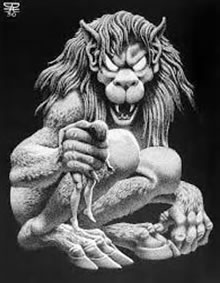
A Bok illustration from the December 1951 edition of Famous Fantastic Mysteries
Favourite Artists #3
MARGARET BRUNDAGE (nee Margaret Hedda Johnson;1900-1976)
Margaret Brundage is known principally for her pulp magazine covers, first for several issues of Oriental Stories (later retitled The Magic Carpet) and notably for the legendary Weird Tales, providing almost every cover for that title between 1933 and 1938.
During Prohibition Brundage supplemented her income by working in Chicago speakeasy the Dill Pickle Club, where she met bohemian writer Myron 'Slim' Brundage. They married in 1927 and divorced twelve years later.
As pulp magazine covers were infamously explicit, and in Brundage's case often erotic, she agreed to being credited as “M. Brundage” to hide her gender, it being unacceptable for a woman to be associated with such material at that time.
This is the January 1935 issue of Weird Tales.
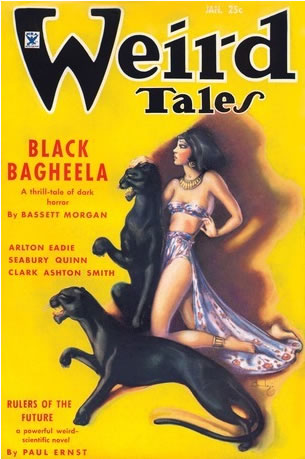
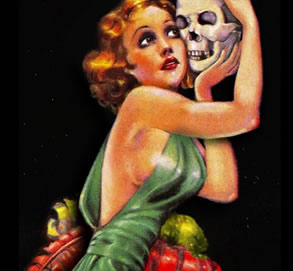
Favourite Artists #4
VIRGIL FINLAY (1914-1971)
Virgil Finlay is estimated to have produced close on 3000 illustrations for science fiction, fantasy and horror magazines and books over a 35 year career. Although he worked with several mediums, including oils, he was most prolific in, and famed for, his many highly detailed b&w pen and ink/scratch-board drawings.
In 1953 Finlay won a Hugo Award as Best Interior Illustrator, and was named Best Professional Artist of 1945 in 2019's Retro Hugos. He was inducted into the Science Fiction Hall of Fame in 2012.
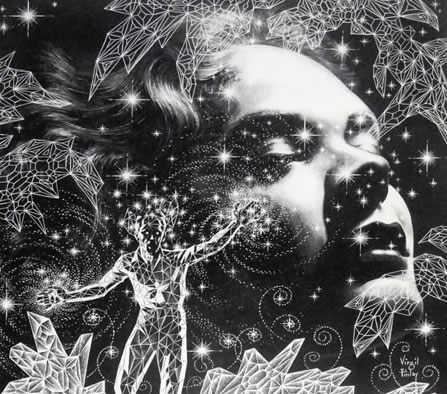
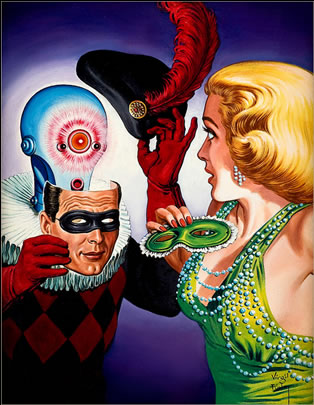
PHOTOGRAPH OF THE MONTH (54)
As the days are getting longer and we even get an occasional glimpse of the Sun, I thought this shot, from Javea in Spain, would be appropriate. I took the photo in June, but not this June, as I'm not lucky enough to be there at the moment.


THE MAN, THE MYTHS AND THE MODELS
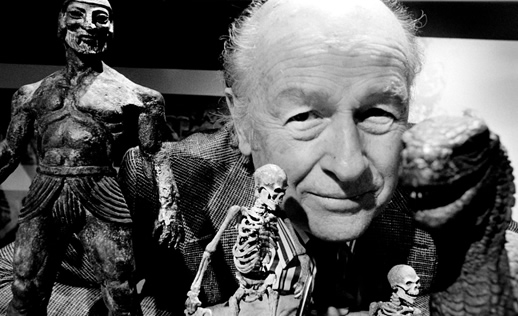
Another interview from the archives, this time with special effects legend Ray Harryhausen. In Autumn 1989 to Spring 1990 London's Museum of the Moving Image mounted a major exhibition of Harryhausen's work entitled Creatures of Fantasy. I was fortunate enough to be invited on a personal tour of the exhibits and spent some time talking with Harryhausen. Here's my interview with him, which appeared in Fear magazine issue 14, February 1990.

It's impossible to assess the career of Ray Harryhausen without reference to his mentor, stop frame pioneer Willis O'Brien. 'He's the father of the whole shebang,' says Harryhausen, who saw King Kong for the first time at the tender age of thirteen. 'In 1933 I innocently walked into Grauman's Chinese Theatre in Hollywood, and haven't been the same since.'
He has seen the film over a hundred times. 'I couldn't resist it. Every time it was reissued I'd go with two friends, Ray Bradbury and Forry Ackerman, to see it and other Merian Cooper pictures like She and The Last Days of Pompeii. That was our staple diet, because they had an imagination to them. They weren't the mundane subject matter so prevalent at the time.
'Kong is still a classic of composite photography and animation. The concept of leading you from the mundane world into the utmost pangs of fantasy is really remarkable because the structure of the script built your credulity into accepting the most fantastic images on the screen.
'O'Brien used Gustav Dore as his guide. If you look, you'll see a lot of Paradise Lost and the various other books he illustrated. Dore had a sense of drama in his engravings. A lot of people have forgotten him because the abstract came into fashion and anything representational went out. There's a great deal of Dore in King Kong, and in The Most Dangerous Game as well.'
But Harryhausen's interest in fantastic movies started much earlier than Kong. 'In 1923, when I was three or four, my parents took me to see The Lost World. Then of course I grew up on pictures like Metropolis, and there were movies in the silent days I could trace back as influences on my later work.'
At school, he built three-dimensional models in clay, and came to enjoy working with his hands. 'I made dioramas of prehistoric scenes,' he recalls, 'having always admired Charles Knight's restorations of prehistoric life at the American Museum of Natural History in New York.'
Inspired by King Kong, he saw a way of making his dioramas move. 'I took my mother's fur coat, donated against her will, and used it to make a furry cave bear with a wooden armature in it. Then I borrowed a 16mm camera from a friend. I was so hypnotised by these models moving by themselves I just kept going on and on. That first primitive experiment finally developed into a profession.'
Harryhausen has been approached several times to remake Kong, but he has always turned the chance down. 'A classic like that shouldn't be remade. The best you could do would be to imitate the original.' Nor is he enthusiastic about the recent colourised version. 'I couldn't believe it, it's frightening. I heard they are also going to colourise Mighty Joe Young. I don't mind them colourising a Laurel and Hardy or a musical - they could be nice colourised perhaps - but I think it ruined the whole mystique of Kong which, apart from anything else, was lit for black and white purposes.'
Harryhausen's first professional break came when George Pal made his Puppetoons and Madcap Models shorts for Paramount. 'We turned out six ten minute subjects a year, and I did most of the animation for the early ones.' But he had been in touch with Willis O'Brien before that, when he was making War Eagles, and found his technique much more interesting than Pal's. 'Pal used individual figures to make one step,' he points out. 'You needed twenty-five se3parate figures for each movement, and that never appealed to me because it was pre-animation. The process O'Brien developed, where you have a single figure, is much more creative, with one pose leading to the next.'
He finally found the courage to show O'Brien some samples of his work, and was taken on as his assistant for Mighty Joe Young. 'To work with him, Merian Cooper and Ernest B Schoedsack, having seen King Kong, and practically worshipping it to the point of being a fanatic, was a dream come true.'

Mighty Joe Young
In the event he ended up doing about eighty-five per cent of the animation on
Mighty Joe, as O'Brien was so tied up with the technical problems and preparing new set-ups. The film won an Oscar in 1947, but this was probably as much in recognition of Kong, which had appeared before there was a category for special effects.
In 1952 Harryhausen directed the effects for The Beast From 20,000 Fathoms, based on a story by Bradbury. From then on, each of his features presented problems that stretched him a little further technically. In The Beast he perfected a technique for combining live action backgrounds with animated models . 'In Kong and Mighty Joe Young most of the scenery was painted on sheets of glass measuring eight by ten feet. It gave the films a unique quality of mystery and wonder, but was a very expensive process. We had four matte painters on Mighty Joe for almost a year, and they got a high salary. It cost an enormous amount of money to do it that way. So I developed a technique which we later called Dynamation, where you split the screen and insert the creature against a realistic background. It avoided building complicated miniature sets, or having big glass paintings. It was purely for economic reasons because we had to make these films on a reasonable budget.'
His next project saw the beginning of an association with a producer which was to last for over twenty years. 'I met Charles Schneer after The Beast From 20,000 Fathoms and he wanted to make a film showing an octopus pulling down the Golden Gate Bridge. That interested me because of the gigantism. So I went to work with him and we made It Came From Beneath the Sea.'

When Schneer formed Morningside Pictures he began looking for subject matter and this gave Harryhausen the opportunity to reactivate a project first conceived some years before. 'I remember in my youth being so disappointed when Douglas Fairbanks Jr played Sinbad alongside Maureen O'Hara. They talked about the roc, they talked about the Cyclops, but you never saw them. I wanted to see them! I swore I was going to put the fantasy element on the screen. So, after Mighty Joe Young,I did some drawings and a ten page outline for The Seventh Voyage of Sinbad, and took them all over Hollywood, but nobody wanted to know. None of the producers seemed to have any imagination.
'Unfortunately, while I was trying to sell Seventh Voyage, Howard Hughes released Son of Sinbad, with Little Sincere and Her Bosom Pals. She was a stripper and they had Dale Robertson, who usually played cowboys, as Sinbad, and Vincent Price as a so-called comedian. That laid a big egg and everybody said costume pictures were out. It wasn't until Charles Schneer realised there was something important in these drawings that we finally made Seventh Voyage.' The film was brought in for around $650,000 and turned out to be a blockbuster.
The technical breakthrough here was that the film was the first shot in colour. Less happily, it fell foul of the British Board of Film Classification, which removed the classic skeleton scene and cut half the Cyclops sequence.
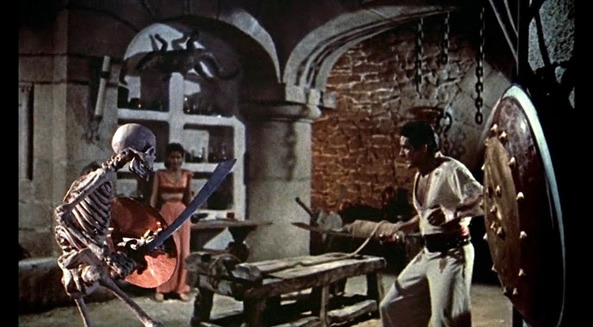
The Seventh Voyage of Sinbad
The skeleton fight in Seventh Voyage, and the much more ambitious battle in Jason and the Argonauts, underline the impression that the hardest thing to animate is the human body, if only because we are so familiar with it.
Seventh Voyage was followed by The Three Worlds of Gulliver, which was originally intended as a musical vehicle for Danny Kaye, and later, Jack Lemmon. Harryhausen maintains the picture had a lot of values, but it was not a success. However, it brought him to England, where he was to make the rest of his films. 'Hollywood didn't have a proper travelling matte process, only the blue backing, which was prohibitively costly. We heard about the yellow backing process here and come over to make Gulliver and Mysterious Island. We had Rank Laboratories do our processing work, and used yellow backing for both films. We decided to settle in this country and we've been here ever since.'

20 Million Miles to Earth
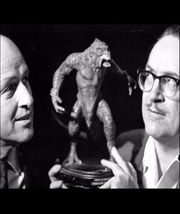
Harryhausen and Forry Ackerman
His next production, Jason and the Argonauts, seems to be everyone's favourite Harryhausen picture. 'I feel it's the most complete, and it pleases me the most. We had to manipulate the story a bit to make it dramatically sound, but it has all the creatures logically built in.'
He has been quoted as saying he would have liked the film's skeleton fight to have taken place at night. Was this an afterthought? 'Yes, but we might have got an X certificate if it had been at night. We got an X with the Seventh Voyage skeleton, as you know, and didn't want to get seven Xs for Jason! I guess it would have been a little more dynamic at night, but then again what's done is done, we can't change it now.'
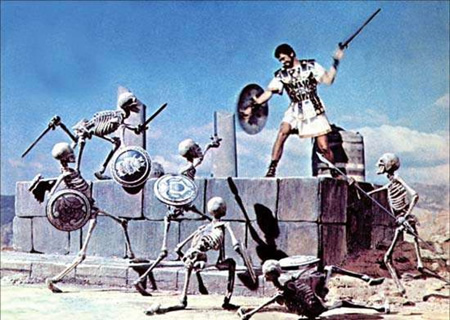
Jason and the Argonauts
He acknowledges the complexity of the scene, in which he had to cope with seven skeletons and three men. 'Each skeleton had five appendages, and every frame of film you had to move and keep them in synchronisation. You can't just move the arm - you have to move the arm, the body and the head at the same time in order to get a flow.' How did he keep track? 'You do it by sense, feeling and experience. I would keep a record of the live action, and know that when Jason or whoever swung their sword it would take ten frames, and I had to meet it at that point. But the actual animation I did freehand, without a record.'
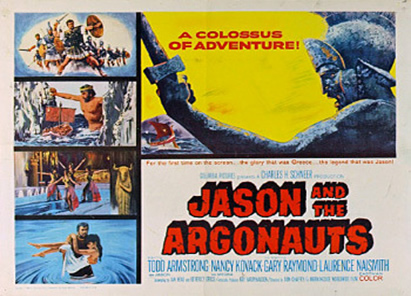
The innovation with First Men in the Moon was widescreen, which he had some apprehensions about. 'Someone once said the only use of CinemaScope was to photograph the Last Supper,' he jokes. 'Most of my technique is miniature projection, where you re-photograph an image that's projected on a little screen behind the animated characters. You can't do that with a long, thin picture. I had to redesign the whole movie, and make sure of travelling mattes. We had a great deal of travelling mattes in First Men in the Moon which we wouldn't ordinarily use.'
First Men in the Moon was only moderately successful at the box office. One Million Years BC, on the other hand, was a big hit. It also marked a radical departure for Hammer Films, though they needed no persuasion. 'They in fact approached me. I hated to do a remake, but on One Million BC, where they used men in dinosaur suits and lizards with fins glued on, I thought I could do much better. So I took it on and worked with Michael Carreras and Anthony Hinds, and we got a script out similar to the original.'
He refutes the criticism that there is no evidence that human beings and dinosaurs coexisted. 'That's nonsense. The whole essence of fantasy is “What if?”' They still haven't proven beyond doubt that man didn't live in the days of the dinosaurs. There is even the theory that we were planted on this planet by flying saucers. Which isn't so far-fetched. It's as reasonable as being fashioned from the dust of the earth, which is symbolic of course.. We're not making documentaries about the world and its vicissitudes, we're making entertainments they will please people for an hour and a half. If you want to combine men with dinosaurs I see no reason why not. It's a fantasy.'
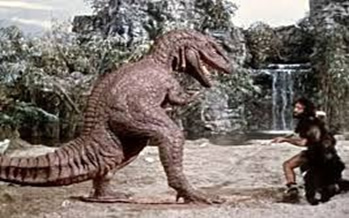
One Million Years BC
One Million Years BC was his only remake. The Valley of Gwangi, originally an abandoned Willis O'Brien project, doesn't count, but it was intended as a tribute to O'Brien even though he didn't get a screen credit. 'He started that in 1942, but it was called off because of the war. They didn't want to invest in a long term picture, so they made Little Orphan Annie instead.'
Following Gwangi, Harryhausen returned to the Arabian Nights with The Golden Voyage of Sinbad, the plot of which incorporated his interest in the supernatural. 'I believe there is a basis for the occult, as phenomena we are not acquainted with scientifically. I find it fascinating to put it into film form. For instance, the homunculus, as seen in The Golden Voyage of Sinbad, is purely an occult concept. Paracelsus was thought to have created a little humanoid figure out of mandrake root and various chemicals. There are all sorts of legends about homunculi. Devil Doll was based on that concept; Bride of Frankenstein had them, and they have always fascinated me.
'But you have to keep magic logical. That's why, in Golden Voyage, Koura the villain had limitations put on his powers. Many films give the magician latitude to do anything he wants. Well, in the first reel he could kill your hero. So we put restrictions on Koura by making him age every time he used his magic. He had to limit it, and it made him human.'
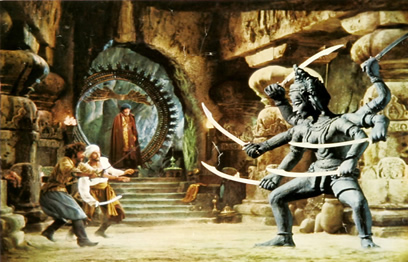
The Golden Voyage of Sinbad
Clash of the Titans, Harryhausen's last and most costly film, also had the best cast of any of his features, including Lord Olivier, Sian Phillips and Burgess Meredith. Previously he had always felt he didn't need big name stars. 'Our stories were concerned with visuals rather than intellectual acting. Also, a lot of actors don't want to take a back seat to special effects. In the same way many actors won't play in a film where there's a child or a dog to steal the scene. To me, it would be a challenge, if I were an actor. I'd like to try upstaging a dummy!'
In any event, to Harryhausen his models are characters, as real as any actor, and on more than one occasion they have taken over. 'There is something about it. It grows, like a homunculus. You become fond of it and try to make it as realistic as possible. It's a study in synthetic movement, an exercise in creating artificial life. I have no God complex! But it's a kind of magic. When you see something like Medusa, with the snakes writhing in her hair, and shooting a bow and rattling her tail, it gives you the creeps. Because you don't quite know how that was achieved.'
Amongst the projects he intended to make at one time was Conan, but it would have been quite different from the film that was actually made. 'We never saw Conan as just a big hulk wandering around slaughtering people. We wanted to make it with more emphasis on the fantastic rather than the muscle-man elements.' He also considered HG Wells' Food of the Gods, and The Hobbit. 'Food of the Gods I would love to have made. I don't think The Hobbit was suitable, although a lot of people thought it was for us. On balance, it was better as a cartoon than it would have been as a dimensional model animation subject.'
Does he keep up with modern fantasy cinema? 'I try to. But although techniques have advanced a great deal I feel the stories have disappeared and been replaced by just a series of events. In our films we kept the heroes clean-cut. In the sixties the anti-hero became prevalent, and I think that's why we are facing up to crime today. We have no heroes to worship. We tried to have a hero, and not an anti-hero who beats up old ladies and takes lollipops away from children. Films are getting more gory. Producers are scraping the bottom of the barrel in order to shock you out of your socks. Actors are even resorting to vomiting on each other. Who wants to see people going to the bathroom? Who wants to see Jack Nicolson puking on people in church? It's shocking, yes, it brings in tickets, but I wouldn't call it entertainment.
'I think that one day, when historians tackle this period of history, they will find we are going through another decadent period, what you might call a dark age. Films, being popular culture, reflect and encourage this.'

Earth vs the Flying Saucers
But we are unlikely to see further contributions to that popular culture from Ray Harryhausen. 'I've retired from making films,' he says. 'It takes too much out of my life. It was a religion with me in a sense and I just can't devote the time any more. I've made seventeen features and I've got to see my family, not spend another two years in a dark room putting a picture together, then have some critic say, “Well, it wasn't very good”.'
He doesn't regret things he didn't do, projects that never happened? 'I did practically everything I wanted to. There are a few things I'd like to do and, if the right script came along, maybe I'd fall for it. But I don't know. At the moment I'm doing a lot of travelling to exotic places I've always wanted to visit, and I enjoy going to conventions and talking to young people. They seem to have a great regard for our films and it's fun discussing them.'
PHOTOGRAPH OF THE MONTH (53)
I would like to have bought these. But I'm sure my wife, Anne, would have said that was another fine mess I'd gotten us into.


A short update this month as duty calls and all that. But here's a quick name check for ...
Novacon is the UK's longest-established science fiction convention, and this year's gathering, the fifty-second, will take place 10th-12th November at the Palace Hotel, Buxton.
Covid saw the postponement or cancellation of many conventions over the past couple of years but things seem to be picking up again. Novacon's one of our favourite events and we're planning to attend this time.
All details here.
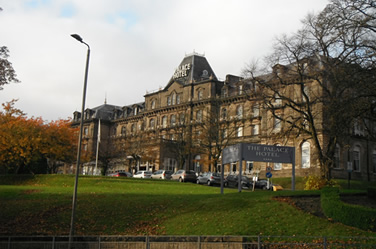
The Palace Hotel, Buxton
PHOTOGRAPH OF THE MONTH (52)
The Library of Birmingham began construction early in 2010, at a reported cost of £188.8 million, and opened on 3rd September 2013. It's always been a controversial building, generating strong feelings for and against. I love it. I really like its boldness and eccentricity, and how it appears to defy gravity, as seen here. The interior's innovative too.
It's certainly a vast improvement on the brutalist concrete monstrosity it replaced in my opinion.
You can view all my Photographs of the Month, from January 2019 to the present, in the Photo Gallery here. I also regularly post photos on my Facebook page.
Next month's update should be more substantial, and possibly contain another archive interview, given that my interviews with Joe Pistone/Donnie Brasco, Robert Jordan and Stan Lee posted here in recent months seem to have gone down quite well.
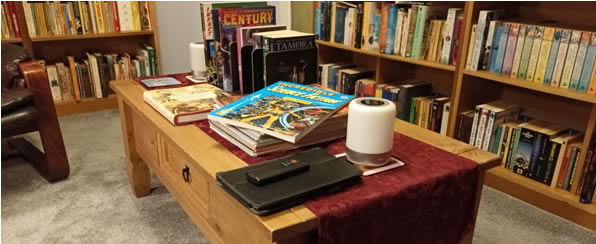

“FACE FRONT, TRUE BELIEVERS!”
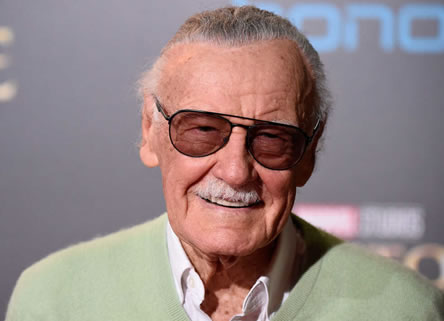
My interview with Robert Jordan last month seemed to go down fairly well, as did the one with Joseph Pistone (“Donnie Brasco”) in the June 2022 update, so I thought I'd post another. The following interview with Marvel supremo Stan Lee appeared in UK's Fantazia magazine issue 18, cover dated November 1991, which after so long I guess qualifies it for an airing – and I've reinstated a few passages that were excised at the time because of length considerations.
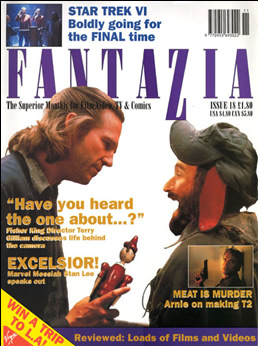
The main challenge when interviewing someone like Lee, who'd been profiled numerous times before I got to him, is what you can ask that he hadn't already been endlessly questioned about. And there's always the risk that going over well-trod ground yet again might solicit cliched or less than enthusiastic answers. I needn't have worried. Stan Lee was an exemplary interviewee, a polished anecdotist, and if he was wearied by my questions he certainly didn't show it. He was funny, too. He was tickled that we shared the same first name, and when he found out that my girlfriend at the time was called Joan, which was also his wife's name, he thought it hilarious. “Okay,” he said, “I'll be Stan one and you're Stan two. The girls can duke it out for first place.”
I think the title of the piece was something the magazine decided on rather than whatever I called it, but we'll go with theirs:
EXCELSIOR!
ADVENTURES OF A COMIC BOOK ANGLOPHILE
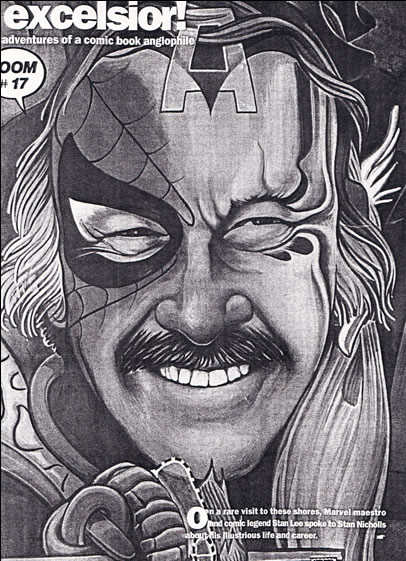
Stan Lee entered the comicbook industry in 1940, when he was just sixteen years old, as assistant to Joe Simon and Jack Kirby at Timely Comics, the forerunner of Marvel. A pretty mind-blowing experience for an ambitious teenager. “Yes, it was,” Lee agrees, “but I had worked before, believe it or not. While I was still at school I had some freelance jobs, including writing obituaries for the Associated Press.
“But I got tired of writing about living people in the past tense. It was very depressing. I went on to write publicity releases for a hospital, and I never could understand what I was supposed to be achieving; were we trying to convince people to get sick so they would go to that hospital?
“Then I saw this ad for an assistant at Timely, although I never thought it would be a steady job. In those days comics were nothing, they weren't thought of highly at all. But I figured, 'Well, it's a living; I'll learn something about how magazines are done then get out into the real world.' I've stayed there ever since.”
In a little over a year he was editing the company's entire line. “What happened was shortly after I came to work there Simon and Kirby moved on. It was such a small company I was about the only fellow left, and the publisher said, 'Do you think you can handle things until I hire a real adult human being?' When you're seventeen what do you know? So I said, 'Sure.'”
Shortly after this he changed his name from Stanley Martin Lieber to Stan Lee. “I started using the name Stan Lee because I felt I didn't want to use my real name,” he explains. “I was saving that for the great American Novel I was going to write. Stanley Martin Lieber was on my driver's licence and my credit cards, but then I started getting credit cards in the name of Stan Lee, because everybody knew me as Stan Lee. Sometimes I'd go to a store to charge something and they'd say, 'What name?' and I'd say 'Stan Lee' and they didn't have that, so I'd say, 'Oh, try Stanley Lieber', and felt like an idiot. It became so confusing that finally I legally changed my name. I'm sorry I did it because Stan Lee is such a dumb name. People say to me, 'What's your name?' I say, 'Stan Lee', and they'll say, 'Stanley what?' Now I'm thinking of changing it to 'What'.”
Cut to the early sixties. The industry is moribund and Lee is thinking of looking for a new career. “Oh, I was going to do that all the time. I got married at about twenty-five, and I kept thinking, 'Now I'm an adult and a married man how can I be in the comicbook business?' I would say to my wife, 'After the new year I'll quit.' Then I'd get a raise or we'd publish some new books I'd be interested in and I'd say, 'Next year I'll quit.' I was always aiming to quit and write that Great American Novel or a movie or something. All the time I was there I never thought I would stay.”
In fact it was his wife, Joan, who in 1961 pushed him into a decision that was to prove historic. “That's when I finally, really was going to leave. She said, 'All these years you've been saying you wanted to do stories the way you wanted to do them. You're going to leave anyway, what have you got to lose? The worst that will happen is they'll fire you.'
“So that's when I brought out the Fantastic Four, and tried to make it what I thought of as more realistic. The characters would act toward each other the way perhaps real people might act towards each other. For instance, instead of the girl just being a token female who was in love with the male but doesn't know he's really a hero, she knew damn well who he was, and she was a member of the team also. She wasn't just some helpless girl always screaming, 'Save me!'
“I made the Torch a teenager, but instead of the typical teenager who follows the heroes around I tried to make him somebody who's pretty independent. In fact he didn't particularly want to belong to the team. He though, 'Hey, I'm not getting paid enough,' or, 'I want to go out and polish my car and meet some girls.' So I tried to be realistic about it. The older readers started buying the book and they considered it satire. I discovered I was a great satirist, and I didn't even know it.
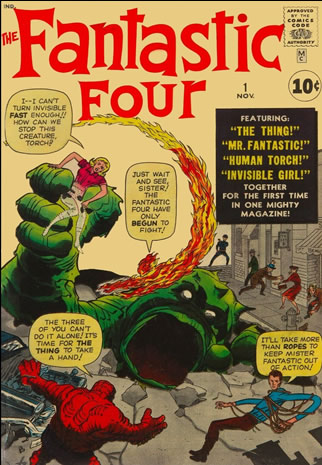
“We had four characters, and you were always trying to get a lot of variety. So okay, we had the good-looking hero, we had the young boy who's also good-looking, we had the girl. What about a real ugly guy who was a humorous, sympathetic monster? The Thing I guess was one of my all-time favourite characters. I loved doing his dialogue, I loved having him argue and fight with the Torch, and tell Reed he was the biggest bore in the world, and why can't he use one word instead of twenty? I adored him because he was so grumpy and irascible. Kind of like me, I guess.”
At the time, did he regard the Fantastic Four as just another story? “Oh that's right; I didn't think it would be anything special. I was just getting it out of my system because I thought I'd be fired. I didn't even think about it once it was out of the way. In those days you didn't see your stuff as being anything great, you know? Then the sales figures came in and it had sold so well my publishers said, 'Hey, make up something else.' So the next one was the Hulk, and that did pretty well, and they said, 'Do another one.' That was Spider-Man, and we were off and running.
“It was an incredible period. It was as though we couldn't do anything wrong. I don't understand how it happened. It was like something up there just shone down and said, 'We're going to give you two or three years when everything you make up will work.' And most of those titles are still selling amazingly well today.”
Ironically, Spider-Man nearly didn't appear at all. Publisher Martin Goodman was not keen on the idea, and thought spiders too icky a subject. “He said, 'You can't make a hero out of a spider, people hate spiders; and his name sounds too much like Superman,'” Lee recalls.
“Then when I told him I wanted Spider-Man to be a seventeen year-old, he said, 'You can't let a teenager be a hero. Teenagers are always sidekicks, heroes are adults.' He hated everything about it. I had to wait until we had a magazine that was about to be discontinued [Amazing Adult Fantasy] because when you're going to drop a title nobody cares what you put in the last issue. So I sneaked Spider-Man into that and, again, forgot about it. A few months later we discovered it was the best selling book we had ever had. My publisher said to me, 'That idea we both liked, Spider-Man, let's make a series out of it'!”
Lee always hated the idea of teenage sidekicks and stoutly refused to conform to the convention. “The publishers, not just mine but all of them, felt that if you're doing stories for children you have to have a child as one of the main characters so the reader can empathise. I thought that was stupid. When I was young I read Ulysses and there were no little teenage sidekicks in it. I read about Robin Hood and he didn't have a teenage sidekick. Tarzan didn't have one. Sherlock Holmes didn't have one; he had Doctor Watson, a full-grown adult. In all the things I loved there were no teenage sidekicks. The only teenage sidekick I could think of was Robin, with Batman, and I hated Robin. I used to think that if I were an adult superhero why would I want to pal around with a teenager? At the very least people would talk. It's ridiculous.
“You know, I loved Spider-Man because he was very much like me in a way. I had all the wisecracks I thought I would use if I were fighting a villain. I liked getting him into trouble and making it so that whatever happened to him it didn't turn out good. Even if he won, and defeated a criminal, I'd arrange it somehow that the police would think he was in league with the villain or something. It was fun dreaming up those situations.”
One disadvantage of not having a sidekick was that the superhero had no one to talk to and convey plot aspects to the readers. Lee got around this by using thought balloons more than they had probably ever been used before. “He [Spider-Man] was always soliloquising, and the reason was of course that there was nobody else for him to talk to. He was kind of his own sidekick.. By putting in all those thought balloons you felt you knew him much more than another character who's saying, 'There goes the crook, I'd better catch him before he gets away.' With Spider-Man you knew what he was worried about and dreaming of.
“I felt the perfect formula for these stories was to take a fantasy angle and make the reader accept it. Like you have to accept that a guy could be bitten by a radioactive spider and then crawl up walls. But, assuming there was such a person, what would his life be like in the real world? How would he react to girls? What would happen to his school work, his family problems? How would he make a living? Wouldn't he still have to worry about acne, dandruff, in-growing toenails, allergy attacks? It made the character seem real to the readers. Suddenly they were reading about a hero who had personal problems. You never read of Superman or Batman having personal problems, or not until after our books became popular anyway.”
One of Spider-Man's achievements was to help soften the draconian Comics Code when Lee decided to write a story about drugs in issues 96-98. “What happened was I had a letter from the Office of Health, Education and Welfare in Washington DC, recognising the influence Spider-Man had on the youth of America, and asking if I could do some anti-drug stories.
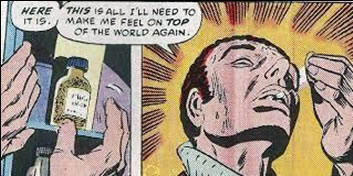
Well, I don't like to lecture or seem as though I'm preaching, so I wove the theme into a regular story. I know nothing about drugs. I've never taken them and know less about them than anybody, so I couldn't get too technical. So I just had a guy, a friend of Spider-Man, and said he had overdosed on something. I'd read that when you take a trip or whatever they call it sometimes you think you can fly. So he was on the edge of the roof and he said he was going to fly, and Spider-Man of course saved him just in time, and said, 'You idiot, what are you doing that for?'
“When I sent the book to the Comics Code Authority they said, 'You can't use these stories because they mention drugs.' I said, 'But they're not telling kids to take drugs. I did this because a branch of the federal government asked me to do it.' 'Sorry, you can't mention drugs.' So I figured these people were crazy and just ran the stories without the comicbook code seal of approval on them.
“We got a lot of affirmative reaction from teachers and social workers in the United States. They loved it. But we also got headlines like, 'Comics Code Authority in dispute with Marvel Comics over drug issue.' Somehow those headlines made it look as if we'd published a drug book and the Code was trying to stop it. But it turned out pretty good actually, because after that the Comics Code got a little more lenient. They realised that mentioning drugs isn't bad if you're trying to tell kids not to take them.
“Actually, without the seal, the books sold better. People have asked me if I've felt inhibited because of the Comics Code, and I say no, because all that the Code provided was we shouldn't be too sexy or too violent, or insult established institutions. I had no intention of doing any of those things.”
Most of Marvel's success, Lee contends, comes down to hard work and, perhaps even more importantly, the ability to adapt. “Years ago, when I was doing a lot of editing and hiring writers, I remember one guy coming to me who wanted to write for us. I said, 'Great, I have a western story I need a writer for right now; you can try that.' And he said, 'I don't write westerns. I just do mystery stories.' I said, 'Wait a minute. In comics you write everything. A story is a story.' In a mystery story you write, 'Follow that car!'; in a western you say, 'Follow that stagecoach!' In a mystery you say, 'Put down that gun, you rat!' In a western you say, 'Drop that gun, hombre!' A story is a story. You have a guy who wants to do something bad, you have a hero who wants to stop him. Either he rides a horse or he rides in a car; he wears a cowboy hat or he wears a cap. I used to write everything. I wrote romance, westerns, humour, war stories, on and on. I didn't consider myself a war story writer or a western writer. I never thought, 'Gee, now I've got to write a science fiction plot.' You just did it. Whatever had to be written, you wrote. When you're writing fiction it seems to me you should be able to write anything.”
Believability is another vital ingredient. “I think you have to believe it when you're writing it,” Lee maintains. “When I read Sherlock Holmes I knew he was a fictitious character but I believed in him. I knew there was no Tarzan, but while I was reading it I worried about him, I hoped the lion didn't eat him up. I think we all do that. It's the same when you write; you have to believe it while you're writing it even though you know it's not for real. In fact, not only do I believe in it but my wife used to come in when I was writing and say, 'Who are you talking to?' She'd laugh because I'd be acting the dialogue out loud. If I was Doctor Doom I'd be saying, 'Oh no you don't, Richards!' If I was doing Thor I'd be Odin and I would say something like, 'Thou shalt not and I have spoken!' I got into the mood of the thing all the time.
“I lived in New York and most of the artists and writers did, so by basing the stories there we could make everything as real as possible. That was another little trick. We were one of the first companies to mention real places and things. Like, Johnny Storm didn't drive a Whiz-Bang V7, he drove a Chevy Corvette. When they went to the movies they didn't go to the Bijou, they went to Radio City Music Hall. Peter Parker lived in Forest Hills, and Tony Stark had his mansion on 5th Avenue facing Central Park. The characters lived n New York. They didn't live in Gotham City or Metropolis or any other phoney place.”
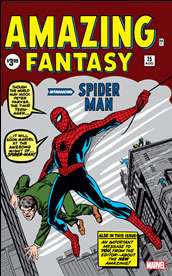
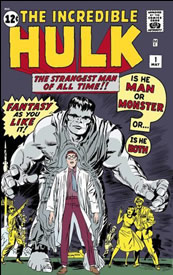
Finally, Lee says, you have to surprise the reader at every opportunity. “If you know what's coming how can you enjoy the story? It's the anticipation, the suspense. That's why Alfred Hitchcock was such a good director; you never knew what was coming next. Of course you try to do that in your stories also. But it's something very difficult to do because you can't have the hero do something totally against their nature just to surprise the reader. It has to be something logical and possible. So to do it correctly you must know your characters.”
He looks back to the pioneering days with affection, even if they were tough. “Nobody was making much money in those days. It was not a highly paid profession. But I think we all had fun doing what we did. There was a lot of kidding around and joking, but there was also a lot of tension because we lived with deadlines. We were always worried if a book was due on the 15th of the month and here it was the 12th and we hadn't even started drawing it yet or something. If a book was ever late it was very serious because the publisher paid for the printing time in advance - whatever it was, $20,000, I don't know - and if it wasn't there to send to the printer he still had to pay the $20,000. So it was a combination of a lot of fun, a little like a college dormitory, and this never ending tension and pressure making sure books go out on time.”
These days his function is quite different. “I'm no longer involved in the day to day operation, but I still stay in touch; I talk to the editors and the people there and I look at the books to keep up with what's going on. But really I spend all my time on the movie and television projects. I live in Los Angeles and work with producers, directors and screenwriters, which is incredibly glamorous and exciting to me. All the people I have read about for years I now meet, like Francis Ford Coppola, people like that.
“Oh, in case you don't know it, there's going to be a Spider-Man movie, and it's going to be written, produced and directed by James Cameron, who did the Terminator movies. Jim wants this to be a bigger movie that Terminator 2. He told me, 'Stan, I've wanted to do Spider-Man for years.' I just met with him before I came out here to London and I'll be meeting with him again when I go back. He's really the best action director in the business, and I think it's going to be the biggest thing ever for Marvel.”
[An intriguing might-have-been that of course never happened. It's interesting to think how Marvel on screen might have gone had Cameron helmed a big budget Spider-Man project.]
NOTE: Some concluding comments concerning possible forthcoming Marvel UK titles (most of which didn't materialise) have been cut.
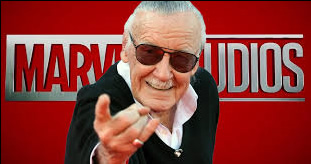
It goes without saying that there are few deeds, no matter how heinous, I wouldn't undertake in order to write for Marvel. Well, actually I once did …
OK, it was young adult and an adaptation of an animated TV series, but I got to play with Spider-Man. Spider-Man!
PHOTOGRAPH OF THE MONTH (51)
There's something rather sad, and perhaps slightly spooky, about supposedly fun objects like this being stored over Winter. Dormant, silent, waiting for the light to return.
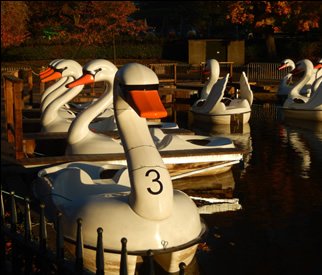
On balance, I think I prefer a more surreal take …
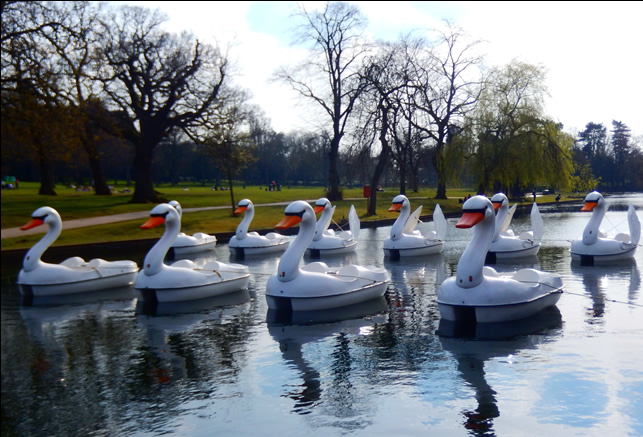
A REMINDER

There's more to this website than you might have noticed. Departments include my Biography, a Bibliography, Photo Galleries and a News Archive going back to 2008. Why not hit the menu at the top left and explore.?

THE WHEEL TURNS

In London, on 11th November 1993, I interviewed Robert Jordan, bestselling author of fantasy series The Wheel of Time. Due to circumstances beyond my control – just one of those perils freelancers often encounter at the hands of contrary commissioning decisions – the publication I believed would run the interview didn't take it. As I was deep into writing a book at the time, along with other commitments, and the interview hadn't even been transcribed at that point, I put the tapes aside with the intention of finding another market at a later date. What with one thing and another I never got round to that. For years, decades in fact, those tapes sat in storage, half forgotten.
I've finally written up the interview, which has never been published anywhere before, and with apologies to Robert Jordan's memory for the delay, here it is:
AN ANTIDOTE TO SPUN SUGAR FROTH
An Interview with Robert Jordan
“I've often said that if you want your child to be a writer make sure that he or she has a miserable childhood,” Robert Jordan says. “Put the child under as much stress as possible. I don't mean child abuse and beatings or whatever, but make sure this child is under as much stress as possible from the day of birth until the day he or she finally kills someone to get out.”
He's kidding, of course. His childhood wasn't miserable, but it would be fair to say it was out of the ordinary, and stressful in its way. Born James Oliver Rigney in Charleston, South Carolina, the author whose epic fantasy series The Wheel of Time would sell over 90 million copies worldwide was by his own account a precocious child. “I taught myself to read when I was three or four,” he recalls. “I was into Mark Twain and Jules Verne and so on, and I had my own public library card by the time I was six. That gave me access to the children's section, and when I looked around at what they expected six and seven year olds to read I thought it had to be some kind of a joke. If you've just read 20,000 Leagues Under the Sea you're not going to settle down to The Velveteen Rabbit for God's sake.”
He found respite in the reference section, the only other area of the library children were allowed to enter. “In there I managed over the next few years to read my way through the Encyclopedia Britannica, the Encyclopedia Americana and a number of other reference works. But that was only because I was kept away from where I really wanted to go, which was to dive into the adult fiction area. Eventually I figured out a way to sneak in there, and I would grab two, three, four books at random and hustle back to a small room near the children's section where I could sit and read. And if I discovered a really good author I liked I'd try to get my hands on everything they'd written. I kept this subterfuge up for years.”
The stressful aspect came from something recognisable to anyone, including many writers, who in their younger years are of above average intelligence and maybe a little eccentric: being considered an oddball. “Looking back I suppose I was a very odd combination of the sort of childishness you expect and rather disturbing precociousness. I can remember saying things and making observations, very adult observations, about situations around me or things I'd seen in the paper as young as five or six. My parents quickly became used to it, but other adults would either say, 'Oh, how cute he is' or else they would look at me very oddly, and sometimes someone would ask who had told me that. A couple of friends of my mother thought I was pretending to read the newspaper.” Other kids picked up on it too. “It gave me I think a certain sense of isolation, of separateness. Because I was separated by this from those around me. I was separated from everyone.”
When he was ploughing through that library, or reading any books he could get his hands on at home, Jordan came to a realisation. “At eight or nine you're starting to think what you're going to do when you start writing. To find the point where you said 'I'm going to write one day', that I don't know. I simply knew that I was thinking about the fact that one day I would write. But even then I was fairly sensible; I knew that very few writers made a living from writing. So I was going to have a profession, and I would one day write on the side when I had become successful at my profession. One ambition about a profession was that I intended to be a career army officer, until I discovered that I wasn't going to make it to West Point.”
But he did serve as a helicopter gunner in Vietnam, returning with the Distinguished Flying Cross with oak leaf cluster, the Bronze Star with "V" and oak leaf cluster, and two Vietnamese Gallantry Crosses with palm. Back home in 1970 he studied Physics at the Military College of South Carolina, known as The Citadel, graduating in 1974 with a Bachelor of Science Degree. After which he worked as a nuclear engineer for the US Navy.
He finally began writing in earnest in 1977. His authorised novels continuing the adventures of Robert E Howard's Conanwere well received. He also wrote a western (Cheyenne Raiders) under the pen name Jackson O'Reilly and historical fiction (the Fallon series) as Reagan O'Neal, among other pseudonymous works.
Did his background in the military, and in Physics and Mathematics, prove useful in any way when it came to writing fiction? “In many ways. Mathematics certainly teaches you about structure. Physics does to a certain extent, although a lot of modern physics is approaching Theology really. I was talking to some physicists recently, I mean true physicists with PhDs, not a Bachelor of Science like I have, and after a while I realised that I was talking to high priests discussing mysticism, and it really was mysticism. And it might even be the truth for all I know!” He laughs. “But Maths and Physics teach you about working things out, about how things are put together, and it does help in putting together the books. That and my reading over the years, which has been voracious to the extent that I read between four hundred and five hundred books a year, meant I began to be able to build a society or a language and have people believe that this society or this language could exist. People who know about these sort of things have told me 'Yes, this is a recognisably viable society in the way it's structured and yet it's different from what we're doing, but all the rules and customs and things fit together in a very real way.'”
And his military experiences? He reflects before answering, “I think the only thing the military really gave me was the knowledge of what it was like having someone trying to kill you, and to know what it is really like to kill someone. And to know what it's really like to be absolutely certain, one hundred percent convinced, that you're going to die in the next 30 seconds. I think that I can convey those things to some degree because I've experienced them.” To clarify, Jordan did not claim to have killed anyone during his time in Vietnam, although he could well have done so as a result of being a gunner. But he did see the bodies of friends and foes, up close.


Why choose fantasy as a vehicle? “Well, I have written books in other genres under various pen names, and I've ghosted books in other genres.” One of those ghosted books was apparently a bestseller in the thriller genre, credited to a noted author. That's all Jordan will say about it. Given that the real writers of ghosted works are usually restrained by confidentiality clauses in their contracts his reticence is understandable. He's content to let readers play a guessing game in this instance. 'But when it came to The Wheel of Time,” he says, “I always dreamed of writing what I liked to read, and I do like fantasy. You have to shape a book to two things: the story you want to tell and the things you want to talk about, and the story I wanted to tell in The Wheel of Time was particularly suited to fantasy.”
“If you've read the books,” he adds, “you'll know there's more than one storyline and more than one main character. That major, major storyline is along the lines of what is it really like to be tapped on the shoulder and be told that you are the saviour of Mankind. Oh yes, and that at the end of it they're going to nail you up on a cross. That sort of thing lent itself to fantasy, and some of the other thoughts that came to me lent themselves to fantasy. About cyclic natures that turn up again and again, for example, and the greatest exemplar of that is the Wheel of Time itself, with any point being both in the future and in the past, depending on which way you look. There's the concept that these people we see, these characters, are the source of our legends, we are the source of theirs, and that did lend itself well to fantasy.”
While keen to express certain ideas in his work he doesn't want his books to read like polemics. “I don't like putting themes and discussions up front. I don't like anybody to say, right off the bat having read my book, 'This book is about the struggle against evil and how far can you go before you become as bad as what you are fighting. But on the other hand how far dare you hold back if holding back means the victory of evil.' Because the point I'm trying to convey, although not overtly, is about the distortion of information and the fact that no one ever knows the entire truth, and that even if something happened yesterday and someone you consider to be a reliable reporter comes and tells you about it you have not heard an actuality. You've heard something that's been filtered through their perceptions. If you were there you know the truth with a hundred per cent confidence of what you actually saw. Anything else you can only have a ninety-nine point whatever, at best, level of confidence. So how much more degradation of information do you get if something happened a hundred years ago? Something that has been through the hands of three or four revisionist historians. Or that happened a thousand years ago or three thousand years ago and has taken on the trappings of myth. Those things are inherently there in the Wheel of Time books. The thing is I'm not trying to make anybody come to any particular conclusion about most of these questions. Even questions I feel strongly about. The idea is to get people to think about these topics and let them come to their own conclusions.”

How long were the ideas behind The Wheel of Time germinating? “It was about ten to twelve years between the first thoughts and actually putting words on paper. There was a great deal of change, in terms of both plot and characters, during that time.” Given the complexities of the plot and the range of characters, was it originally conceived as a trilogy or a series? “My conceit was such in the very beginning that I really thought I could do the bloody thing in one book. I really did, and I was killing myself figuring out how to fit it into one book. It seemed to be a great deal of work but of course I thought I could do that. But by the time I got to my publisher I'd gotten a little more realistic and thought it could be three or four books, or maybe five. By the time I was into the second book I was saying maybe it would be six. Now I'm working on six and I think I can finish it up in seven. I do know the final scene though. I could have written that final scene five years ago, and when I do come to it there will only be very minor changes.”
It's hard to talk about fantasy without bringing up JRR Tolkien and the long, enduring shadow he's cast over the field. “Oh yes, definitely,” Jordan agrees. “If you'll forgive me for mixing my metaphors, he's both the plinth in the middle of the plain that none of us can ignore and also the foundation on which we're all building.” Would it be fair to say that Tolkien's influence could be seen as both benign and somewhat restricting? “In a way, yes. He gave fantasy at one and the same time possibilities, literary possibilities, artistic possibilities, and recognition of the form, but in many ways he drew a boundary around the field. So that it took a great while even to begin to edge out from Tolkien. Fantasy was Tolkien, and to a large extent people were very carefully staying in his shadow, because that was what fantasy was. I'm not saying they were copying Tolkien, but that's where fantasy was, and it stayed under his influence, if you will. It took a long time for people to move away from that. He just dominated the field to that extent.”
When some people initially referenced Jordan in relation to Tolkien, positively and negatively, his feelings about it were mixed. “Yes, it happened quite often in the beginning, especially after the first book. Because in the first book, maybe in the first hundred pages or so, it's very pastoral and in some ways, without trying to copy the style, very much a homage to Tolkien. I was saying this peaceful place that we're in, this peaceful part of the world, this ground you walk, you are familiar with. Because Professor Tolkien took us there. Then I said okay, now the roller coaster ride begins; I'm going to take you where you've never been before. I did do that quite deliberately to try to invoke him to some extent. Perhaps with a good deal of success because a number of reviewers said things like that. They called it something like 'The definitive exploration of Professor Tolkien's territory, but this century',” he recites from memory. “'The American Tolkien', someone called me. There were lots of reviews comparing me to Tolkien. My publisher of course loves Tolkien, so he immediately started using these quotes in all the advertising. I tried to stamp on it but they would pop up again. I think I've managed to get rid of them finally. It's very flattering, it really is, to have that comparison. But I'm not Tolkien. I'm not trying to copy Tolkien or imitate him. I'm trying to be me. Please stop saying that I'm some sort of Tolkien clone or imitation because it's going to mislead people. What I do is not to be seen in any way as a pastiche, or a homage to the extent of copying his style or content. I have my own values, my own background. My life is different. I come from a different place than Professor Tolkien, I've lived a different life. I see the world through a different set of eyes. There's no way I could write a book that would have the same values and express the same viewpoints. I'm very thankful for his books. The Lord of the Rings certainly. The Rings trilogy is stunning. I will admit subversively that I have never enjoyed The Hobbit. The trilogy is so wonderfully, exceedingly adroit that you forget that it is at its heart a children's book. But Tolkien did not give that depth to The Hobbit.”
Without claiming comparisons, Jordan sees himself as firmly within the same ancient storytelling tradition as exemplified by Tolkien. “I come from a family of raconteurs,” he says. “I have always told stories. I have in fact said before that I feel this direct line from me to a storyteller squatting in a village square somewhere with a begging bowl in front of him. If he tells a good story the villagers will fill the bowl with soup and give him a piece of bread, and maybe a place to sleep tonight. But if he doesn't tell a good story he's going to have to move on and sleep under a bush, hungry. I feel a direct link between myself and that person.”
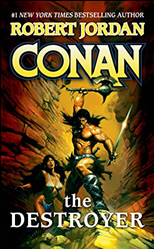
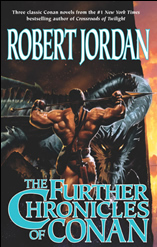
So Jordan's saying that he sees himself as a purely commercial writer, albeit rewarded with somewhat more than soup and bread? “I think you have to look at my kind of writing as a sort of meeting place between art and craftsmanship. If you go too far toward looking at writing as an art it seems to me that you enter a realm of emptiness. Writers who say, as I've heard many say recently, that plot and character and dialogue and story get in the way of the writing and should be dispensed with … well, I've read some of their writings and they have done that. And they're left with exactly what you'd expect them to be left with. There may be some beautiful words in there but they don't qualify as poetry. What they qualify as is spun sugar froth. It might be pretty to look at for a moment but it falls apart as soon as you touch it. If you go too far toward craftsmanship it's better than going the other way certainly, but going too far that way you produce in effect what amounts to purely writing for the pleasure of the public and you give the public whatever the public wants, whatever the fans want. If they want you to write the same book over and over again, that's what you do. If they want you to write books that have more sex or more violence or less sex or less violence than you would like to write, then that's what you give them. If they want you to be cute when you'd rather be grim or grim when you'd rather be cute, you give them that. You can call it whoring if you want to, but many people who do this are very good writers, but they have strayed purely into the realm of being a craftsman. And a pure craftsman is at the beck and call of whoever gives them a coin. It seems to me you have to find that balance point between the art and the craft, and weld them together if you can.”
The flow of story is vital for him. “But so is the flow of the words and each individual sentence. The way the storylines flow together is important, almost as if the storylines were physical swirlings of paint. The flow of the language is as if it were a symphony. I sometimes perceive it and feel it in these ways. But at the same time I'm telling a story. I may be trying to make these beautiful blends, these beautiful flowing movements and these beautiful sounds, but I'm also telling a story, and I'm telling a story about people. You have to remember that all the time or you've simply fallen off the path as far as I'm concerned.”
The concept of genres, the labelling of different literary forms, is something he would like not to exist. “I would love to see them disappear. But it's not going to happen. There are writers who abandon labels. They do this, generally, by making their publisher abandon the label. They say 'I am no longer writing fantasy,' and quite often what they're writing still is fantasy, and the book stores quite often still put it right where they've always put it, with the other fantasy novels. I would love to see the distinctions disappear but it isn't going to happen because human beings categorise things. We always have, we always will. Whether it's 'us and them' or 'this and that'.” He'd like to see the end of categories because readers are ignoring books they might enjoy? “Oh, they are. Definitely. But it's one of the things that perhaps doesn't trouble me as much as it should because I do read so many things. Most people don't. I know people who tell me 'I never read genre fiction' and then I look at the books they've read that are mainstream fiction except that I find something that I consider a western or an historical novel or a war novel. But they don't read genre fiction. They at least have a wider range than people I run into who really do stick to one genre, which is what most people do. They read science fiction and fantasy, or maybe they read westerns or they read mysteries or they read war stories or they read historical and they don't touch anything outside.”
Mainstream itself is just another genre, isn't it? “Yes, that's what I'm saying. You can within what's called mainstream find every sort of book. Including books that except for the single fact that someone decided somewhere that this is not a western, this is not a mystery, this is not a horror story, whatever. There's also the issue of authors who want to move into another genre. There's a fear quite often on the part of publishers that the fans will not accept that, so they will try to keep a writer writing that particular thing. Of course a lot of the fans do prefer that particular thing and some of them will complain. They resist. You know, 'You wrote this and it's different.' And if the writer says 'Yes, I meant it to be different, but do you like it?' And the fans say 'It's different!' Readers, fans, can be rigid. Some writers give up under that sort of pressure of course and go back in their box.'
How does this relate to the old writing advice that says write what you know about? Can that apply even to fantasy? “I've always said forget about writing what you know. Write what you like to read. As far as writing what you know is concerned, you can research and learn about anything to a degree necessary to write about it convincingly. You don't have to have been there or lived there to write about it. As far as writing what you like to read is concerned, I'm thinking along those lines at the moment. I'm working in my head on what I'll do after The Wheel of Time. It's certainly past time to be working on what comes next.”
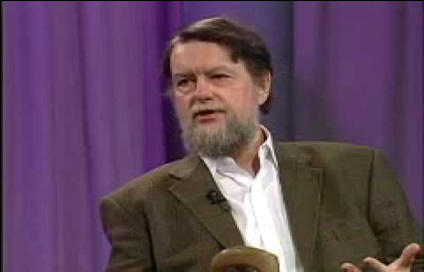
It was not to be. In March 2006 Jordan announced that he had been diagnosed with cardiac amyloidosis, a condition in which so called faulty proteins accumulate in the heart,
impairing its ability to pump efficiently and eventually leading to failure. The prognosis was that with appropriate treatment his life expectancy was four years. In the event, and after what by all accounts was a spirited fight, Jordan succumbed eighteen months later, on 16th September 2007. He was fifty-eight years old.
The Wheel of Time series concluded at fourteen volumes, the last three written by prolific fantasy author Brandon Sanderson, who had been chosen by Jordan as his successor, based on notes left behind. There was also a prequel novel and a companion.
During our interview Robert Jordan expressed the hope that the series might one day be faithfully adapted for the screen. It was fourteen years after his death before that came about, with the TV series based on his books beginning its run on Amazon Prime in November 2021.
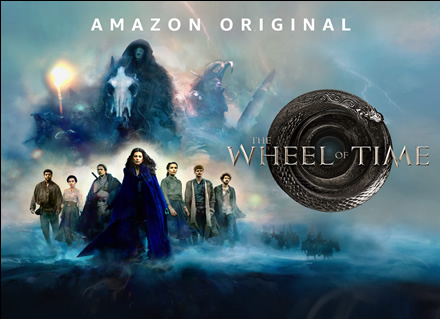
GRAPHIC NOVEL EPHEMERA
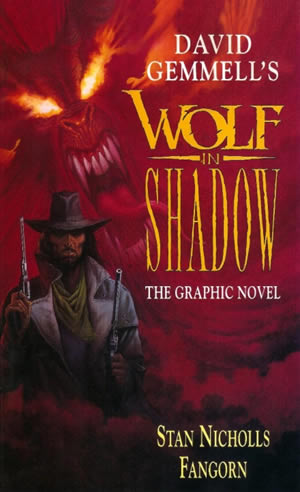
Digging in the dusty archives has turned up some items associated with the graphic novel version of David Gemmell's Wolf in Shadow that I adapted.
Here's the first page of the publisher's press release announcing the Wolf in Shadow graphic novel, Bloodstone, and the paperback edition of The First Chronicles of Druss the Legend, all of which were issued on the same day in 1994:
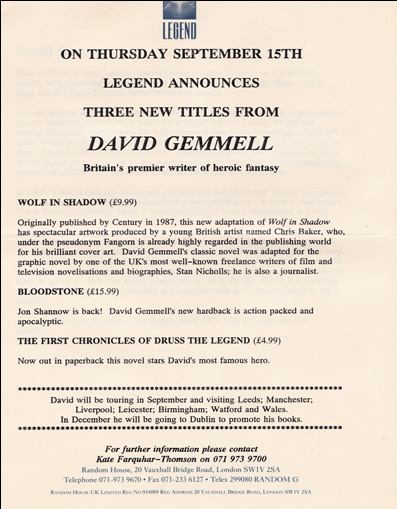
The front and back of a promotional fold-out produced for the book trade:
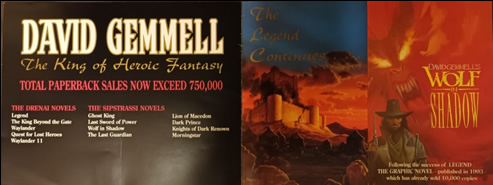

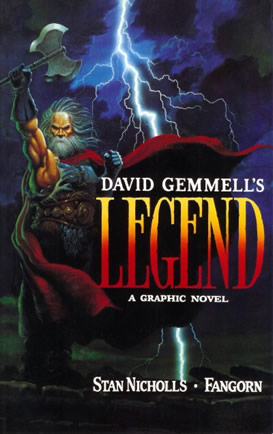
We undertook quite a few signings for the Legend and Wolf in Shadow graphic novels, and here are flyers advertising two such events.
Though considering that I was Forbidden Planet's first manager and had worked there for about five years before becoming a full-time writer you might have thought they'd spell my name correctly …


PHOTOGRAPH OF THE MONTH (50)
I can't believe I've clocked up fifty months of these photos.
I've always had a bit of a thing about masks, though admittedly Covid knocked a lot of the romance out of them. When visiting another country we occasionally bring a mask back as a souvenir, and friends sometimes gift us one from their travels. Here are some of them, from Belgium, France, Hong Kong, Milan, Nepal, Portugal, Spain and Venice.

You can see all previous Photographs of the Month in the Photo Gallery.

THE FUTURE BECKONS
And a happy New Year to all. We can only hope it'll be an improvement on what we've been dealt in the years leading up to this. In that spirit, this seems appropriate:
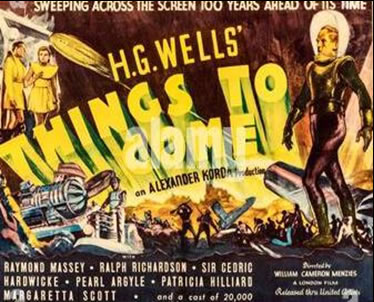
It's also relevant to the next item. Read on.
SOMETHING FROM THE WEEKENDER
Back in 2016 my wife Anne and myself were among the guests of honour at that year's Sci-Fi Weekender event, held at Camber Sands, North Wales.

During that weekend I was interviewed on stage by genre journalist Robin Pierce. I was vaguely aware that the interview was being filmed, but only very recently discovered that segments had been posted on YouTube. These are very short clips, each covering just one question and answer.
In this clip Robin asked about the very first science fiction film I remember seeing. (The poster in the first item above is a broad hint.)
In this one he wonders if I have any advice for aspiring writers.
The two clips amount to just a few minutes, so you wouldn't be investing a huge amount of time if interested.
FORBIDDEN PLANET'S FLYER CIRCUS
We're in the long and cumbersome process of clearing a storage unit we rent and going through a lot of long unopened boxes. One find has been a mass of flyers for signings at Forbidden Planet's original shop in London's Denmark Street during my time as manager there. I tend to be an in the present, looking forward to whatever time I might have left sort of person, not given to overly obsessing about the past (I hope). But I do think this sort of ephemera's important and should be preserved somewhere. The history of the fantastical genres and the communities surrounding them is often to be found in the peripheral items that tend to be discarded. For some time I've been working on and off on compiling an archive of this material which I hope to eventually add to this website. That won't happen for a while, so until then here's a sampling of the unearthed flyers.

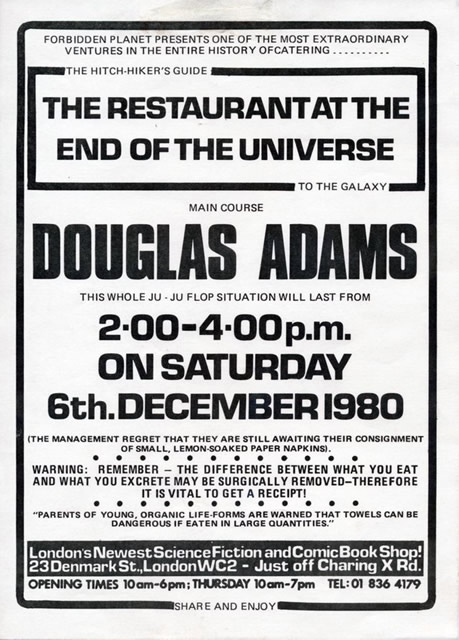
I'm particularly pleased to have helped organise the very first signing Douglas Adams undertook, on publication of The Hitch-Hiker's Guide to the Galaxy novelisation, and again when The Restaurant at the End of the Universe was released. And I'm proud of these flyers that advertised those events.
Here's a fairly random selection of some others:

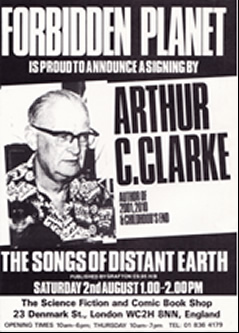
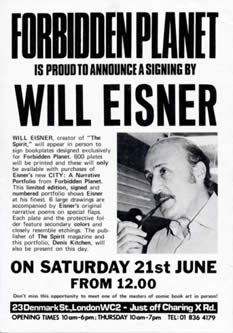
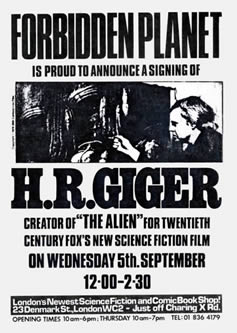
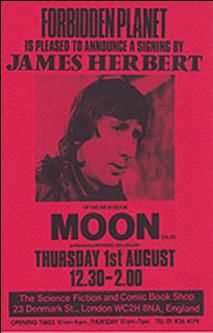
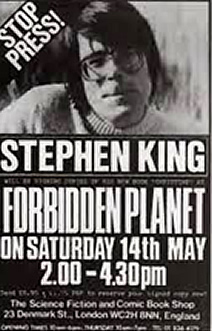
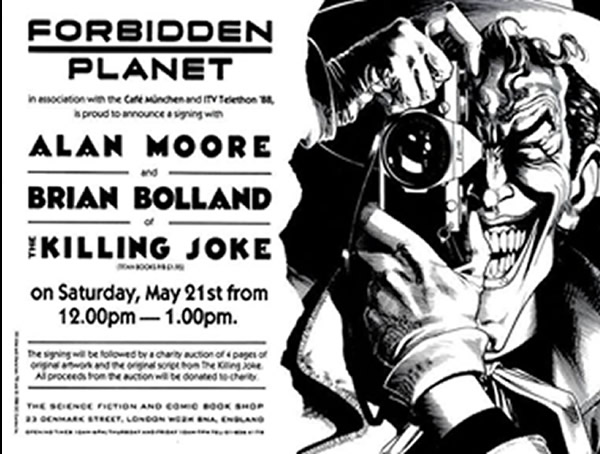
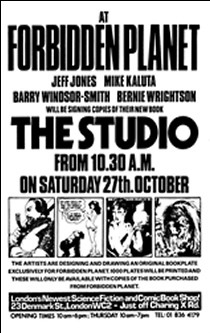
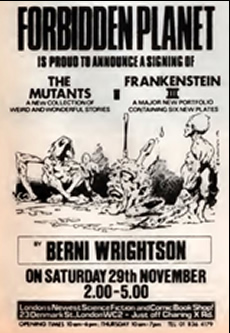
There are a lot more, but I think that's enough for now.
THE STARLOG COMPENDIUM
As a long-time reader and latterly a contributor to the much-missed Starlog magazine, I was interested to hear about this recently published companion:
The publisher's blurb best describes the book's remit:
“Beginning in 1976, Starlog magazine chronicled the science fiction field, taking readers behind the scenes of the films, TV programs, books, games, art, and more. Long before the Internet became the place to learn news about upcoming films and television programs, science fiction fans found this news in the pages of Starlog. And they argued about all of it in the letters pages, long before Facebook or online chat rooms became popular.
“The Starlog Compendium s an issue-by-issue synopsis of the first 200 issues of Starlog magazine. With information on the magazine’s evolution along with a listing of every article in every issue, this compendium is the companion for your Starlog collection - or your guide to accumulating your collection.”
I haven't seen a copy at this time but hope to soon. The Amazon UK listing (paperback and Kindle versions) is here.
ART BY ANNE NICHOLLS
I thought I'd share a piece of art my wife Anne completed on 9th December. It's in acrylics and entitled 'Assyrian Guardian'.
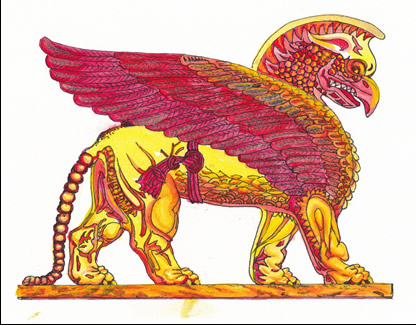
Anne regularly posts work on her Facebook and Instagram pages.
PHOTOGRAPH OF THE MONTH (49)
Regular visitors here will know that I usually post photos relevant to, ie taken in, the month they're posted. Things are so dreary and cold here in the UK at the moment that I thought I'd depart from that and show something more summery and cheering. This is part of the frontage of the house in Spain where my sister-in-law, Janet Calderwood, lived until recently.
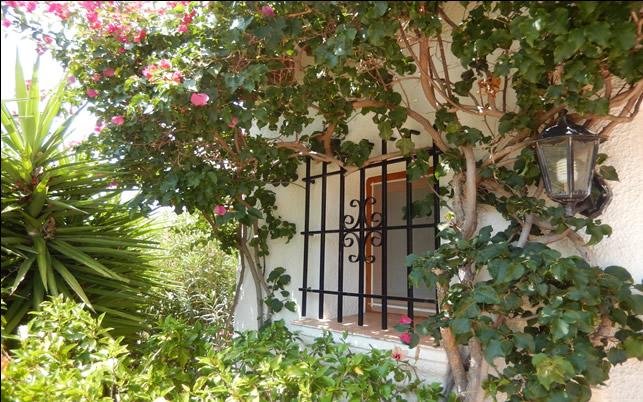
All previous news updates, going back to 2008, can now be found in our News Archive.
And the menu on the top left of this page, or these links, will take you to all previous Photographs of the Month, as well as my Biography and Bibliography (Orcs series, Quicksilver trilogy, Nightshade Chronicles trilogy, Other Titles).
There are also sections on Conventions, Gothique & Stardock and a history of The David Gemmell Awards For Fantasy.
Previous news updates going back to 2008 can be found in the News Archive.
And note that the menu on the top left of this page will take you to my:
Biography, Bibliography (Orcs Series, Quicksilver Trilogy, Nightshade Chronicles Trilogy, Other Titles, Gothique & Stardock Section and Contact tab.
© Stan Nicholls
Web Site by

